HOW MUCH DIFFERENCE HAS 13 YEARS MADE?
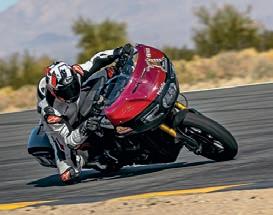





JULY 2023 ISSUE 405 OLDVERSUS NEW THE SUPER-TWIN THAT DIDN’T WIN... BAGGING A GOOD’UN KTM 890 SMT THE WHACKY WORLD OF BAGGER RACING REBOOTED RENEGADE
WHAT YOU NEED TO KNOW ABOUT SUZUKI’S ICONIC TL1000R YAMAHA BMWS1000RR GEN 1 GEN 4

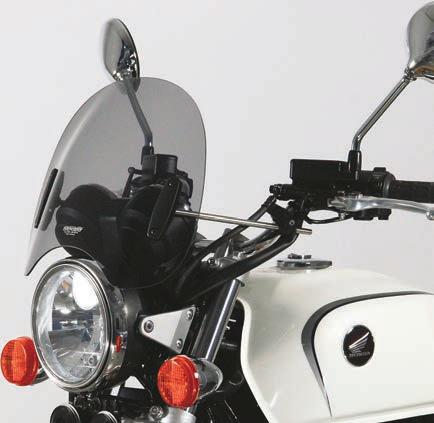


















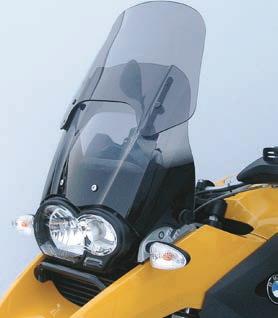


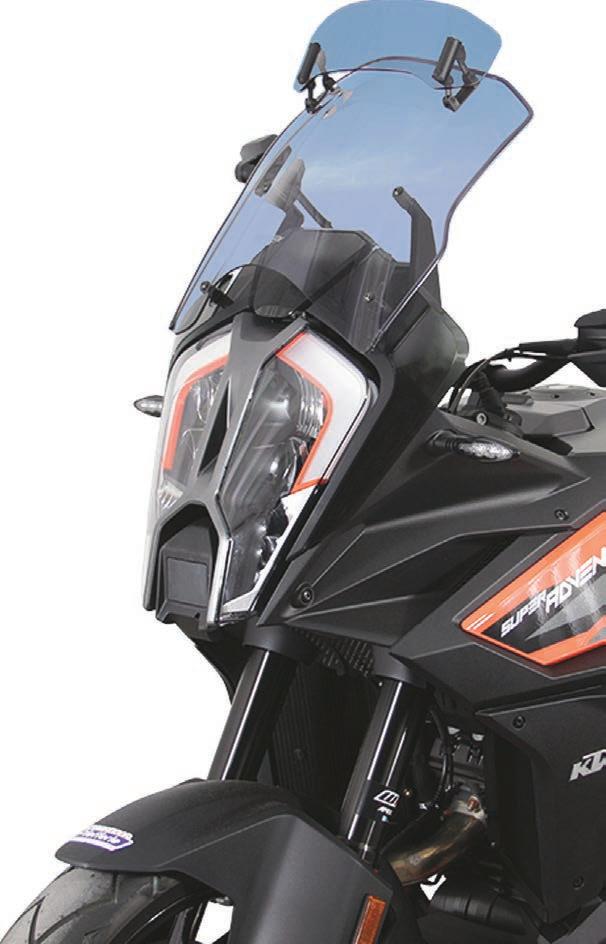












18
To pre-order your next issue of Fast Bikes, head to classicmagazines.co.uk/ pre-order-fb
Alternatively, scan the QR code on this page and order your next copy today. We will send it directly to you!

THE KNOWLEDGE
Used Bike Guide..............................54
All you need to know about Suzuki’s TL1000R superbike.

TESTS
Old versus new...............................18
Just how much has BMW’s S 1000 RR advanced over 13 years? We find out. Rebooted renegade ........................34
We loved KTM’s old SMT… but we love the new 890 even more.
Tour de phwoar ..............................42
Yamaha’s Tracer 9GT+ has just set a new benchmark in the middleweight sports-tourer sector.
COLUMNISTS
Brad Howell ....................................92
Our fitness guru offers more great training wisdom.
Tim Neave .......................................94
With a few rounds under his belt, we catch up with Tim’s superbike shenanigans.

Christian Iddon ...............................96
After a luckless start, Iddon’s season is starting to take shape.
Steve Parrish...................................98
Fresh from the NW200, we check in with the font of knowledge.
FEATURES
Bagging a good’un..........................60
Ever wondered what it’s like to race a bagger? Us neither, but it sounds pretty mental.

R7 Project........................................72
Against the clock, they made it to the NW200. Here what Rutter’s got to say ahead of the TT.
What the Tech: Slipper clutches ....82
This month, the topic is slipper clutches, and we’ve got MotoGP’s Neil Spalding in to make sense of them.
FASTBIKESMAG.COM

ISSUE 405 JULY 2023
GEAR
60 BUY
82

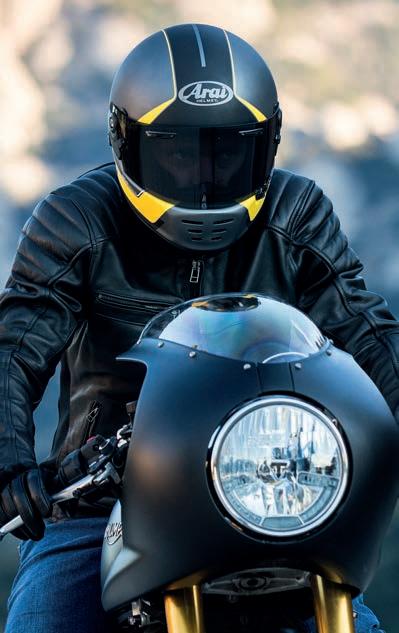




Get on track
If you’re reading this mag, there’s every chance you’ve done a trackday – raced, or at least watched a mate go round and round in circles at such an event. Track riding and sportsbikes go hand in hand like pints of beer and salted crisps. I fondly remember my very first time on track. I was 16, it was at Mallory Park, and I was inadvertently adding another chicane to the stop-start circuit’s configuration. I had the best day ever: my Mito came home in one piece and I was so excited that I booked a visit to Cadwell Park two weeks later… leaving the circuit in a neck brace. In my opinion, riding on track is one of the best experiences you can have, regardless of how fast or slow you are, or whether you’re on a bike with 400bhp or 50 ponies – as long as you’re having fun, that’s all that matters.
If, like me, you can remember how things were back in the early Noughties, you’ll appreciate that the track scene has changed massively. By comparison, it’s so much bigger now, better organised, and the frequency of trackdays has gone through the roof. To throw that heavily used phrase into the equation, we’ve

never had it so good. I myself have been guilty of doing far too few trackdays in recent years, but I hope to make amends this season, getting as many laps in the bag as possible, and I’d encourage you to do the same.
Whether you’re experienced or not, make the most of now because there’s no telling when that scene might start to dry up. In fact, if social media posts are anything to go by, there are already a few cracks in the system and it sounds like trackday organisers are having to carefully consider their calendars and track hire because they’re just not filling the events.
It’s a real shame, and I would like to do all I can to safeguard the future of trackdays, if at all possible. Not just because riding on track is awesome and a great way to experience what your bike is truly capable of, but also because it’s a great place to meet other like-minded folk, share tales, scars, and even cans of fuel if you find yourself short.
No, they’re not cheap. Yes, they can be daunting. But for all the pricy events, there are also affordable dates and tracks to pick from. As for those unsure about riding on track, most organisers offer free tuition from experienced riders. And then there’s the option of hire bikes, too. You don’t have to search all that hard to find credible, fantastic track bike hire services if you don’t fancy taking your pride and joy out for a spin. The point being, with a bit of planning, trackdays can be accessible to everyone, as they should be.
If you’re stuck for advice, or just want a bit more perspective, feel free to drop any of us on the mag a line. We’re not saying you’ll get the best advice, but we’ll do our best!
Enjoy the mag,
Join us on Facebook: Facebook.com/ FastBikesMagazine
Download Fast Bikes: Mortons.co.uk/FB
View Fast Bikes video content: youtube.com/ fastbikesmag
Join us on Twitter: @FastBikesMag




BOSSY MAN
‘Dangerous’ Bruce Wilson bwilson@mortons.co.uk

MONEY MAN
Charlie ‘The Sheriff’ Oakman coakman@fastbikes.co.uk
FAST MAN
Tim Neave tneave@mortons.co.uk
OLD MAN
John McAvoy gramps@fastbikes.co.uk
See page 8 for the best deals, or visit classicmagazines.co.uk/ subscription/FB/fast-bikes
BSB SUPERSTAR
Christian Iddon ...and Britain’s best builder
TRACK RIDING GURU Dean Ellison ...and super nice bloke
TT WINNER
Gary Johnson ...and karaoke king
MOTOGP SAGE


Jack Fairman ...and wine connoisseur
ROAD RACING
LEGEND
Peter Hickman ...and BSB winner

RACING PUNDIT

Steve Parrish ...and pro at pranks




YOUNG MAN

Carl Stevens
SUPERSTOCK WINNER

Tom Neave ...and combine king

SUPERBIKE SNAPPER
Jamie Morris ...and eBay addict
LEGAL LORE
Gavin Grewal ...and hardcore off-roader

SUBSCRIBE!
WELCOME
6 JULY 2023 WWW.FASTBIKESMAG.COM


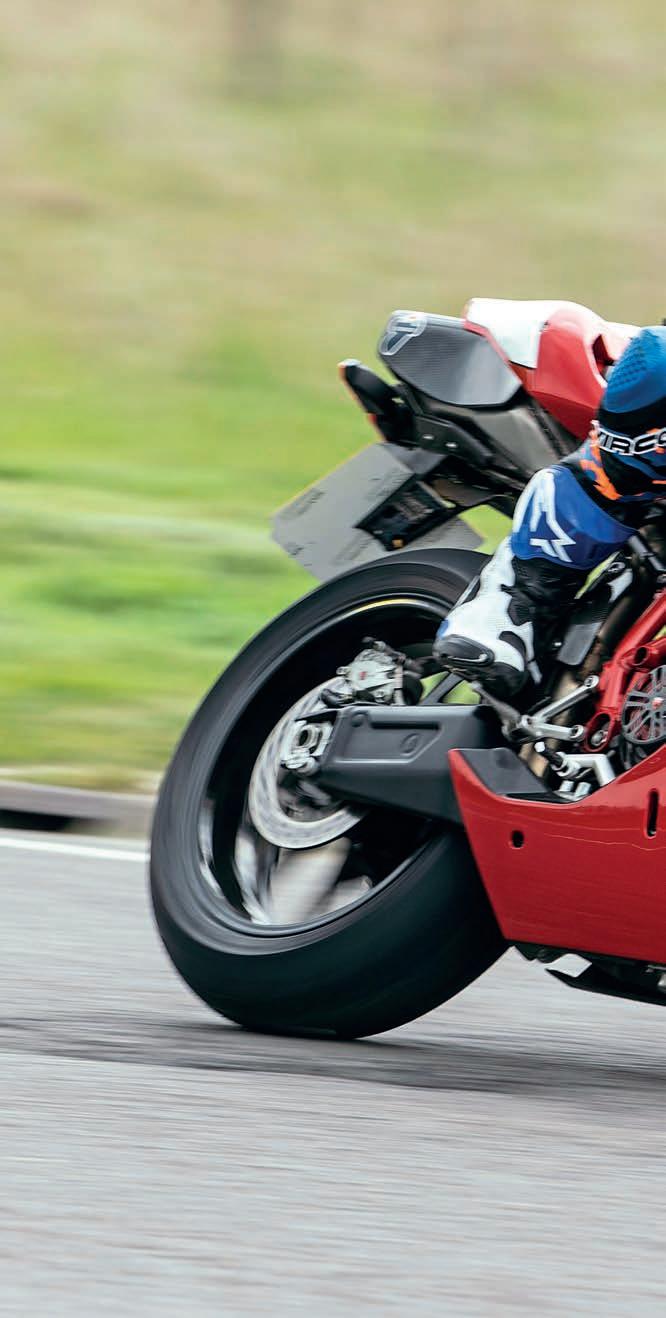

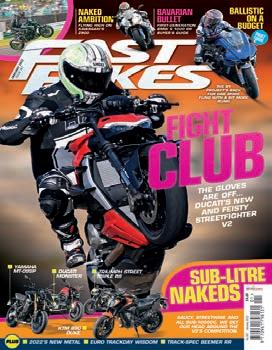
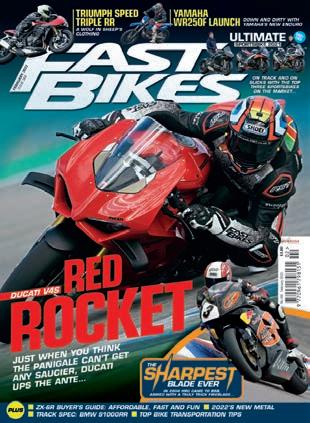
PRINT ONLY DIGITAL ONLY
year FOR £47 Direct Debit
year FOR £50 Credit/debit card
years FOR £95 Credit/debit card 6 issues FOR £18.99
card » 13 issues FOR £35.99
card » Pay just £3.92 per edition That’s a 18% saving when paying by Direct Debit classicmagazines.co.uk/FBDPS
Free UK delivery to your door or instant download to your digital device
Save money on shop prices
Never miss an issue
Receive your issue before it goes on sale in the shops
reasons to subscribe TERMS & CONDITIONS: Rates are based on UK orders only – for overseas please visit www.classicmagazines.co.uk/fb-overseas. Subscriptions will start with the next available issue. Offer closes 04/07/23. Direct debit payments will continue at the price you paid, on this offer, every 12 months thereafter unless you tell us otherwise. Full terms and conditions can be found at www.classicmagazines.co.uk/terms. Quoted savings are based on a 12-issue direct debit subscription when compared to the cost of 12 full-price printed issues.
One
One
Two
Credit/debit
Credit/debit
>>
>>
>>
>>
Great
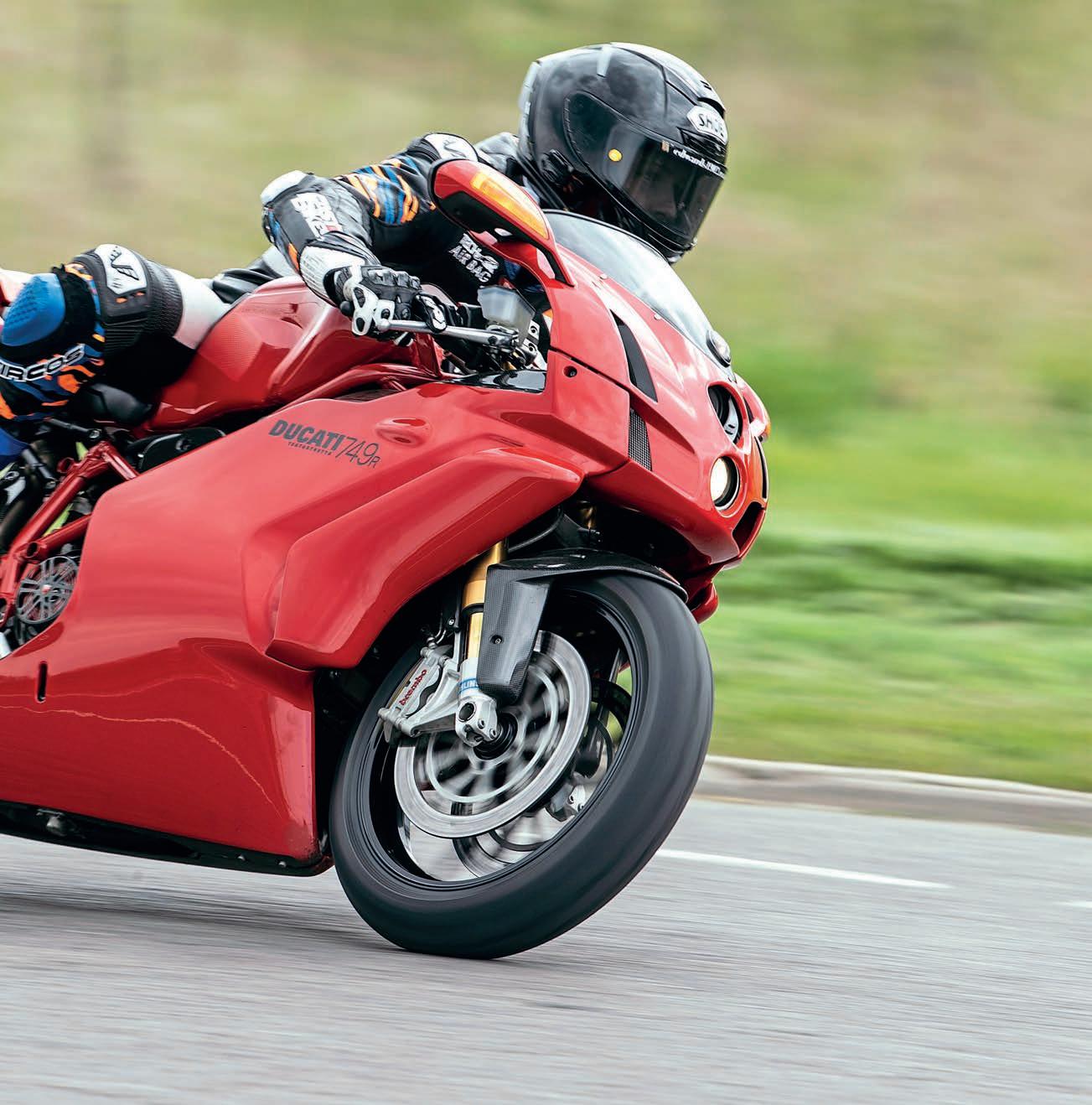

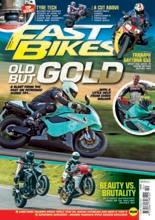
01507 529529 and quote FBDPS Lines are open from 8.30am-5pm (Monday - Friday) SUBSCRIBE ANDSAVE!
WORDS: SIR ALAN OF DOWDS
TEAM CLASSIC SUZUKI GSX-R1000 K1
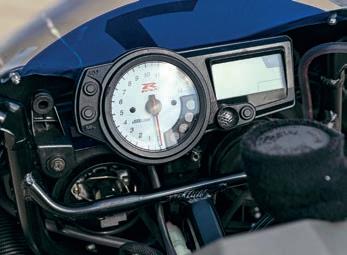

Bored with ugly MotoGP bikes? Tired of BSB machines covered in a million confusing sponsor stickers? Appalled by control ECUs, one-tyre deals and whacked-out aerodynamic hocus-pocus?
No, us neither. But we can definitely see the appeal of simpler times and simpler race bikes – like this Team Classic Suzuki GSX-R1000 K1. It’s been built by the team, backed by Suzuki UK, to take on the European Endurance Cup this year in the classic categories. Because, yes, terrifyingly enough, a K1 Gixxer thousand now counts as a classic. Begad.
The sweet GSX-R follows the team’s luscious GSX1100 Katana (and a road-going GSX-R1000-based Katana), GSX-R750 SRAD, XR69 and RG500 machines, which have graced the start lines at the Manx GP, Classic TT, Island Classic down under and other classic races all round Europe. Built by GSX-R legend Nathan Colombi, the bike is festooned with trick parts including a factory GSX-R750 endurance race swingarm and standard frame, plus the usual high-end race running gear. The forks have K-Tech internals, and there’s a K-Tech rear shock, together with Brembo race four-piston calipers, OZ wheels and Bridgestone R11 rubber.

The motor has been fully rebuilt and uses the later K3 32-bit injection ECU, injectors, loom and dashboard. Yoshimura cams helps the breathing up top, and a super-sweet full titanium Yoshimura RS-3 race pipe makes us

wish it was 2003 again (even more than usual).
The team had signed up Danny Webb and Bob Collins to race the bike for the first round at Paul Ricard. But Bob was ruled out after a big crash at Castle Combe, and ex- Fast Bikes leg end Al Fagan stepped in to help out.

Sadly, after being fastest in qualifying and building up a comfortable lead in the four-hour race, Webb hit some spilled oil and crashed out. Fagan jumped on, but a cooling system fault ended their race soon after.
The bike will be back on track for the next event though: Brands Hatch on July 29/30. That’s Bob’s home track, of course…
WORDS: SIR ALAN OF DOWDS
PLANET FAST BIKES – NEW METAL, NEWS & REVIEWS 10 JULY 2023 WWW.FASTBIKESMAG.COM
DUCATI SUMISURA
Ducati has expanded its SuMisura made-to-measure custom leathers service. Run with Dainese, the high-end service lets you order a perfect-fit, made-to-measure track or road suit in a choice of 30 custom colours and styles. The redesigned website makes the ordering and design process easy, and has links to your nearest authorised Ducati dealer for more assistance. More details: www.ducatisumisura.com/en/

RAGGED EDGE: THE BRUTAL TRUE STORY OF THE ISLE OF MAN TT

If you somehow lucked into a question about the Isle of Man TT on Who Wants to be a Millionaire?, then Stuart Barker is the man you would want to be phoning up for some help with the million quid question. He grew up on road racing, and the TT in particular, and has put his extensive knowledge and list of contacts to good use here. The book takes you through the full story of the races, from the beginning, and adds new twists with insider tales and racer anecdotes a-plenty. Published by John Blake, it’s available in hardback now at all good booksellers (and mediocre ones too, probably), priced £22.
APRILIA RSV4 MODEL NOW IN WHITE
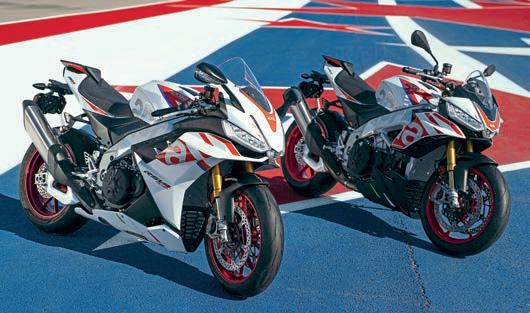
We’d not need too many more excuses to pick up an Aprilia RSV4 1100 Factory superbike or a Tuono V4 1100 super-naked. They’re both brain-meltingly fast, come with loads of trick kit, and are basically amazing. But the Noale outfit is tempting us all the more with this slick limited edition white paint scheme.
Unveiled at the COTA MotoGP round, it’s just beautiful. Available until the end of the year, get onto the dealers toot sweet, we say!
THE GOAT BECOMES AN AMBASSADOR
By the end of his MotoGP career back in 2021, Valentino Rossi was some way off the front of the pack in terms of race wins and points finishes. But he was still by far the main man when it came to star appeal. His last title might have been in 2009, and his final class race win in 2017, but he still filled grandstands and emptied merchandise stands like no other racer.
It makes perfect sense that he’s signed up as an official Yamaha Ambassador for the next few years. The Doctor took four 500GP titles with Yamaha and has stuck with the Japanese brand after retirement, using R1Ms and YZF450s for fun and training. “We worked together for many years in the past,” Rossi said, “so it feels natural. After I retired from MotoGP, I’ve kept training and riding motorcycles. During my MotoGP career, I rode Yamaha bikes as part of my contract. But even after retiring, I kept using Yamaha bikes because I enjoy it. I’m happy that the agreement is now signed, so Yamaha and I get to work together in this new set-up.”

JULY 2023 WWW.FASTBIKESMAG.COM 11
Keep an eye on our online channels – Facebook, Twitter, and the Fast Bikes website (www. fastbikesmag.com) – for news as it happens.
BMW R12 NINET

BMW invited us to a sneak preview of its new 1200 roadster range in Munich last month. And while it doesn’t look like a huge difference from the current RnineT retro, this R12 nineT will bring in a heap of new technology in the engine and chassis. BMW also reckons it will take customisation to another level, with things like being able to swap out the dashboard to suit your taste – in the way that current RnineT riders can choose different seats wheels or exhausts.
The engine will be a big part of the revamp, though. This is just an early prototype R12 – the firm says it will be launched properly next year – so we’ve not got the full spec and don’t know exactly what’s gone inside. From the outside, it looks not unlike the current ‘Heritage’ oil/air-cooled powerplant used on the RnineT range. That is basically the last R1200 engine from before water-cooling arrived, with ‘horizontal’ inlet and exhaust ports rather than the ‘vertical’ inlet and exhaust on the latest Boxer 1250 lump, dohc four-valve heads, and a ‘1200cc’ capacity.
There’s now an R12 logo cast into the crankcases though, and there has been an extensive internal revamp – partly to meet future emissions regs, partly for better performance, and partly to allow more high-tech systems. That ties in with the customisation as well: BMW designers told us that they want riders to be able to swap out a retrostyled dual pod speedo/tacho instrument panel for a
super-trick TFT LCD panel, for example. So you can have a bike that looks like a 1970s roadster at first glance, but it has all the modern rider aids, smartphone integration, Bluetooth and the like available too.
























The chassis is standard enough fare for the class: steel tube frame, the Paralever shaft drive rear suspension, and a neat set of USD front forks. Add in the scrambler-style dual can exhaust and retrostyled tank and sidepanels, and an optional brown seat, and it looks bang-on as a modern heritage machine.


The rebrand is a big step. The RnineT has been a big hit for BMW; 100,000 have been sold in the past 10 years since launch. And the idea is that R12 will sit alongside the bigger R18 as two retro heritage line-ups. The senior managers showing off the R12 nineT also hinted that this will be the first of several bikes built on the new engine and design, like the R18 range, so you can expect models like the current Urban G/S, Scrambler, Pure and Racer. There will also probably be an R12-based cruiser type machine, like the R18, though in a smaller, more manageable package. We also reckon that a Bobber-style machine would make a lot of sense – the Triumph Bonneville Bobber has been one of Hinckley’s biggest hits, and the R12 platform would easily transform over. More info is promised for later this year... watch this space.
BMW 100 YEARS EXHIBITION AT THE MUNICH MUSEUM
BMW motorbikes are 100 years old this year, the firm having released its first bike, the R32, in 1923. The R32 was a 494cc Boxer with shaft drive and premium manufacturing quality – so you can see how the firm has stuck to the knitting, as it were. As part of its centenary celebrations, it has set up a new 100 Years exhibition at the corporate museum in Munich, which showcases all the milestone machines from those 100 years – from the early vintage Boxers, which had a troubled life interrupted by the two world wars, through to the firm’s resurgence in the 1960s and 1970s, up to its current range of superbikes and GS adventure machines... it’s all here. There’s also a focus on the people who made the brand, racers like Georg Meier and Michael Dunlop, Dakar heroes Gaston Rahier and Hubert Auriol, R90 S designer Hans Muth and many more.
The exhibition runs until May next year, entry is 10 Euros, and it opens Tues-Sun, 10am-6pm.







■ Need another excuse for a BMW-heavy trip to Germany? The dates have been announced for the annual Motorrad Days event, where you can eat, drink, and make merry in a festival environment with music and bikes. The event is in Berlin now – an amazing place for a city break anyway – and it runs over the weekend of July 7-9. More info at www.bmw-motorrad.co.uk

PLANET FAST BIKES TAL, NEWS & REVIEWS 12 JULY 2023
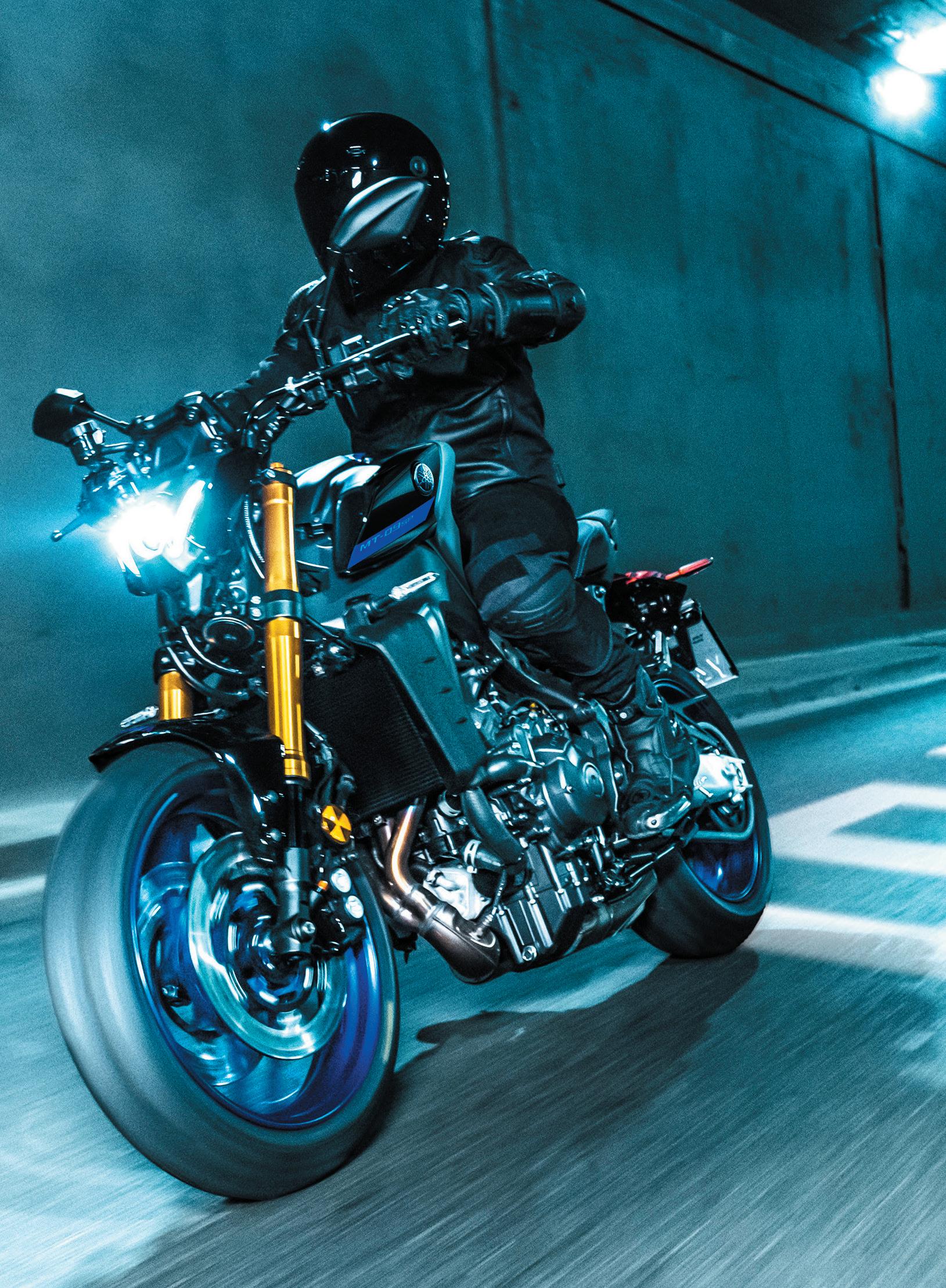






KTM DAKAR MUSEUM
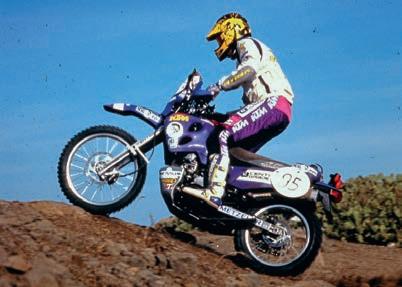
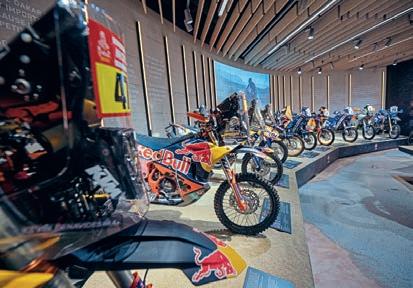

Teutonic museum exhibitions are like buses, it seems: none for ages, then two turn up. KTM has announced a historical showcase at its corporate museum in Mattighofen, Austria, to mark its record of Dakar desert racing. The Legends of the Dakar show has all the big bikes on display, from the early days in the 1990s through to 2023. KTM race legends like Heinz Kinigadner, Fabrizio Meoni, Marc Coma, Matthias Walkner, Toby Price and Kevin Benavides have contributed their thoughts and stories from Dakar, South America and Saudi Arabia. Add in the MotoGP elements of the KTM Motohall displays and it looks like a cracking day out. More info at https://ktm-motohall.com
ELECTRIC AVENUE...
Hate it or loathe it, electric power is expanding everywhere. And this month saw a couple of new launches that may be more significant than they first appear.

First up is the Livewire S2 Del Mar – a smaller, lighter, less cruiser-y variant on the Livewire One machine, developed when Harley-Davidson owned the firm. Harley has sold off the brand since that bike launched (though it retains an interest), so there’s more freedom for Livewire to develop other
electric bikes. The Del Mar uses most of the Livewire One powertrain, with some updates and optimisation, in a more youth-oriented street bike design. It weighs 195kg, puts out about 80bhp and will do 110 miles to a charge in ‘urban’ conditions. It’s not going to replace petrol for most folk (especially at the price of £19k), but it’s another small advance for the tech. More info is online at www.livewire.com
The other bike looks, on the face of it, to be even less revolutionary. It’s a moped-level scooter, with 30mph top speed, 25-mile range, 95kg weight and a 2.3bhp power output. What makes it interesting is the maker – Honda. It’s the first of 10 planned new electric two-wheelers from the big H to make it to Europe, and while it’s a tiny step, we must remember how the Japanese giant transformed motorcycling from similarly small steps in the 1960s. The new EM1 e:scooter uses the removable battery tech pioneered by Honda, KTM, Yamaha and other brands – which promises an answer to slow charging worries. Will the EM1 e: be the first ripple from a wave of new, high-tech electric bikes that we’ll all want to be riding in the 2030s? You might not bet against it…
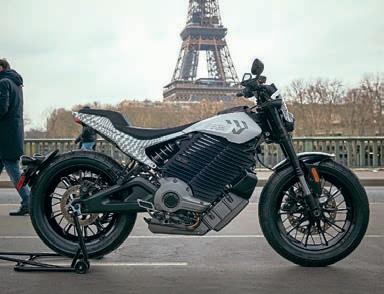
PLANET FAST BIKES – NEW METAL, NEWS & REVIEWS 14 JULY 2023






















JULY 2023 WWW.FASTBIKESMAG.COM 15
ALL THE LATEST, COOLEST & TRICKEST PE
HJC RPHA 1 QUARTARARO REPLICA
HJC has expanded its roster of top talent, signing up the 2021 MotoGP world champion Fabio Quartararo for 2023. And that means you can buy his replica paint design on the firm’s top-end RPHA 1 helmet –complete with massive Monster Energy logos and his own bright red ‘Diablo’ devil motif. Under the eye-bleedingly bright paint is the

£849.99
FIM-approved RPHA 1 carbon/ composite shell, also now ECE 22.06 approved and packed with track-ready features. There’s extensive venting to keep your head cool in action, clear racing spoiler, quick-release locking visor system, Pinlock, removable washable liner and emergency release inner cheek pads.
www.oxfordproducts.com
ALPINESTARS PHENOM SHORT GLOVE


Yes, we’ve been saying it for a couple of months now – but summer is definitely here, so this Alpinestars Phenom short sporty riding glove is just what we need. A simple leather outer with soft goat leather on the palm and hard knuckle protection, they claim to be
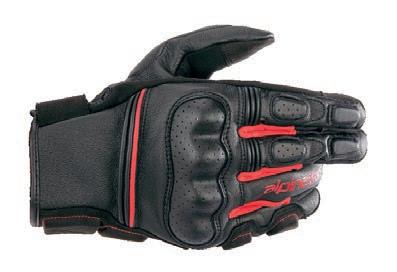

comfy from the off. There’s a single cuff closure, comfort stretch panels, extra padding on the impact zones and, of course, touchscreencompatible fingertips. Come in black or black/red, and also available in a vented air version for even hotter conditions.
ASV LEVERS
The internet is packed with cheap anodised no-name brake and clutch levers – but are you really willing to take risks with such a vital part? Us neither. ASV has been making premium replacement levers in the USA with a choice of colours and lengths for years now, and are well
£110/lever
worth paying the extra for. These fitments are to suit the BMW R1200 and 1250 GS, but the levers are available in hundreds of variants. Lever and thumbwheel adjuster also have loads of colour choices for the perfect complement to your bike.

www.performanceparts-ltd.com
SIDI BAUTISTA MAG-1 BOOTS
What’s the point in sponsoring a top rider if you can’t go a little overboard when they win? That’s just what Sidi has done with these incredible limited edition gold Mag-1 race boots, designed to celebrate the WSBK title won by Alvaro Bautista last year. Under the frankly audacious gold
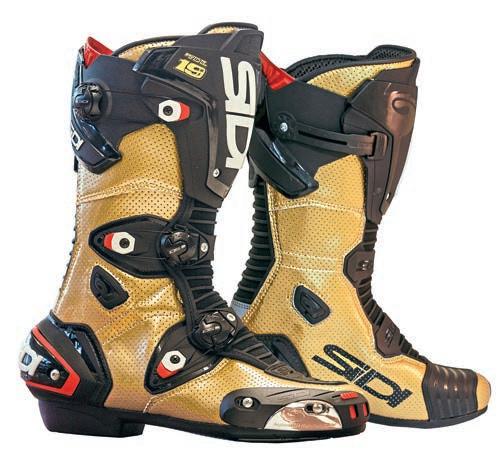
£389.99
finish is the Mag-1 boot with its magnetic closure system, replaceable shin plates, support braces internal system, outer TPU impact absorbers and micrometric memory straps. Only available from selected premium Sidi retailers; more info at the website.
www.sidiselect.co.uk
CTS
16 JULY 2023 WWW.FASTBIKESMAG.COM
RICHA CYCLONE 2 JACKET


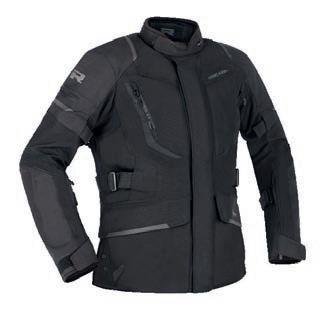
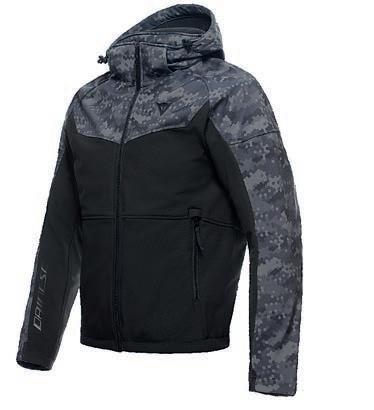

Belgian kit maker Richa has been moving up the ranks in recent years and now makes some properly sweet gear. This Cyclone 2 Gore-Tex jacket is a good example: it’s packed with top-end features, versatile design, and premium materials. The outer ripstop
£529.99
OXFORD SEQUENTIAL INDICATORS

The latest posh trick on new cars and bikes is to have sequential indicators that flash out in cool, exotic ways. And now you can add that function to older bikes with Oxford Products’ new sequential indicators.
Available in a range of designs and fitments, they have eight or nine LEDs that sweep out behind a smoked lens when activated. They attach with an M8 bolt, come with the resistors needed to work with standard 21w bulb indicators, and are easily connected into existing wiring with Oxford’s optional Indy connectors.

£49.99/pair www.oxfordproducts.com
shell has highly abrasionresistant panels with a Gore-Tex Z liner and removable thermal inner, plus extensive ventilation from the Richa Airtech Control System. There are stretch panels at the elbows, shoulders and torso, and a neoprene comfort
storm flap closure, and D3O armour on elbows/shoulders and a central back protector round off the spec. Available in men’s sizes S-6XL in black, black/yellow and black/grey and women’s S-4XL in black only.
www.nevis.uk.com
DAINESE IGNITE HOODIE
We love a hoodie – and this Dainese Ignite Digi Camo looks like a cracker, with a pixelated urban camouflage pattern. But it’s actually a proper protective jacket, with removable hood section for riding, removable Pro-Armor in the elbows and shoulders, and pockets for both chest and back
£229.95
RING RTC4000 MINI CORDLESS TYRE INFLATOR

If you spend a lot of time on the road, this could be a lifesaver. The Ring RTC4000 electric pump weighs less than a kilo and is compact enough to throw into a pannier or top box, giving you a quick tyre inflator by the side of the road. It’s ideal if you have a slow puncture or need to get air in after repairing a puncture, and it is better than messing about with those CO2 canisters, we reckon. Also very useful at a trackday, it’s powered by its own battery that charges from USB-C or a 12v connector, and has built-in LED work lighting.

£55 www.ringautomotive.com
GARMIN XT2
protectors. The fleece outer is water-resistant, it uses a proper tough YKK zip, and there’s a connecting hoop to attach to trouser belt loops. You’d probably not want to be crashing on the motorway at 120 in it, but as a smart urban protective jacket, it looks sweet. Decent price, too.
www.dainese.com
Sat-nav boss Garmin has launched a new flagship GPS unit. The XT2 has a big new six-inch extra-HD LCD display that claims to be even brighter than before, and a heap of new features. There are new route planning features aimed specifically at motorcycling (working with Michelin) and ‘group’ riding features that help you keep track of other riders on a trip. It’s also designed to resist all weather conditions and vibrations – which can destroy camera components in smartphones used as navigation devices. Even more impressively, the XT2 can work with Garmin’s optional inReach satellite communication device to give global emergency messaging cover – ideal in a crisis when out in the backwoods.

£529.99 www.garmin.com
OPTIMATE USB-C CHARGER
We’re old enough to remember when USB connectors first appeared on computers – who would have imagined they’d end up absolutely everywhere? The latest standard is USB-C, of course, which can deliver a load of power, and most electronic kit is moving to that connector. Make life easy on an older bike by fitting one of these Optimate USB-C adapters: it plugs into an Optimate-style SAE connector and gives you a proper 3.3 amp output at 5v. There’s also a useful vehicle battery monitor built in, and the USB output turns off automatically with the ignition.
£49.90 www.optimate1.com
PRODUCTS JULY 2023 WWW.FASTBIKESMAG.COM 17


FEATURE
WORDS> BRUCE PICS> CHIPPY WOOD NEW 18 JULY 2023 WWW.FASTBIKESMAG.COM
OLD VERSUS
BMW S 1000 RR
Just how
much
have sportsbikes changed over 13 years?
Like most of our tests, this one came about following a casual conversation. Johnny and I were nattering about iconic sportsbikes, and it didn’t take long before BMW’s very first S 1000 RR was thrown into the mix. Its arrival on the scene in late 2009 created a massive stir, breaking the confines of convention and setting a new standard and expectation for sportsbikes thereafter. BMW achieved the unthinkable, launching a box-fresh wonder weapon that produced more power than its Japanese rivals, featured more tech, and dispatched

the German brand of its ‘pipe and slippers’ affiliation. It was a watershed moment, and as we harked on about our first rides and memories from 13 years earlier, we figured there was no better time to get the bike back in the mag so we could see how this gamechanger had weathered.
Were we just banging on with rose-tinted, nostalgia-fuelled glasses? Or was this machine the timeless centrepiece we still believed it to be? As luck would have it, Johnny had a mate who owned an absolutely mint original version, with just a
few thousand miles on the clock. He’d also just taken delivery on his long-term 2023 model S 1000 RR… and the rest is history. A date was set, a shoot was arranged, and the only thing missing was Johnny, who’d had to head off to the NorthWest for road racing duties. Which is another way of explaining how Tim and I lucked in on this shootout, pitching old against new to settle whether what we had way-back-when could even hold a candle against the latest and greatest Bahnstormer from Bavaria. Here’s what we made of them…
BMW S 1000 RR
JULY 2023 WWW.FASTBIKESMAG.COM 19
S 1000 RR: GEN 1



Some bikes don’t bode well over time – it’s a simple fact. They’re either too ugly, marred by an underwhelming level of performance, or hated because they break down more often than a snowflake. BMW’s first generation S 1000 RR is not one of those bikes, and every time I see one I find myself doing a double take. How the hell did the German brand nail the brief so well, without a warm-up act, crafting a machine that not only still looks the part but also delivers a riding experience that defies the test of time better than Botox? You get the gist... I’m a big fan and always have been. I first rode one in 2010, undertaking a massive blast around the Yorkshire Moors, Dales and Lake District, and I swear the endorphins from that inaugural onslaught still pump around my body. It was
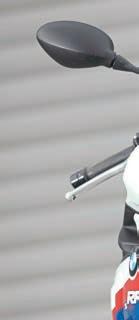
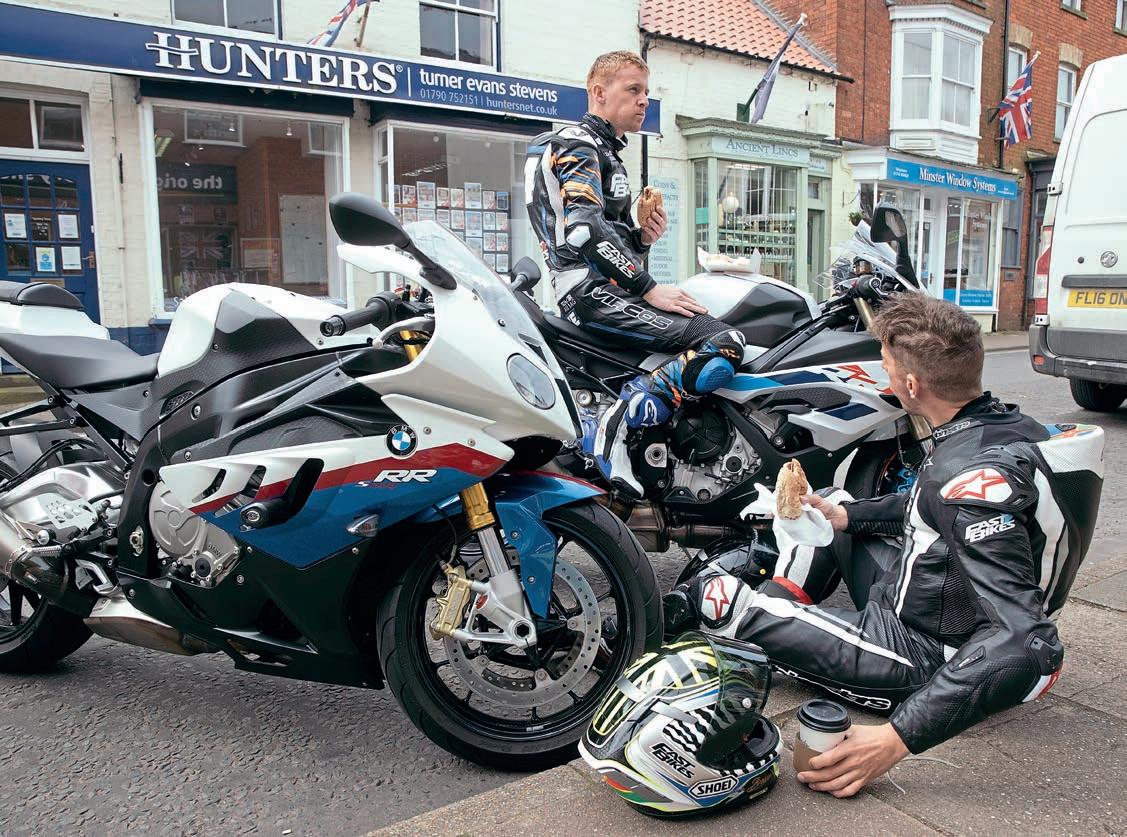
a hell of a bike back then and, having thrown a leg over this pristine 2000-mile old example that a remarkable reader kindly loaned us, I can vouch that it’s just as capable of putting a Cheshire Cat-style smile on my face as it was back then.
If you’ve ridden one of these before, then you’ll know exactly what I’m banging on about. But I appreciate there are those who will have never tried one out for size, so allow me to elaborate on what you are missing. The first thing to hit you when you climb on board is how low the seat height is and how sportingly slanted the bars are. Unlike more contemporary machines, you sit sunken below the tank top and it’s impossible to ignore the clean but now dated half-digital/half-analogue clocks that give away its vintage. There’s nothing wrong with them, and if you were to compare them with
Above: It’s a hard life.
Right: Even with 11-year-

FEATURE
20 JULY 2023 WWW.FASTBIKESMAG.COM
old tyres, the Gen 1 could still cut some shapes.
other offerings that arrived at that time, they were as cutting edge as anything else on the market. The same can be said for the switchgears, which included the novel ‘mode’ button that on this machine allows you to switch between rain, sport and race calibrations (you could/can buy an additional plug-in for slick mode), automatically altering the power, traction and ABS offerings to suit the selection you make. It was pioneering tech back then, being the first sportsbike on the market to offer such a function, but by today’s standards it’s arguably rather basic, lacking the ability to go in and actively alter the exact level of integration you’d like – the bods at BMW set the algorithms, and what they gave you is what you got.
It’s not the end of the world, and the same can be said for the lack of other technological goodies most riders would expect on modern-day RRs. For example, there’s no cruise control to talk about, or heated grips either, and don’t even waste your time searching for controls to the non-existent electronically adjustable pogos. When this bike came out, it wasn’t trying to cuddle you into loving it… its agenda was to go fast,
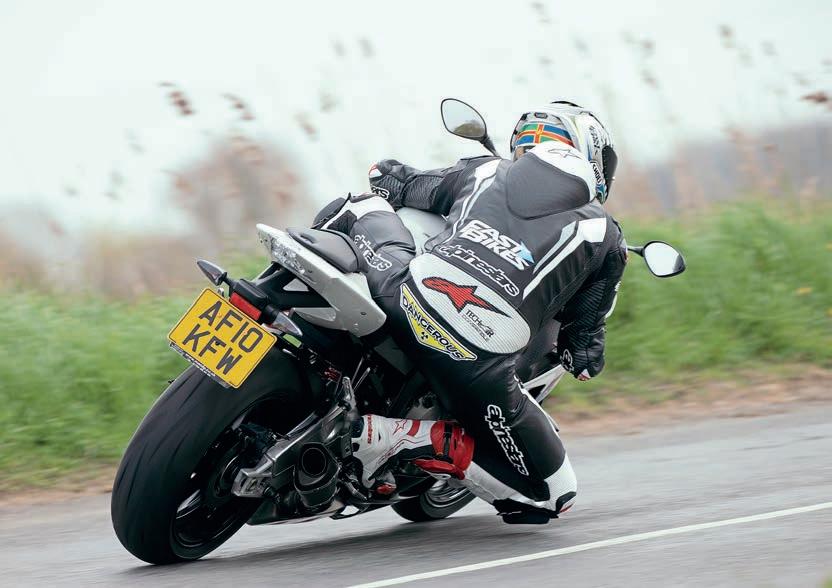

scare the living daylights out of you, and make you convince your mates that behind the weird asymmetric headlights lived an absolute headbanger that belonged in your garage. That message clearly got through, because despite its then questionable styling cues, they sold like hot cakes. One button that’s very much present – and fantastically so – is the ‘fun’ button. I don’t know what its real name is, but with one touch you can
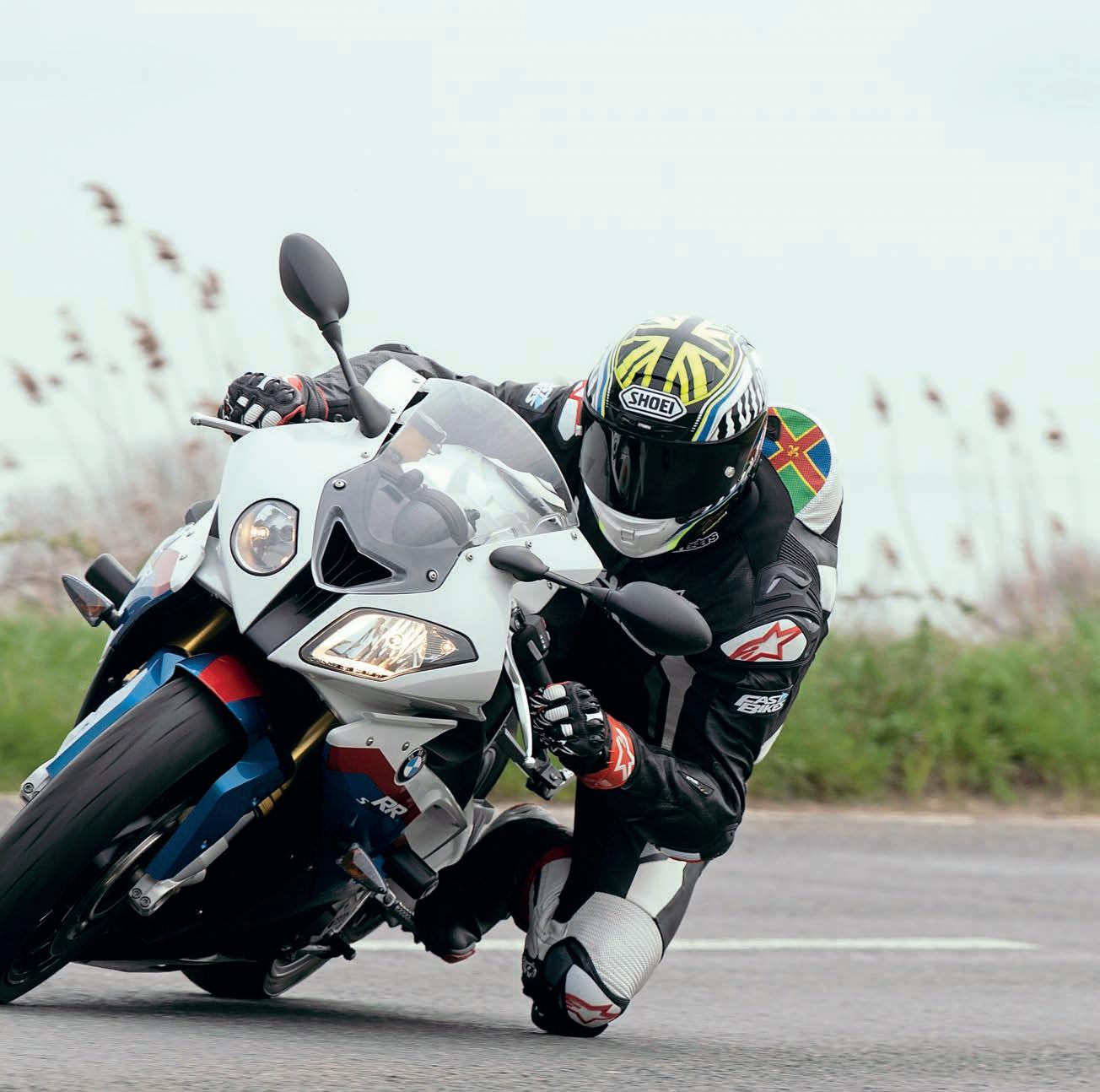
S 1000 RR: GEN 1
JULY 2023 WWW.FASTBIKESMAG.COM 21
It’s stood the test of time.
TIMMY’S TAKE

If I had to describe the old Gen 1 BMW S1000RR in one phrase, I would say it fits like a glove. It feels so strange to label this bike as old but the fact is, I’m not wrong. It is 13 years of age now, which seems mad to say as it doesn’t feel two minutes since it came storming onto the sportsbike scene and raised the bar by a good chunk. In my opinion, the Gen 1 Beemer looks just as beautiful as any modern sports bike and it’s obvious that BMW nailed the aesthetic at the first attempt. This immaculate example looks like it has been wheeled straight out of the showroom, and it’s in brand-new standard fettle apart from the single bolt-on aftermarket part, which is the stubby Akrapovic silencer –and I say that’s an improvement on the rather large and rasp-muffling standard end can. Not only does it look 10 times better than the original, but it sounds 10 times better too, with its throaty bark and, in comparison, it makes an idling Gen 4 S1000 RR sound like an airstarved hairdryer. I’m not too sure the owner’s neighbours would approve of the upgrade as it does belt out when you crack the throttle, but that’s their problem.

It sits much lower in the saddle compared to the Gn 4. I’m not exactly sure why BMW decided to lift the saddle height on the newer models, but from a road riding standpoint, I much prefer the lower riding position of the older model as I can touch the ground on both sides with ease and that always gives me a sense of control. The downside is that the riding position is cramped, with less room to the footpegs, so longer journeys probably wouldn’t be quite as comfortable as they’d be on its big sis, but for a quick thrash around the Lincolnshire Wolds, it was no problemo. The handlebars are non-adjustable and very swept-back in a racy position, which I’m not a big fan of,
but you must remember this was BMW’s first litre homologation sportsbike to hit the market, so making it racy was probably at the forefront.
I found the throttle long and heavy, and that would be thanks to the old-school cableoperated set-up. We are spoilt these days with the latest sensor ride-by-wire throttles, which are just so light and snappy, so a stiff throttle stands out like a sore thumb (or should I say wrist) when you jump on an old bike.
The lack of the blipper wasn’t half as much of a problem as I’d expected. In fact, it was quite nice to use the clutch on the back shifts, and to have that sense of riding the bike properly with more rider input was rather satisfying. Having a quickshifter for going up the box, however, is most definitely a perk, even if I did feel that this one wasn’t particularly responsive and really took some pressing on the lever. I believe the blip can be adjusted on BMWs, so that could probably be improved.
The initial bite of the front brake was grabby, but in heavy, progressive braking, these Brembos really did a great job of pulling me up fast, and the suspension, although softer then the Gen 4, gave me all the feel and confidence I could have asked for on Lincolnshire’s dirtridden back roads.
When the Gen 1 first hit the scene in 2010, it made a huge statement, bringing MotoGP-level tech into the road riding world. As amazing as that was at the time, things have really come a long way in terms of development and refining in the last decade, and thank goodness for that, as the anti-wheelie system was noticeably crude and delayed in comparison to the models that have followed. But hats off to the Germans for getting a working systems up and running before the competition came along.

disable the ABS and traction systems, meaning pretty much anything goes. Tech-wise, that’s about your lot, but there’s so much more to talk about… torque being one of them.
BMW claimed that the RR made 190bhp. It didn’t, but it made a lot. Fast Bikes tested one back in the day and the figure on our dyno was 179bhp. The torque was tidy too, pumping out 106Nm at 9750 revs. As with most road riding experiences, you tend to spend most of your time in the first half of the rev counter, which was no bad thing on this bike. From very low down, the RR’s motor produces a wave of oomph that builds progressively until you’re bothering the limiter. The delivery is very linear, and aside from an initial disruption as you crack open the cable-operated throttle, the fuelling is hard to fault. As already mentioned, this
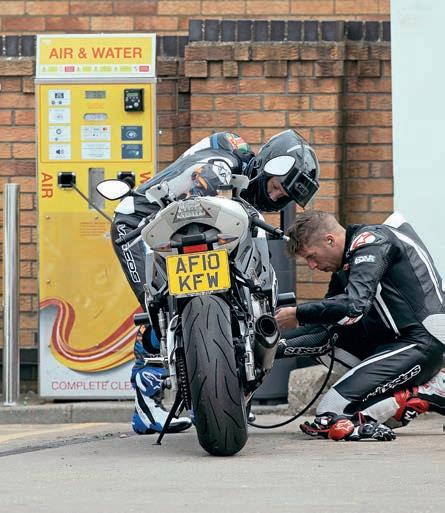
FEATURE
22 JULY 2023 WWW.FASTBIKESMAG.COM
The Gen 1 was under pressure to perform.
particular example was cleaner than Timmy’s innocent thoughts, but it was fitted with a great-sounding non-OE Akrapovic can. That thing seemed to heighten the riding experience no end, translating the urgency of the motor as the needled rev counter made its way skywards, the front wheel often following it. It gave the bike a real sense of character, which is a word that can be used to describe the shifter on this thing. Back in 2010, quickshifters were largely the stuff of racing gods or the extremely rich. The fitment of such an item on this bike cannot be understated, as it was to form a benchmark for its rivals. The downside to this relatively early commercially-scaled option is that it’s not the slickest by today’s standards, but it is tolerable; as long as you are firm in your actions, it’ll race you up the RR’s box in a jiffy. Coming down the six-speed cassette is a little more agricultural, because there’s no blipper to talk about, but don’t let that put you off owing one.


The truth is that this machine’s a generation or two behind in spec and tech,


but the overall riding experience is really quite good. The Brembo monobloc brakes have some real stopping power to them, and have a good feel too, albeit this one seemed to pulse the lever when tickled, as if the discs were warped – which did not look to be the case. The rear anchor was pretty much useless, but the otherwise general functions of the machine were endearing. It wasn’t uncomfortable to ride, with loads of wind protection behind the front cowl and screen. The knee angle maybe wasn’t the most generous, but I managed a few hours in the saddle without too much drama. The seat was well-padded and once I’d got used to the angle of the bars, I felt really quite at home.
Handling-wise, the RR was impressively lithe for a bike that weighed in at more than 200 kilos. It wasn’t the quickest in turning, but there was plenty of feel through the suspension. Around a bend, the bike typically felt stable and did a good job of mopping up the road’s imperfections that at one point included a sunken manhole which jumped out at me mid-corner, full lean. I was
S 1000 RR: GEN 1
What’s not to like?
JULY 2023 WWW.FASTBIKESMAG.COM 23
It floated Timmy’s boat.
bricking it, almost as much as I was when the 11-year-old Michelin Pilot Sports started to let go without so much as a hint of help from the bike’s TC. Still, getting away with such moments only made me like this bike that little bit more.

If I owned it, a new set of tyres would be a must, and firming up the suspension would also be at the top of my list, but that wasn’t the nature of this test. I was out for a joyride, getting reacquainted with an old friend that effortlessly won me over with its ways. And
it wasn’t just the riding experience that made me warm to this bike – it was the nostalgia attached to it to. This really is a very special machine and in the sportsbike hall of fame, should be considered a gateway to reaching the dizzy heights we are at now. Quite simply, if this machine hadn’t rocked the applecart how it did, it might have meant we missed out on many more pivotal machines that went on to do battle against it. Yep, it’s a special motorcycle, and as my test came to a
conclusion, I couldn’t help but take one last approving glance at its chunky frame, aggressively angled fairings and in-your-face swingarm. From a pure engineering point of view, not a lot of those articles make sense nowadays, but they make this bike look so awesome, especially in the blue, white and red colour scheme. Would I own one? In a heartbeat.

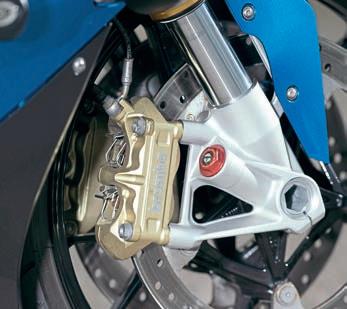
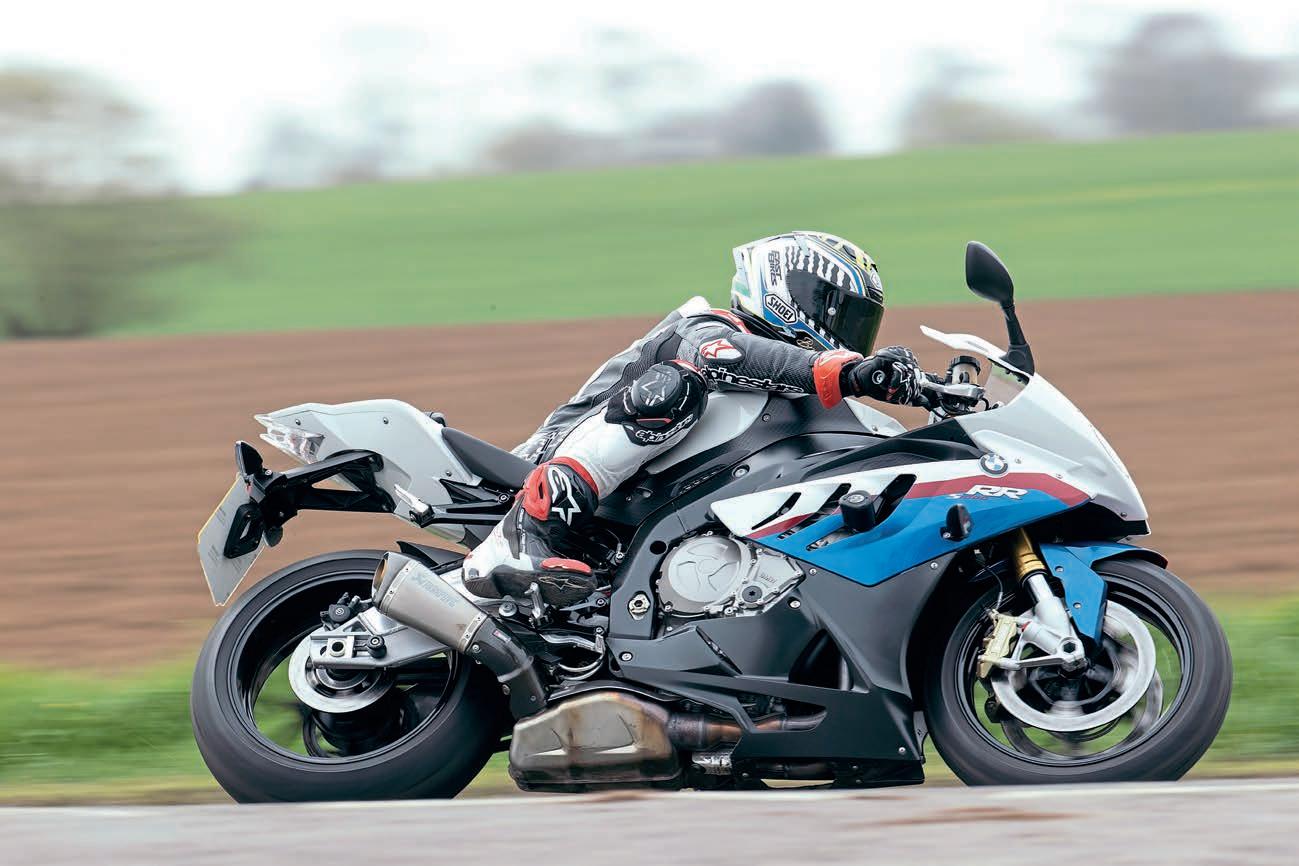
FEATURE
“Mine’s better than yours.”
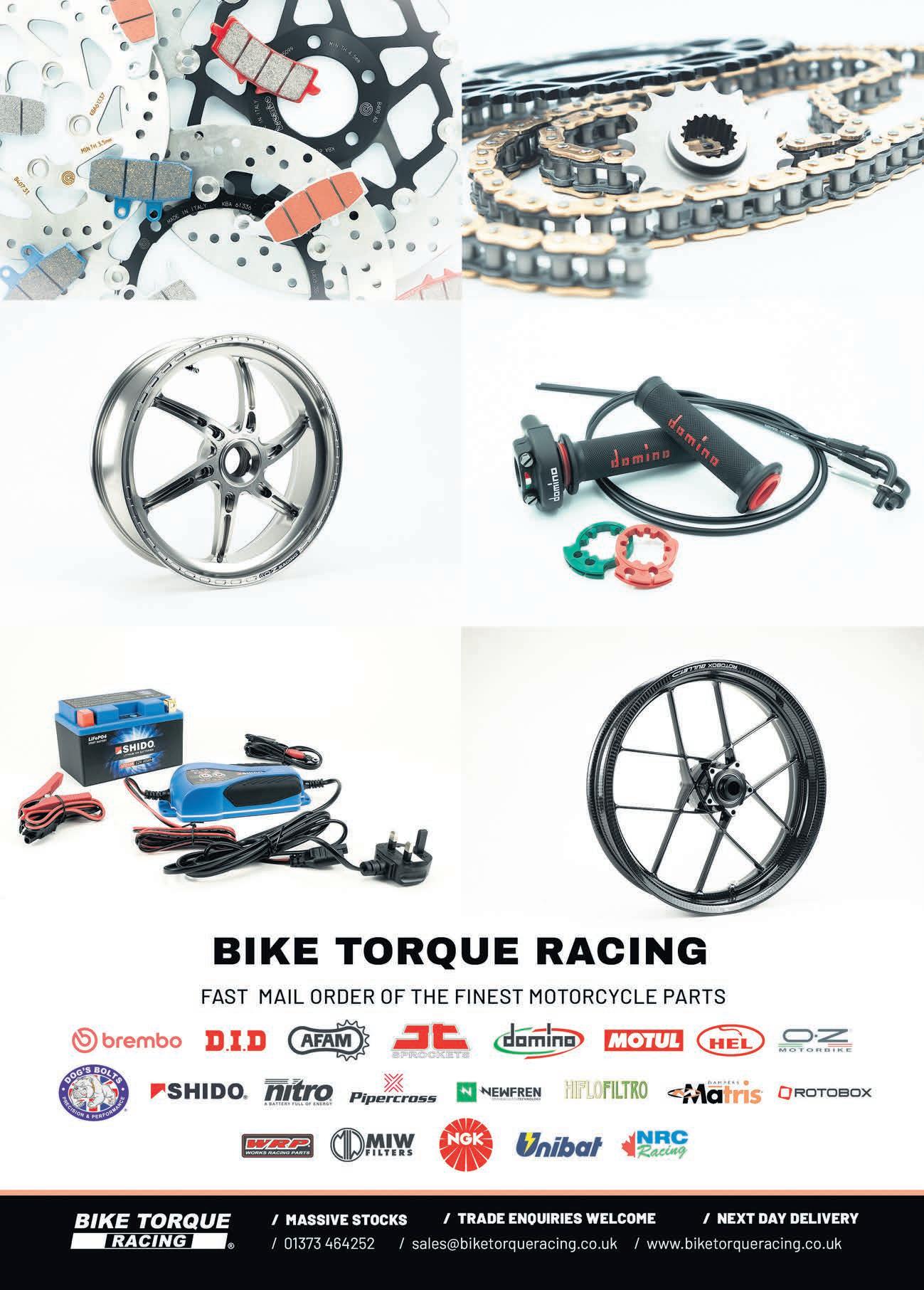
BMW S 1000 RR: GEN 4

So, what difference does 13 years make to a model? A lot, you’d hope, which is exactly the case with the 2023-spec RR. It batters the Gen 1 in every
way, which it should do, but before we get into the nitty-gritty of what it’s like to ride, let’s look at the basic differences between the two machines. The new RR’s a chunk lighter, especially when presented in this RR Sport version that’s been kitted out with optional carbon wheels. It’s 7kg leaner, to be precise,
but perhaps the biggest talking point is the increase in horsepower. Going off the claimed outputs, the new machine produces 27 more ponies, with an additional dose of 7Nm of torque to back things up. Interestingly, peak horsepower comes in at a similar figure (13,000rpm versus 13,500rpm), but the spread of torque on the new bike is much greater thanks to its integration of BMW’s
FEATURE
26 JULY 2023 WWW.FASTBIKESMAG.COM
Shiftcam technology that allows for optimisation of cam timing according to the engine’s revolutions. This is a piece of engineering that wasn’t even heard of back in 2010 – and the same can be said for six-axis IMUs, aerodynamic wings on bikes, and technicolour TFT dashes... and add into that mix 15 levels of traction control, dynamic damping control (electronic suspension), hill-start technology and even a slide control function that’s in place to moderate your degree of drift on the exit of a corner. The list goes on, but you get the point. These two bikes might share the same branding and model designation, but the raw DNA they possess are akin to comparing Ten Pint Sylv down the pub with Kelly Brook.
BMW’s 2023-spec S 1000 RR is as cutting-edge as it gets, especially now it’s nabbed all the good bits from last year’s M 1000 RR. For over £10k less, the latest litre bike from BMW is a near mirror image of last season’s flagship M model, which itself got a hefty overhaul for 2023. To put it another way, the spec of this bike, even in the entry level RR version that weighs in at £17k, is beyond brilliant, and includes goodies such as M-Sport calipers, an adjustable swingarm pivot point, its aero package and a lightweight lithium battery. It also gets the M’s cylinder head, improved mapping, uprated race ABS and improved steering geometry to make the bike more agile and stable.
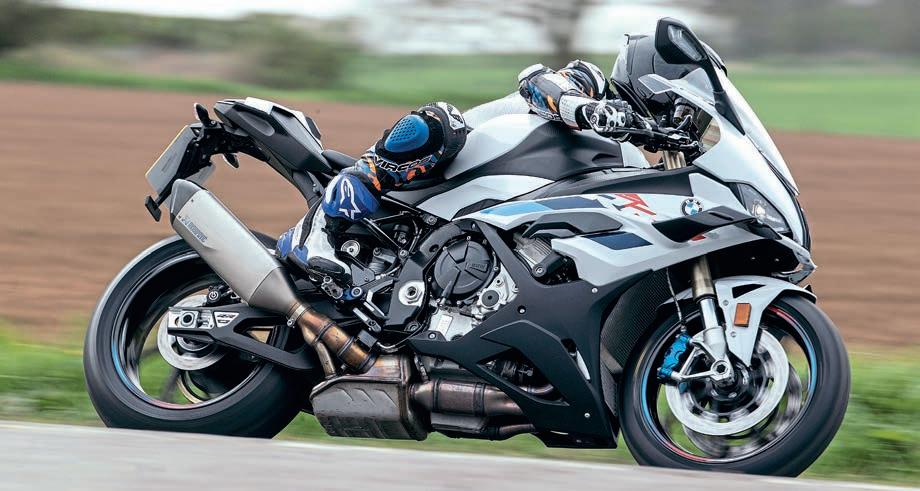


BMW S 1000 RR: GEN 4
JULY 2023 WWW.FASTBIKESMAG.COM 27
Above: The new RR is a treat to ride.
Below: It’s bigger than you think.
I was lucky enough to be on the new model’s track launch just before Christmas, but this was my first chance to swing a leg over the Beemer on the road. Truthfully speaking, I half knew what to expect from the blast because, despite all of its nips and tucks, it’s still arguably familiar to the 2019 version I clocked 5000 miles on the year it came out.

Yes, it looks a bit different, and yes, the M-sport accessories are suggestive of an uprated performance, but who among us is likely to spot the differences between an exceptional machine and one that’s been made just that little bit better all-round? Not me, and nor could I tell any difference in poise when I clambered aboard the giant slayer. It is, and always has been, a tallfeeling bike, with a high saddle and broad, tall-mounted clip-ons. As Johnny would put it, ‘it’s a proper size bike’, but for the likes of Tim and me, who’ve only just started growing hairy armpits, it feels substantially sized. Unlike the original, you sit more on top of the ’23-spec and the view in front of
you is startlingly different. The 6.5in colour display is the centrepiece, governable by a multitude of switches that include BMW’s scrollable multimedia controller. With that at your fingertips, you can choose between four pre-set riding modes. Luckily for us, our machine also had BMW’s dynamic package (£1400), which meant it featured DDC electronic suspension, cruise control, heated grips and riding pro modes. That latter addition meant if we’d so chosen, we could go into the guts of the BMW and alter three customisable race set-ups, configuring everything from the engine braking to the level of firepower desired with a few spins of the controller.
While we’re on that note, I should probably point out that other extras included the performance package (£925) consist of an Akrapovic end can and low friction M Endurance chain, plus the M Package (£4480) consists of the aforementioned carbon fibre wheels, M paintwork and a grippier M-spec rider seat. Collectively, it meant the bike was hiked up from £17,150 to £23,955… another



Above: The RR’s dripping in last year’s M parts.
Below: Which would you pick?
FEATURE
28 JULY 2023 WWW.FASTBIKESMAG.COM
way of saying this bike costs about four times what you’ll pay for a decent 2010 version. Moving swiftly on, the main OE tech additions for 2023 are the slide control and rear brake assist functions, which might make sense on track but are up there with a chocolate fireguard on the road. To get either engaged, you’ve got to be giving it the berries at -3 or below on the traction control settings. Still, it makes for good ammo when you’re bragging to your mates. The wings also fit into the style over substance for typical day-to-day antics, because while the 17.1kg of downforce they provide might come in very handy on occasion, you must be doing 186mph to get that degree of gain. I realise I’m probably sounding like I’m slagging the RR, which is not my intention – it’s more a case of saying that a lot of the tech on this machine is track-inclined, which is great if that’s your purpose for the purchase, but otherwise you will just have to accept you’re lugging around a whole host of rider aids you’ll never come close to exploiting.
TIMMY’S TAKE
I’m gonna jump the gun here and tell you that this beautiful Gen 4 BMW S1000 RR is just so easy to ride. It’s better than the Gen 1 in every aspect, as you would expect with more than 10 years of development, yet this bike is still distinctively a BMW, with many similarities to its predecessor.
I guess the big bonus with this package is that you’re basically getting last year’s M1000 RR for about £10k less, which is just awesome. I’d be feeling pretty miffed if I’d bought the M last year, and then this bombshell dropped. The all-new S gets many of the M components, such as the calipers, wings, cylinder head, wheels, levers, pegs… basically all the goodies you’d want to make your bike trick, but I did notice it was missing the M rear caliper, which is a real shame – anyone who has changed the rear wheel on the M will know just how much of a game changer it is compared to the standard set-up.

While admiring the bike’s sporty lines, I noticed that the rear seat unit brake light has been removed and that the brake light is now all part of the indicator set-up. I’m not sure how long BMW has been doing that with its sportsbikes, but damn, it looks good and is something I’ve not seen with any other manufacturer.

The tickover is extremely dull, like a hairdryer at best, but do not be deceived. When you get this bike out on the road, it is an animal and really comes to life. The motor picks up extremely fast and revs way further than I expected. The quickshifter is silky-smooth and precise, and I found that the faster and harder I worked it, the more responsive it became, popping gears through in a flash. The anti-
wheelie system is seamless and a huge step forward from the Gen 1, as you would expect, but if you want some real fun with this bike, then turn off the traction control (this turns off anti-wheelie too) and take this bike to a whole new level – I literally couldn’t keep the front wheel down. It blew my mind how much fun I could have, and it just feels so well put together and refined.
I used the heated grips all day and they were top tier; it’s hard to put into words just how much difference a small perk can make to a ride out, but this BMW is loaded with all of the goodies. I even had a play with the cruise control, which was a first, selecting 30mph in the village, and it was a really easy system to use. I rode in the dynamic mode all day... there are multiple options and even a custom mode, but when it’s dry, you wouldn’t want any other – its super-fast, silky-smooth and very manageable.
The adjustable M levers are a nice addition, and within a few clicks I was able to find the perfect position, which is always important to me. I hate a lever I have to reach too far for!
If I had to get really picky, I’d say the rear brake lever is too low – I’m not sure what riding position they expected me to have, but getting onto that lever was nearly impossible, Secondly, the saddle height is just a bit too tall for me and it feels jacked up so you’re not ‘in’ the bike, but rather ‘on top’. In turn, when the tank is full, its feels hellishly top-heavy, which makes it hard to manoeuvre, but thankfully once you are up and running, the weight is not an issue, and what the extra saddle height gives you is a spacious cockpit with loads of room in the knees so it’s very comfortable.

BMW S 1000 RR: GEN 4
YOU WILL JUST HAVE TO ACCEPT YOU’RE LUGGING AROUND A WHOLE HOST OF RIDER AIDS YOU’LL NEVER COME CLOSE TO EXPLOITING.
JULY 2023 WWW.FASTBIKESMAG.COM 29
What you will get unadulterated access to is one of the best road-going litre bikes ever. Some people will argue that the RR is soulless, not helped by its typically quiet exhaust note or lack of engine character, but its refined disposition is something to celebrate in my book. Riding the BMW is beyond intuitive, made effortless by its torquey motor that’s as happy to tootle as it is to go mental. The throttle pick-up is sublime, the delivery is seamless throughout its rev range, and there’s little to no way of telling when the cam timing alters to optimise top end over torque… at about 9000rpm. The BMW is the consummate rocketship, with epic table manners and fantastic rider aids that allow you to exploit its 200-plus ponies without any issues. As the rider, just crank that throttle and allow the multitude of tech features to do their thing, culling wheelies, slides and any other such undesirables in the most clinical of fashions. It’s only when you turn everything
off that you can fully appreciate the true awesomeness of this bike. It is insane on the road, and I’d wholly suggest that you take advantage of the electronic wizardry this thing packs. They don’t dilute the experience, but instead allow you to ride the bike harder and, ironically, faster than what you would without them.
BMW’s tech has come on leaps and bounds in more recent years, and it’s hard to criticise the function of the shifter and blipper – or ABS, for that matter. The M brakes are super-powerful, and if you can get the ABS kicking in, it would suggest you’ve got a grip like a grizzly. On track, I did, but never once on this particular escapade. Yep, this thing goes very fast, stops equally as fast, but it also offers fantastic handling. With the wheels in motion, the RR feels effortless to place where you want it, undoubtedly aided by the leverage of wide bars, but also the perfect balance of weight. Because of its size, you

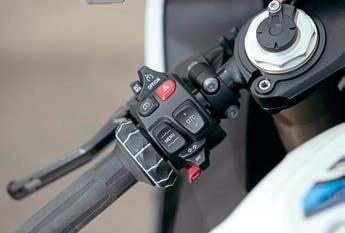
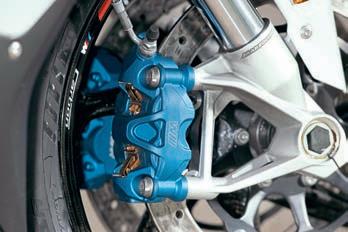
imagine it’d feel top-heavy, but it doesn’t, and it never hesitates to pitch into corners on demand. I was mostly riding the RR in race mode, meaning it had firmer DDC suspension settings, but it seemed to suck up whatever the road threw at it with ease, while remaining taught and stable through and out of corners. Admittedly, the front end feel on this bike is improved over the previous version, but it’s not night and day – which is another way of saying that it still feels a little too vague on the front of this bike for my liking, but that’s a sensation rather than a physical performance problem. I never had a single issue with the bike’s grip levels, front or rear. Come to think of it, I never had any issues with the RR full-stop. It is such an obliging and easy bike to get on with that you almost forget it’s a firecracker. It truly does take some topping, but as history has shown, it will be topped. I wonder what the 2033 RR is going to look like?
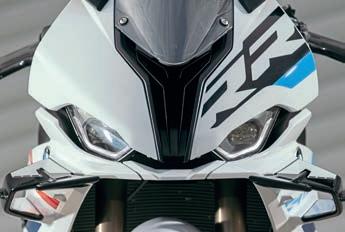
FEATURE
30 JULY 2023 WWW.FASTBIKESMAG.COM
In its happy place – on track.




















ROUNDING OFF...

FEATURE
32 JULY 2023 WWW.FASTBIKESMAG.COM
TECH DATA
2023 BMW S 1000 RR
ENGINE
Type: 999cc inline four
Bore x stroke: 80mm x 49.7mm
Compression: 13.3:1
Fuelling: RBW with electronic injection
Claimed power: 207bhp @ 13,500rpm
Claimed torque: 113Nm @ 11000rpm
ELECTRONICS
RBW/riding modes: Yes
Traction control: Yes
ABS: Yes
Quickshifter: Yes
Wheelie control: Yes
Launch control: Yes
Autoblipper: Yes
CHASSIS
Frame: Aluminium bridge frame / Aluminium bridge frame
Front suspension: 45mm fully adjustable USD forks (DDC optional)
Rear suspension: Fully adjustable monoshock (DDC optional)
Front brakes: M Sport calipers, 320mm discs
Rear brake: Single-piston, M Sport caliper, 220mm disc 1456mm
16.5 litres
(From) £17,150 www.bmw-motorrad.co.uk
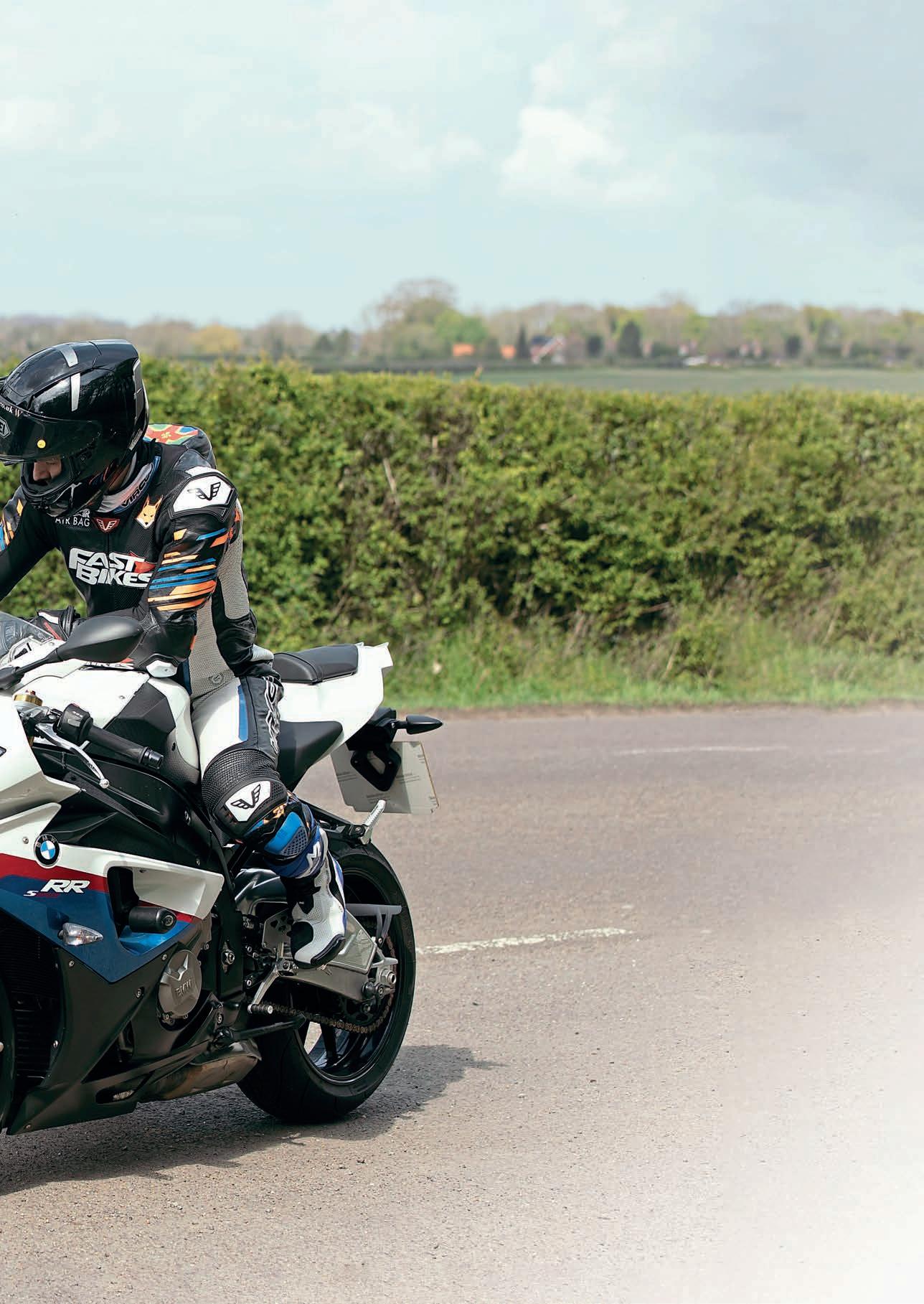
TECH DATA 2010 BMW S 1000 RR
ENGINE
Type: 999cc, liquid-cooled, DOHC, 16v, inline four
Bore x stroke: 80 x 49.7mm
Compression: 13.1:1
Fuelling: Electronic fuel injection
Tested power: 179bhp (190bhp claimed) @ 13,000rpm
Tested torque: 106Nm @ 9750rpm (Generation I)
ELECTRONICS
RBW/riding modes: Yes
Traction control: Yes
ABS: Yes
Quickshifter: Yes
Wheelie control: No
Launch control: No
Autoblipper: No
CHASSIS
Frame: Aluminium bridge
Front suspension: 46mm inverted Sachs fork, fully adjustable
Rear suspension: Sachs monoshock, fully adjustable
Front brakes: Four-piston radial calipers, 320mm discs optional, ABS
Rear brake: Singe-piston caliper, 220mm disc, ABS
DIMENSIONS
Wheelbase: 1432mm
Seat height: 820mm
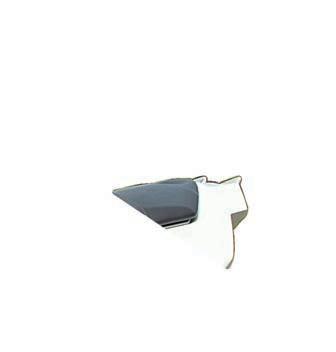
Wet weight: 204kg
Fuel capacity: 17.5 litres
INFO
Price: (Used prices) £5000-£10,000
From: Anyone who’s flogging one
So, what has this test taught us? Fundamentally, just how epic that first generation of RR truly was. You’ve read all we’ve had to say, so there’s not much point in harking on for the sake of it, but hopping on that bike, mindful of its age and lack of foundation to build on, it’s mind-blowing to experience just how right BMW got it from the very beginning. Admittedly, the following two generations of RR only made the package better, but we’re not talking light and day, as can be claimed from the point BMW went to the Shiftcam design in 2019. The ’23 spec RR is a whole different beast, armed with more performance and also the tech to back it up, and weighing in notably lighter, too. The end result is a much more polished, powerful motorcycle that’s easier to ride and is full of some fantastic tech.
It’s a very hard bike to fault and is arguably the best road-going litre machine on the market right now. But what it doesn’t have is the heart of that first RR. The 2010 model seems to tick the boxes, but in a way that makes you feel more engaged with the bike. It makes you work that bit harder, but rewards you more for your effort. If you’re fixated on contemporary qualities, you might find it a little lacking, but if you just want a hardcore sportsbike that’ll turn heads and get people reminiscing, the first-gen RR is the bike for you.
And it’s also a bike that’ll make you money. They’ve possibly never been so popular since their inauguration, which goes to explain why their pricing is still so potent, and you can expect values to continue to rise in the near future. So, if this test has whetted your appetite for the first truly high-tech sportsbike, don’t delay – go and buy one today.
BMW S 1000 RR
JULY 2023 WWW.FASTBIKESMAG.COM 33
WORDS: BIG MAC PICS: KTM
REBOOTED
KTM 890 SMT
It’s been 10 years since KTM dropped the SMT from its range, but now it’s back – with more bling, more attitude... and more reasons to own one.

LAUNCH
Iget nervous when I hear a manufacturer seemingly create a solution to a problem that doesn’t exist – or, at least, one I wasn’t aware of in the first place. Who knew that the world needs a Supermoto Tourer? KTM did, evidently, and the 890 SMT is proof that all along, the world has been missing a motorbike with words in its description that couldn’t be more diametrically opposed if they tried. I freely admit to making an inevitable comparison in my head between the KTM 890 SMT and the Ducati Hypermotard, so let me tackle this straightaway… there isn’t a comparison. Put that out of your head now, because while the SMT does have the same fundamental architecture as the Hypermotard, it is far more versatile.
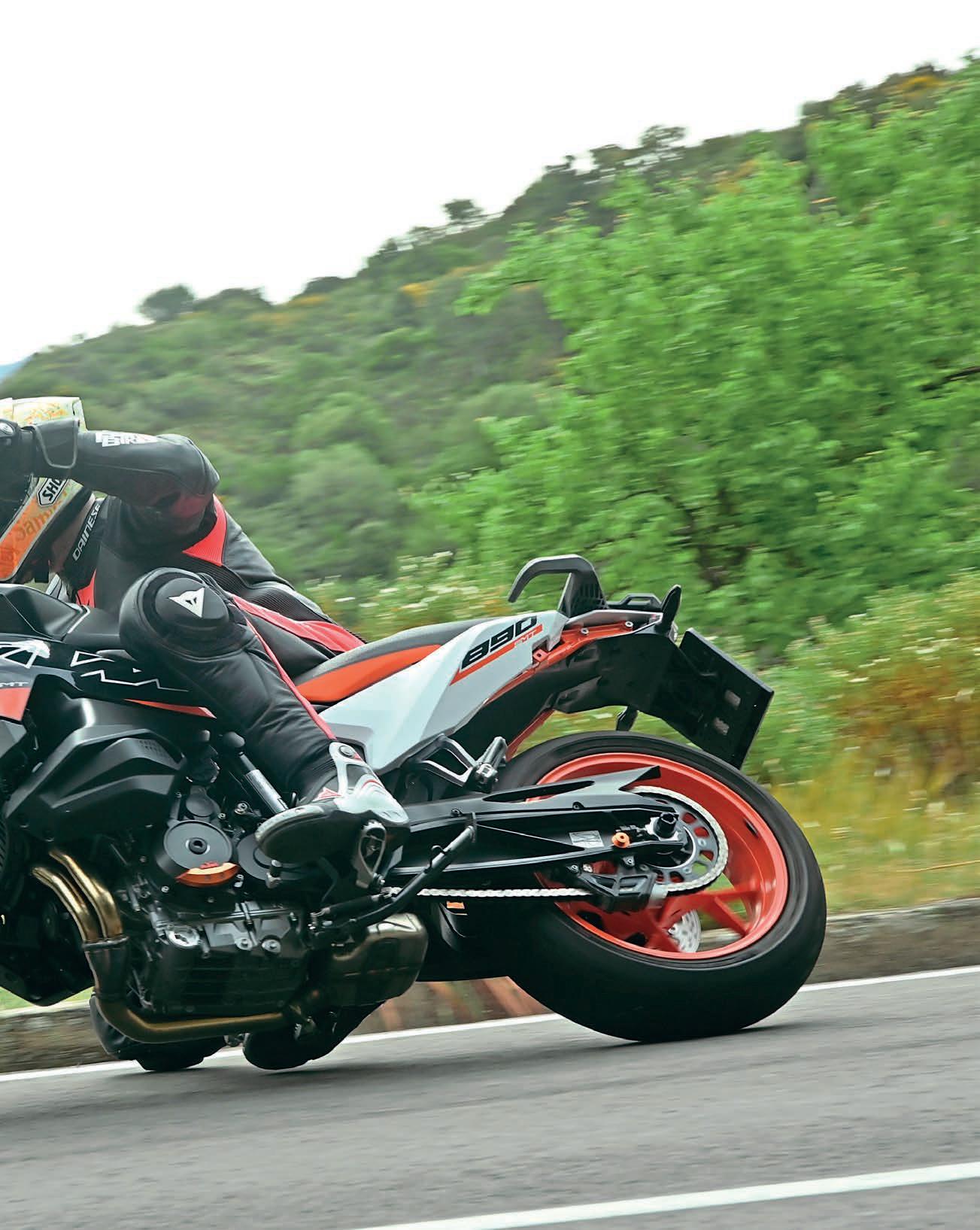
KTM 890 SMT
JULY 2023 WWW.FASTBIKESMAG.COM 35
For a quick refresher, the SMT isn’t a new concept by KTM, but it has been absent from the range for a decade, so you could be forgiven for not being aware that it has dabbled with a Supermoto Tourer before. The 990 SMT used the 990cc V-twin engine from KTM’s 990 SuperMoto, allowing KTM to have a go at the adventure market, but with a different slant. After all, why does ‘Adventuring’ have to mean 19-inch wheels, sometimes knobbly tyres, panniers, and enough excess weight to make having any actual fun on tarmac – as well as mile munching – physically impossible?
The original SMT made about 115bhp and weighed 198kg, which, coincidentally, is within a gnat’s chuff of what the 2023 reincarnation of the model’s headline numbers are from its 890cc parallel twin engine and steel frame. The original SMT was discontinued in 2013, around the time that the 1290 SuperDuke came along, which eventually spawed the 1290 SuperDuke GT to take care of the long-range yet still fun option. I ran a 1290 SuperDuke GT last year as my Longtermer and loved its all-round capability, but ultimately I was left feeling that much the SuperDuke’s magic was dulled by the sheer mass of the GT – 225kg, so at the best part of 30kg lighter, the 890 SMT should be a very different proposition to the 1290 GT.
The 890 SMT is a bit of a ‘bitsa’ bike by virtue of using the frame and engine from the 890 Adventurer, but with bespoke suspension from WP that is more closely related to the 890 Duke due to not having any offset to the front axle as the 890 Adventurer does. Even
though it’s closer to the Duke’s suspension, it is still 100% bespoke to the SMT, though. At 180mm, the forks and shock have 40mm and 30mm respectively longer travel than the Duke, plus heavier springs. It also gets 17in wheels; the front from a 1290 SuperDuke and the rear from the 890 Duke fitted with some trick Michelin Power GP tyres.
The SMT also gets the Duke’s electronic rider aids to continue the theme of KTM working smart and using what’s already on the shelf to create a completely new bike that – in theory – caters for the person who wants the long-range ability of the 890 Adventurer, but who also wants to be a bit of a loon

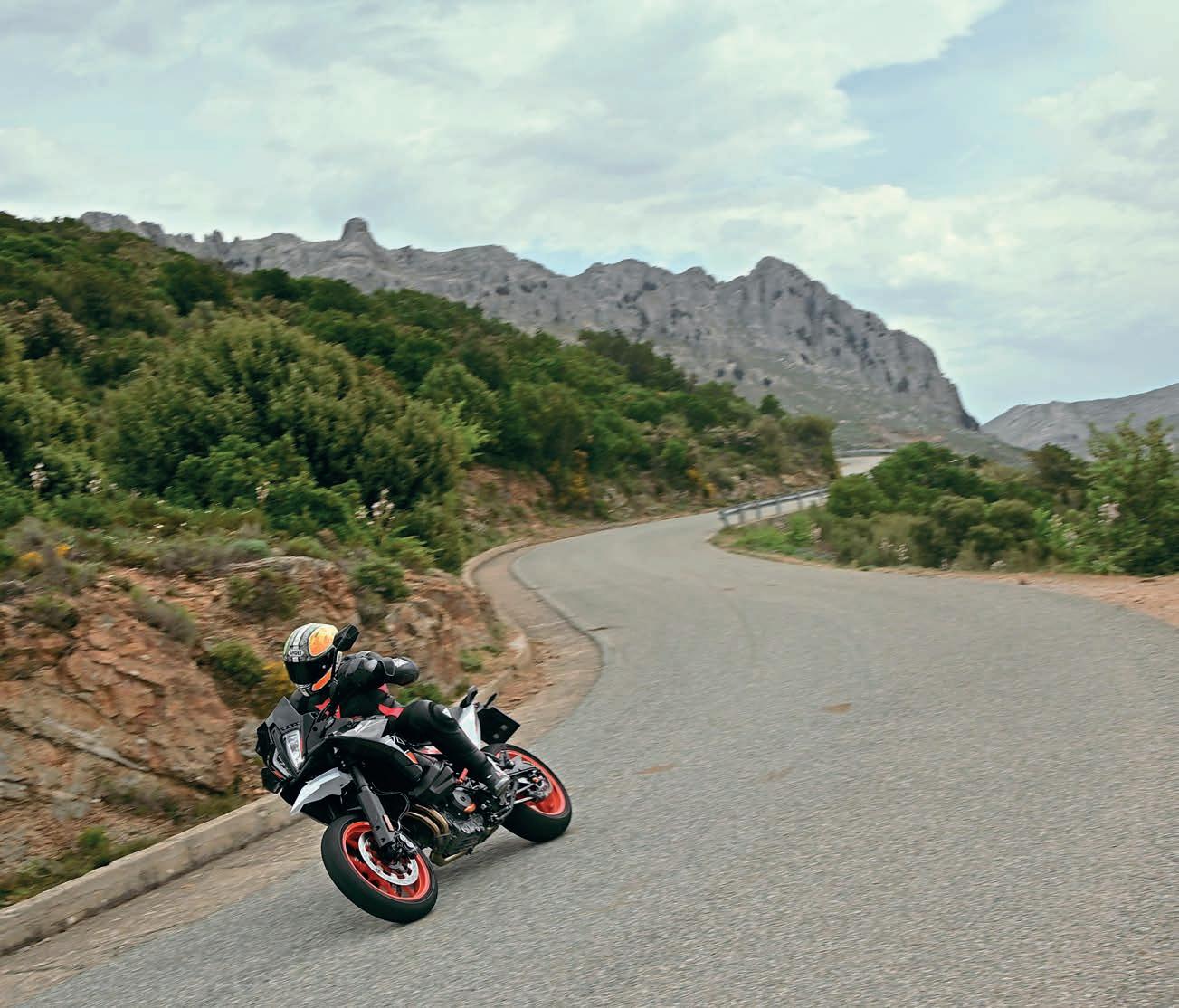
when they get to where they’re going… which, to be fair, is pretty much me. Suspension aside, the only fully bespoke kit on the SMT is the handlebars, fairing and fuel tank, which has been redesigned to carry the fuel higher than the Adventurer in order to raise the centre of gravity and help counteract the long travel suspension and get it to turn quickly.
The first question that popped into my head was why they didn’t use the Duke’s 890 engine, which has another 10bhp for a peak of 115bhp. The Adventurer engine might be 10bhp down on peak power to the Duke, and the SMT ‘only’ has 105bhp, but up to 7000rpm, the SMT has a not insignificant
Poor old tyre...
LAUNCH
THE SUSPENSION IS OUT OF THE WP TOP DRAWER.
2023 KTM 890 SMT
ENGINE
Type: 889cc, liquid-cooled, 2-cyl Bore x stroke: 90.7mm x 68.8mm
Compression: 13.5:1
Fuelling: EFI
Claimed power: 105bhp @8000rpm
Claimed torque: 100Nm @ 6500rp
CHASSIS
Frame: Chromium molybdenium-steel frame
F suspension: 43mm upside down forks, WP Apex, fully adjustable
R suspension: WP Apex monoshock, fully adjustable
Front brakes: Radial monobloc two-piston calipers, 320mm discs
Rear brake: Two-piston caliper, 260mm disc
ELECTRONICS.
Riding modes: Yes
Traction control: Yes
ABS: Yes
Quickshifter/autoblipper: Optional
Wheelie control: No
Launch control: No
DIMENSIONS
Wheelbase: 1502mm
Seat height: 860mm
Wet weight: 194Kg
Fuel capacity: 14 litres
INFO
Price: £12,499
From: www.ktm.com

Up she goes!
eight to 10 bhp more than the Duke. So, on the assumption that the SMT will be touring to the mountains and then getting chucked about the endless switchbacks, neither of those scenarios need peak power; low-down shove is the order of the day. What you have is a bike with the ingredients to eat up the miles... and be naughty, too.
In all but name, the SMT could be an 890 Duke GT, but I suppose by using the word ‘Supermoto’ as part of its name, it does conjure up visions of naughtiness due to the phenomenon of Supermoto, which never really caught on in the UK, being universally known for heroics and extreme ‘backing in’ slides, huge lean angle and monster wheelies. The whole marketing campaign has been built around hillclimbing, so much so that KTM flew in Chris Filmore, three-times Pikes Peak winner and record holder in three classes, to tell the assembled media just how you do actually back a bike into a corner.
KTM doesn’t stop there, though. It then went and closed a 5km stretch of mountain road, assembled a massive orange ‘start gate’ and sent us up one by one to give it a go. Burnouts, wheelies and backing in are all encouraged as part of how KTM wants us to get to know the SMT. Never let it be said that it does things like the others.


It is worth mentioning that the SMT’s electronics also get a tickle, and there’s a couple of small but significant tweaks that really do make a difference. The quickshifter has a variable cut time depending on the revs of the engine. Low rpm gets a longer cut for a smoother action, and higher rpm gets a shorter cut for maximum acceleration performance. It’s one of those things that when you’re told it’s been done as a new feature, you think to yourself, “Oh yeah, that’s so obvious.”
The other tweak is to the throttle control if/when you backshift too many gears and reach the limit of the slipper clutch, causing the rear wheel to lock up. The butterflies will open slightly and add some fuel so that a very small amount of drive is added to the rear wheel to restart it turning instead of staying locked up. It’s a safety system for the scenario where the rear wheel has locked up by the engine instead of the brake system, when normally the ABS would be able to intervene and release the brake. By opening the throttle a tiny amount, the wheel will unlock and start rotating again until the slipper clutch is back within its operating range and can start working to match the engine revs and wheel speed.
The other new arrival to the electronics isn’t so much a new system but a new way of interfacing with the traction control in particular. The nine-way adjustable traction control, which only comes with the optional extra ‘track’ mode has a new and welcome feature that lets you toggle between all the levels as you ride along, which is fairly standard these days, but unlike previously, if you wanted to switch it off, you had to go

KTM 890 SMT TECH DATA
JULY 2023 WWW.FASTBIKESMAG.COM 37
into all sorts of menus to disable it. Now, you take it down to level one, then hold the down button for four seconds, and the traction control is off. Simple, convenient and clearly a tweak made by people who ride the bikes they design... and like wheelies. Finally, joy of joys, the indicator switch is the first one on any KTM I’ve ever ridden that you can actually feel through a glove.
Names, position in the market and origins don’t really matter when you get down to it.
The only thing that actually matters is if it’s any good – and the first thing I must say about the SMT is that it looks nothing in the flesh like it does in its press pictures. I always avoid making judgements on a bike’s appearance, but on this occasion, due to the sheer number of comments online about its looks when KTM released the pictures, I think the fact that in real life I was very happy to discover that the SMT didn’t fall out of the ugly tree and hit every branch on the
way down is worthy of note. Whether you like it or not in reality is up to you, but you must see one in person before you decide.
The 200(ish)-mile route on Sardinia’s epic roads was as you’d expect, dominated by literally hundreds of corners and designed to present the bike in the best possible light, with a 30(ish)-mile motorway ride thrown in at the end of the day for good measure. Unsurprisingly, the SMT shone like a gem all day, not once giving me anything to complain about. We made friends very quickly and stayed on good terms, even when I lost count of my gears on one occasion and back-shifted to first instead of second from fourth gear on the approach to a corner during the timed hillclimb.
The bike slewed into a massive slide, which I was initially very proud of... until I realised something wasn’t quite right as the bike wasn’t coming out of the slide as I expected. It got a bit messy as I ran off the edge of the road and into a gutter/small storm drain, unable to steer the bike. My speed for the corner was fine, but because I’d gone down too many gears, I was still too fast for first and hence still caught in a slide, meaning I couldn’t get the bike turning. The SMT tidied up my error, and even though I’d blown my chance of a decent time on the hillclimb and upholding Fast Bikes’ honour, I was at least able to finish the climb and did not require being scraped off the cliff face.
The suspension is out of the WP top drawer, with the SMT getting the Apex-spec kit. That means its action is on the money in terms of control, which matters – especially in the case of the SMT due to its extra suspension travel over the Duke. It could feel a bit clumsy and baggy because of this, but in fact, it has a lot of support, in particular during weight transfer, yet also deals with bumps and ripples with a refined and high level of suppleness.
Sardinia’s roads are like billiard tables – if you’ve never been there to ride a motorbike, add it to your list. It was my first time, and it’s the best place I’ve ever ridden. That’s not to say there weren’t roads that were not rough and low on grip – there were, and the SMT had no problems. I suspect some of the suppleness that the suspension offered came from the Michelin tyres, noted for their soft carcasses. Either way, the whole set-up worked a treat, with another giveaway that it’s quality kit being the way it responds to adjustment.
As with all KTMs, there are recommended settings under the seat for comfort, sport and track – and you don’t even need any tools to make the changes. The damping clickers on each fork can be turned by hand, as can the remote preload adjuster for the rear shock. I tried the sport setting to see if I could dial out something I described in my notes as ‘pinging’ when going from full lean one side to full lean the other side aggressively, as the bike passes through the vertical, where the suspension keeps extending just as you want to start pulling the bike down onto its opposite side. It means the suspension takes longer to settle after the continued transition from the upright to the opposite lean. The sport settings recommended five extra clicks on each fork leg (one fork has compression, the other has rebound) and 1mm more preload on the rear shock, which equates to one turn of the adjuster. It couldn’t have been simpler and calmed the ‘pinging’ down

LAUNCH
THE MOTOR IN THE SMT IS INCREDIBLY FLEXIBLE AND EASY TO USE.
a lot, making the front feel more precise and hold a line better with less understeer.

I’m a fan of the WP kit in general; a lot of gains have been made in recent years in terms of quality and range, and being owned by KTM means it can build bespoke suspension for its bikes and get its teams of test riders to dial in the spec and settings so it’s just right for that bike and its intended use. It’s a big strength of KTM’s to have WP as its own, not least because it’s able to bring out the best in its bikes by literally making bespoke factory suspension for them.
The SMT’s engine is a known quantity, in so much as it’s been in the KTM range for a few years now in one form or another. The parallel twin first appeared as a 790cc, then an 890cc a few years later, and KTM is clearly building a range of bikes around it, which makes complete sense. It’s a small package, that’s efficient, clean, and relatively low cost to manufacture. It’s a decent motor generally, if a little lacking in character and fizz, but the version of it in the SMT, with the meatier low and midrange punches, is fantastically refined and perfect for the bike’s intended use. Granted, it has the benefit of more capacity over other fairly dull parallel twin engines that have come to the market recently, but there can be no denying that the motor in the SMT is incredibly flexible and easy to use. It’s got really good pick-up when you open the throttle, and even as the revs rise, when typically a parallel twin starts to run out of puff due to the sheer size of the pistons within it, and their reciprocating mass bumps into the laws of physics, the SMT has a good go at defying them by seeing out the last few thousand rpm as enthusiastically as the first few thousand –right up to the quite sudden and abrupt rev limiter.

The rest of the bike is really well put together, and the riding position is a dream
for me and my 6ft 3in body. It’s a treat when, on the odd occasion, I get to ride a bike with a decent seat height. It’s not up-in-the-clouds tall, but the seat is a good 50mm or so taller than the average bike these days, so it’s still not out of reach for average-sized people, and even if it was, there is the option to lower it. As well as being tall, the shape of the seat also adds to the overall riding experience. It’s quite deeply scalloped, so there’s no room to slide back in it. KTM want you sitting in the exact place it’s put you and nowhere else, which will be largely because it has developed the suspension with the location of the rider’s mass in mind. Plus, it’s handy for when you’re wheelying to just sit there with the seat supporting you.
Talking of wheelying, this is partly where the SMT’s trump card lies. The combination of the super-smooth engine that can potter around town without any lumpiness, or flat-out ride, or go through the gears, along with brilliant suspension that provides supple and strong support, gives the overall package
a split personality. The SMT is a proper Jeckyl and Hyde bike that can fill you with truck-loads of confidence and let you do utterly bonkers knee-down, fully-committed letting-the-brakes-off-early, stamping-up-anddown-the-gearbox, railing-into-corners and wheelying-out-of-them head-banging riding... and it’s just as happy and easy cruising up the mountain passes, rolling on and off the throttle in fourth gear. It is a genuinely brilliant bike; KTM has managed to extract the best bits of the Duke and Adventurer and drop them into the SMT.
The electronics are all to KTM’s high standards, with a good range of features that are easily accessed via the interface, although some of the anagrams take a bit of working out. It’s not just a KTM thing – all manufacturers insist on having their own names for the same things. Why can’t they all just call it traction control and be done with it? Instead, it’s MTC, and the engine brake control is obviously known as MSC, and so on. It’s a small grumble, and in the
In his happy place...
Back to school.
KTM 890 SMT JULY 2023 WWW.FASTBIKESMAG.COM 39
grand scheme of things is a detail that probably reflects more on my small brain capacity. There’s a total of four rider modes (rain, street, sport and track), which leads me neatly onto a topic that divides opinion…
The SMT costs a not unreasonable £12,500 and has all the available features and functions unlocked and available to use when new. The bike will be supplied to the customer in demo mode, meaning you’ll have track mode unlocked and available; this has the adjustable traction control, and lets you build your ideal set-up instead of the preset settings in the other three modes. As well as that, the tech pack is also active on the bike, which gets you the quickshifter/ blipper, cruise control, and engine braking control (MSR).
But here’s the catch. At 1500km, the bike deactivates track mode and the tech pack, and if you want them both switching back on, it’ll cost you £859. Of course, you can leave them off. As KTM says, some or all of those functions are not for everyone, and the demo mode is there so customers can sample everything before deciding what, if any, functions they want to keep. The thing is, at £12,500, the SMT is a fair price, but at £13,359, it’s getting into the range of other bikes with the same demo mode functionality and often more, because the SMT is yet another bike that has an IMU that lets it have functions that are lean sensitive, yet bizarrely no separate anti-wheelie function, which is a missed opportunity. Being able to disable the ant-wheelie but leave the traction control on would be possible on the SMT due to having an IMU on board, but KTM has chosen not to include that ability, which is at odds with how it’s positioned the bike.
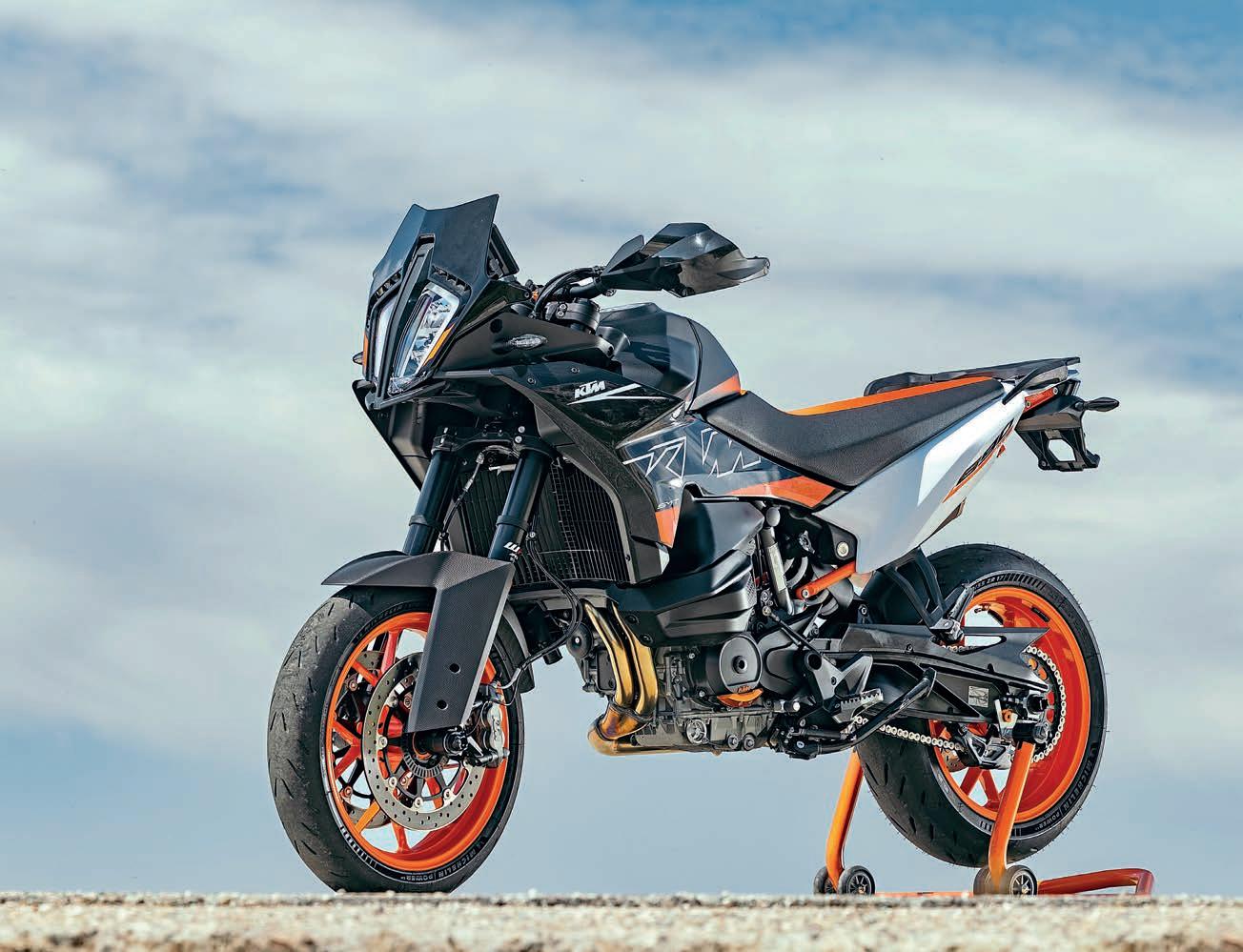
The value, when taking the above into account, is entirely up to the individual. Not everyone will agree, and it’s definitely not something that the SMT should be defined by. The truth is that for all the cleverness of the functions and their operation, I switched the traction control off – and left it off all day. The SMT is a 105bhp bike with supple suspension, super-grippy tyres and a nice throttle connection, so there’s a strong argument for it not actually needing any of it anyway. It’s a cracking bike that has a huge envelope of performance and capability. The suspension is the real star of the show, as it delivers all the control and feedback you
could ask for. You’ve got to doff your cap to KTM for bringing out a bike with Supermoto as part of its identity. We never really took the genre into our hearts here in the UK, and there’s no evidence to suggest that anything has changed, so it’s a brave move. However, as we know, times are changing, and with the continued shift away from sportsbikes to naked bikes, KTM might just have played a blinder with the reintroduction of the SMT.
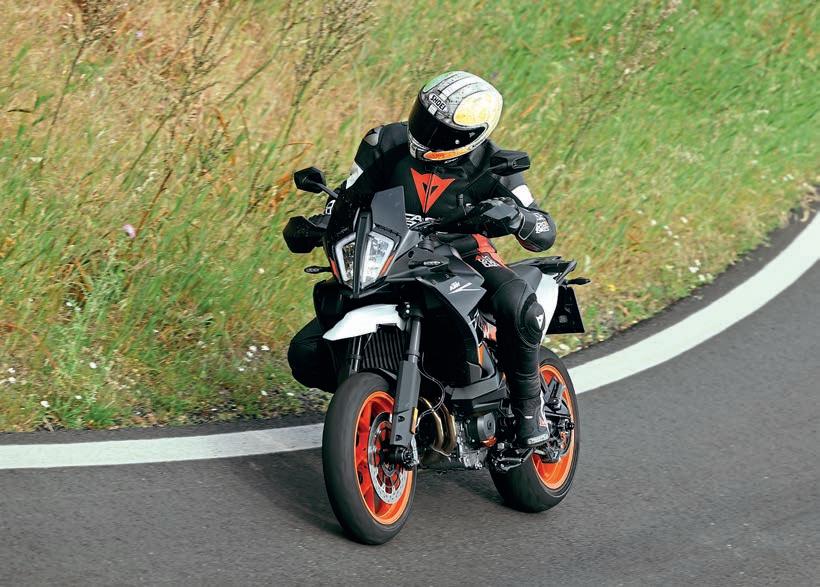
Where before the concept was arguably ahead of its time with the 990 SMT, today the 890 SMT might just be the joker in an increasingly popular naked bike pack – by offering something different and, in many ways, far more versatile and useful.
Time will tell, but all I can say is that after the ride, we were sitting in our leathers with our lead rider from KTM – the firm’s global marketing manager – cold beer in hand and massive smiles on our faces, recalling all the many highlights of the ride and roads, and I’m already looking forward to the next time I’ll be able to throw a leg over an 890SMT... which should tell you everything you need to know about it.
Johnny reckons it’s better in the flesh. He says the same about himself.
A bit of grass trimming was mandatory.
LAUNCH 40 JULY 2023



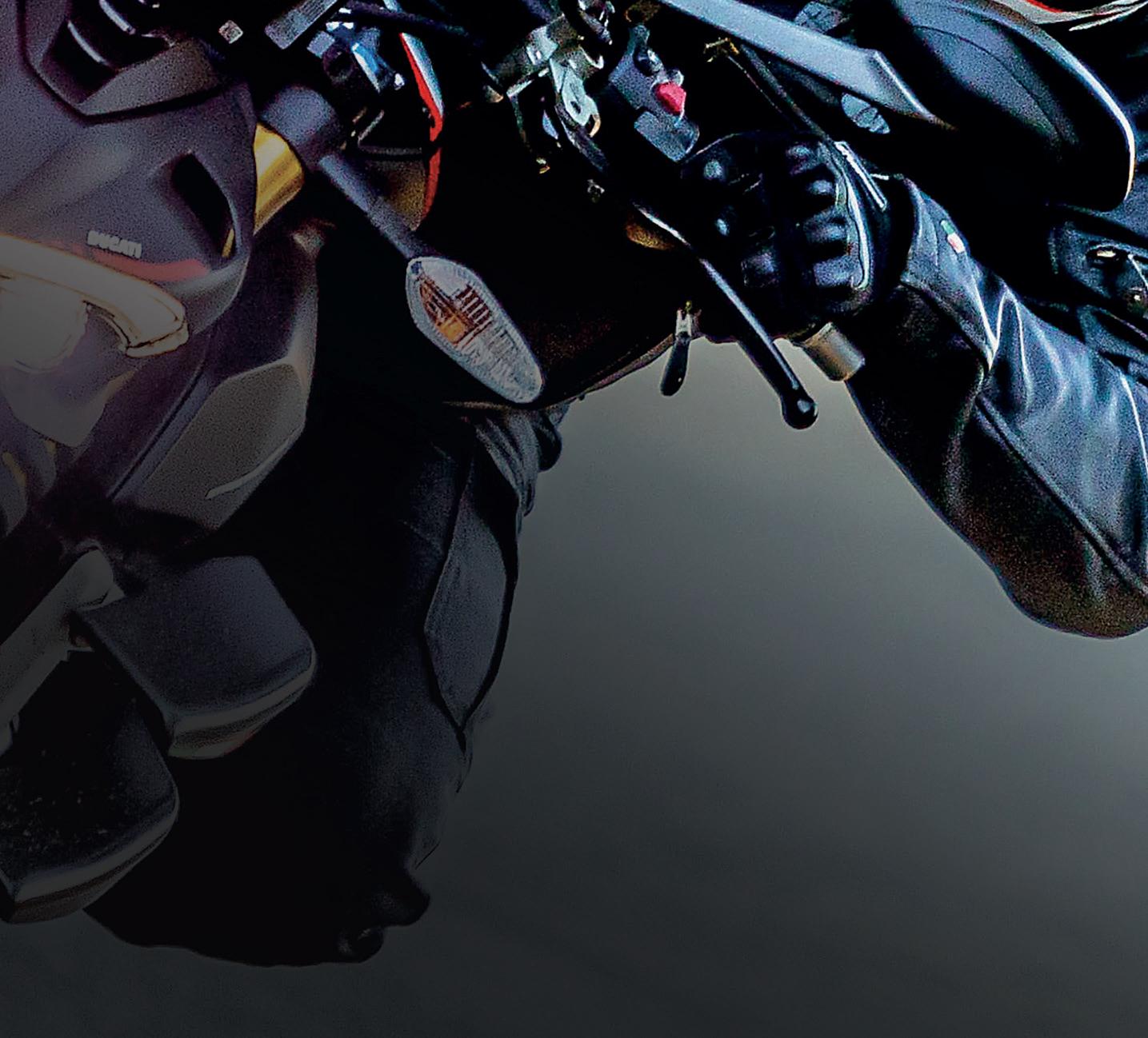

















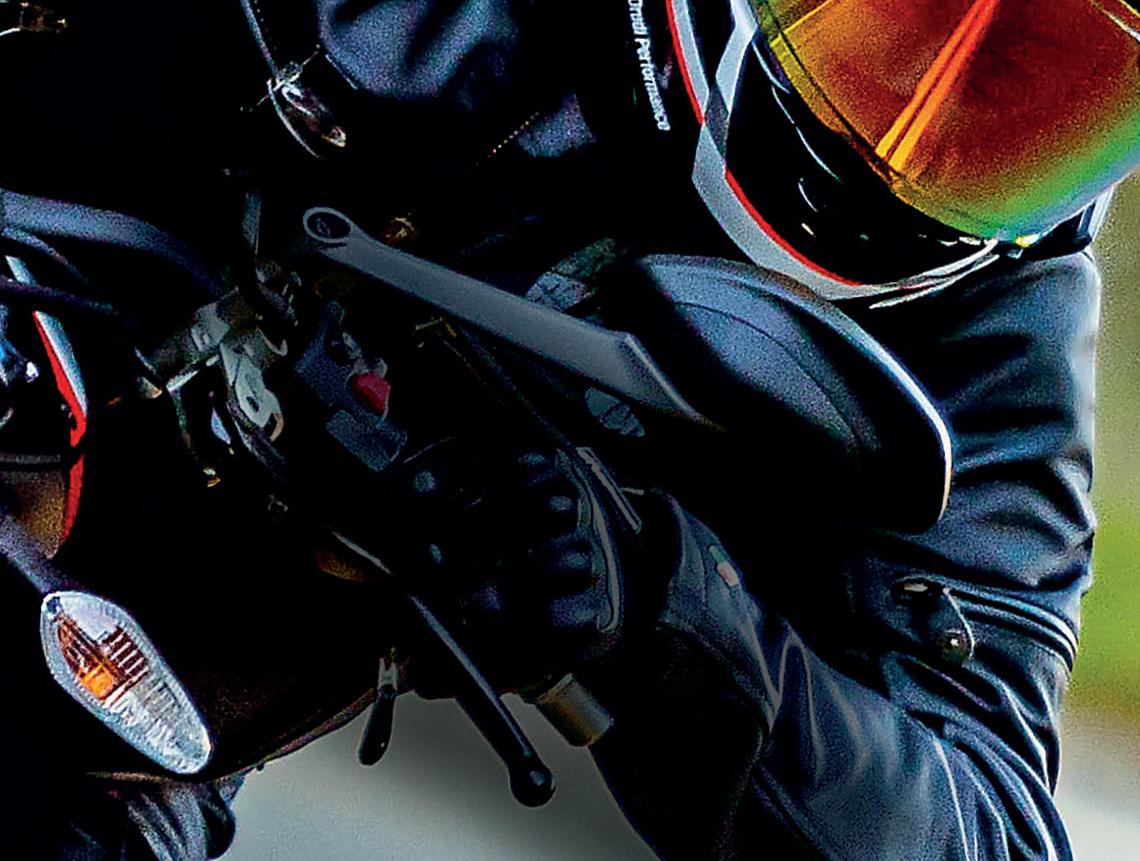



FEATURE 42 JULY 2023 WWW.FASTBIKESMAG.COM
TOUR DE
YAMAHA TRACER 9 GT+
If you’re in the market for a cracking sportstourer, Yamaha’s Tracer 9 GT+ should be at the pointy end of your list.

WORDS> BRUCE
PICS> JONATHAN GODIN / YAMAHA
YAMAHA TRACER 9 GT+
JULY 2023 WWW.FASTBIKESMAG.COM 43
Islumped down in my seat, wiping the sweat from my head under the baking Sardinian sunshine. It had been a good day. A very good day, and surprisingly so. Being honest, when the invite came through to test Yamaha’s Tracer 9GT+, it didn’t exactly set my heart racing, but that’s the state it had left me in after nine hours of hammering switchbacks, coastal roads, and a smattering of goat trails. It had transpired to be the consummate wolf in sheep’s clothing, disguised so subtly behind its tall screen, broad panniers and high-rise handlebars that it seemed the only thing missing was a pipe and some slippers. In reality, it was me missing the point behind this head-banging mile muncher. It’s time to backtrack a bit…
The Tracer is nothing new. It’s been one of Yamaha’s bestsellers since its inauguration back in 2015, built around the foundations of the brand’s now sacrosanct MT-09 that’d arrived on the scene just a year earlier. The idea was to provide the market with a comfortable, affordable and powerful middleweight sports-tourer, and that’s exactly what happened. Over time, the model continued to evolve in spec and stance too, becoming Yamaha’s bestselling model in that sector. The bike you see before you is the fourth generation of the Tracer, and the third version of GT, which joined the ranks in 2018, ticking the higher-spec, more tourfriendly box. For those who know more about the Tracer than I (…which is probably
most of you), the 2023 GT+ version is, predictably, the best yet. Why so? Well, despite carrying over the same wheels, frame, engine and a whole load of other parts from the previous GT version, this latest iteration has been dipped in glue and rolled in techno goodness. Sitting in the model’s presentation, the feature Yamaha seemed most proud of was the machine’s radar linked unified braking system, which is another way of saying the GT+ is equipped with an adaptive cruise control function that knows when to anchor on the brakes if and when it detects a collision could be imminent. It’s clever stuff, and a first for Yamaha. Another new addition is a 7-inch full-colour TFT dash, accompanied by a five-position multi-position joystick. With a few touches of the stick, you can go into the fancy new screen and alter a whole host of characteristics, such as traction control, rider modes and the connectivity of the bike, which is supported by Garmin’s Motorize app as well as Yamaha’s own Myride app. As per the last GT, the bike is kitted with electronically governed Kayaba suspension that can be altered to suit rider preferences, and there’s also scope to change the temp of the heated grips, lif control, and a multitude of other preferences with ease.
As you’d expect on any contemporary machine, the Tracer is kitted with an IMU that links all the tech together and allows for features such as cornering ABS. And last but not least, the GT+ also comes kitted with Yamaha’s third-gen shifter system as standard, meaning you can go up the box while decelerating, as well as down the box while cracking open the throttle… to help with overtakes. The other stuff you should probably know about is the bike’s bigger screen, height-adjustable saddle, two position footrests and stock fitment panniers that are colour-coded to either Icon Performance (blue/silver) or Power Grey, the colour I got.


FEATURE
44 JULY 2023 WWW.FASTBIKESMAG.COM
THIS LATEST ITERATION HAS BEEN DIPPED IN GLUE AND ROLLED IN TECHNO GOODNESS.
A bicycle made for two...
TECH DATA
Yamaha Tracer 9 GT+
ENGINE
Type: 890cc, liquid-cooled, three-cylinder
Bore x stroke: 78mm x 62.1mm
Compression: 11.5:1
Claimed power: 119bhp @ 10,000rpm
Claimed torque: 93Nm @ 7000rpm
ELECTRONICS
Riding modes: Yes
Traction control: Yes
Slide control: No
ABS: Yes
Quickshifter/autoblipper: Yes
Wheelie control: Yes
Launch control: No
Pit limiter: No
Cruise control: Yes
CHASSIS
Frame: Aluminium Diamond
Frame
F suspension: 43mm USD, semi-active Kayaba
R suspension: Semi-active Kayaba monoshock
Front brakes: Four-piston monobloc calipers, 298mm discs



Rear brake: Twin-piston caliper, 267mm disc
DIMENSIONS
Wheelbase: 1500mm
Seat height: 820-835mm
Wet weight: 223kg
Fuel capacity: 18.7 litres
INFO
Price: £13,995
From: www.yamaha-motor.eu
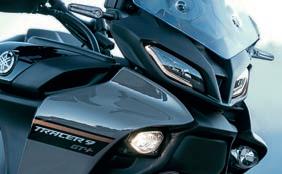

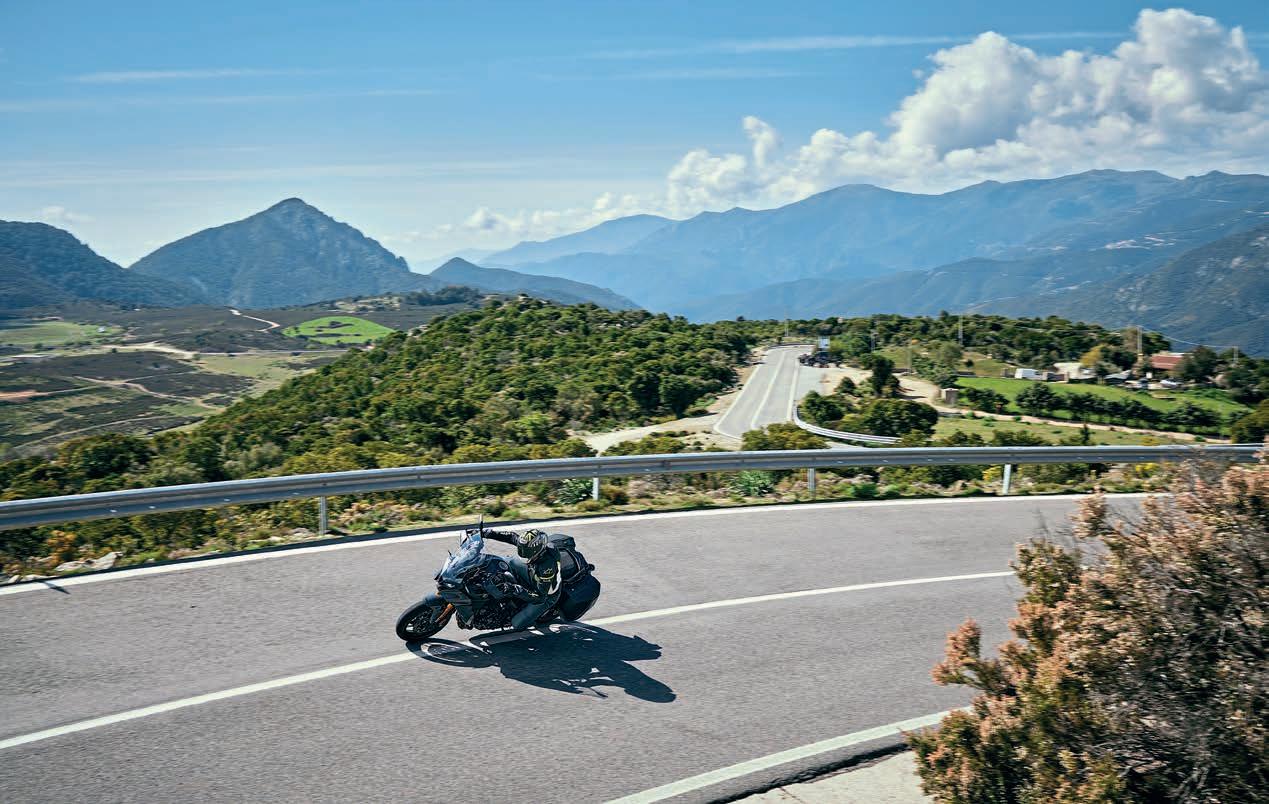
In its natural habitat.
I can’t pretend I was a fan of my machine’s grey paintwork, but after about half a mile behind its broad bars, I wouldn’t have cared if it was the colour of a rainbow and littered with unicorns. This thing was awesome, but I should have already known that would be the case. While this was my first ever ride on a Tracer, I’ve come to know and love the CP3 motor that powers this machine ever since its inception, but especially so since it got made bigger, more potent, and sleeker in 2020. The Euro5 triple you find in the MT-09 is exactly the same as the one you’ll get in a Tracer GT+, meaning big torque, high-speed and
effortless acceleration are irrefutable traits of this mid-capacity tourer, despite its exuberant 223kg mass. It is a heavy machine, and I reckon with a pillion and a few pairs of pants in the spacious panniers, you’d easily find yourself hauling around the best part of half a ton. But the engine is up to the job, just as it’s up to the job of dawdling at pedestrian speeds or clocking on like a good’un. It is the star of the show, despite still subjecting the user to the typically harsh initial pick-up that all recent Yamahas seem to have. Of the four rider modes on offer, I elected to go for the most fiery of the lot from the off, powering
YAMAHA TRACER 9 GT+
JULY 2023 WWW.FASTBIKESMAG.COM 45
around in sport mode and loving its clinical connection to the rear wheel. The way the triple makes its power is brilliant, and the spread of poke throughout the revs seems seamless, accompanied by a raucous exhaust note that’ll be sure to piss off the neighbours.
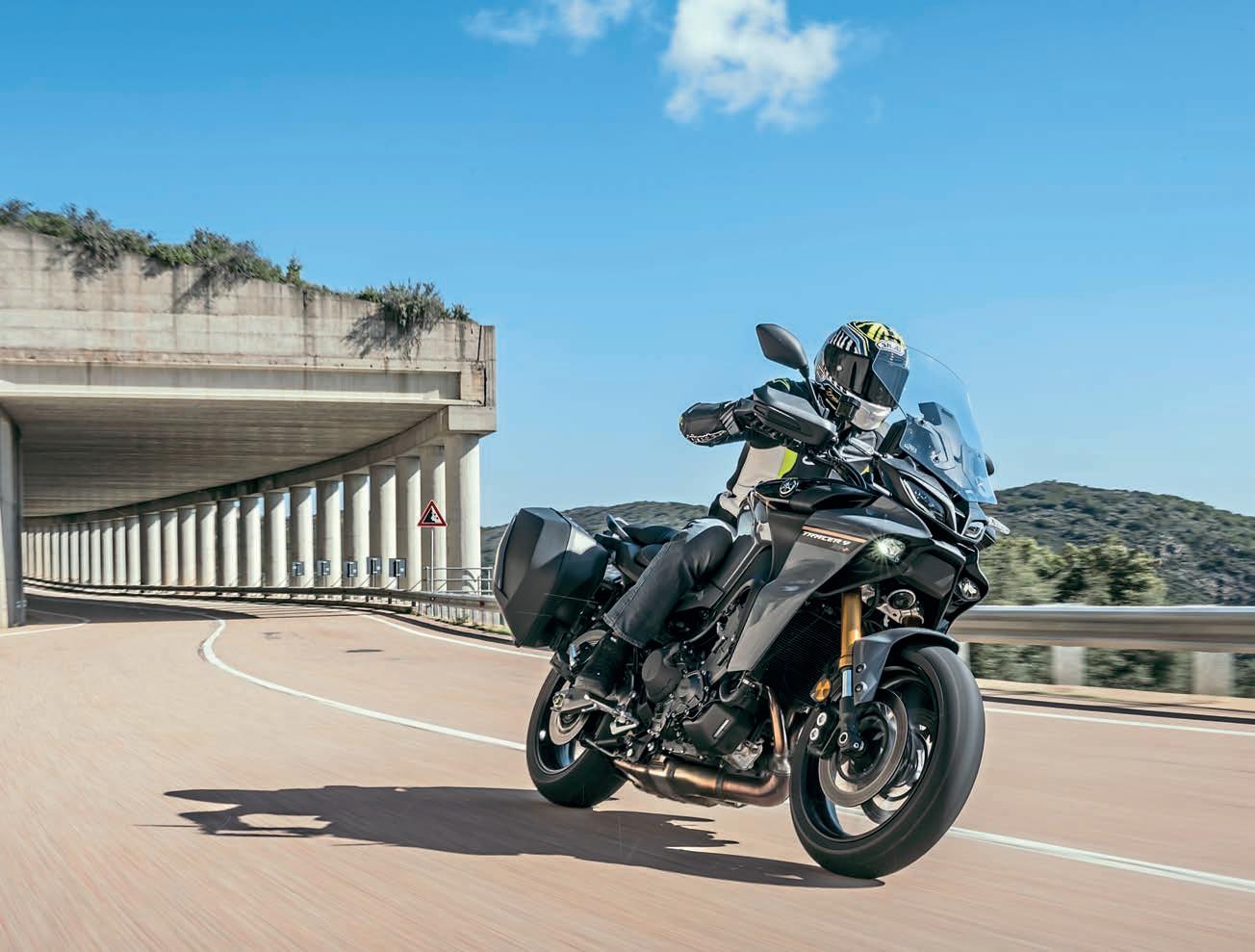
There’s very little not to like about the CP3, especially so when coupled with the aforementioned rider tech. None of it seems to intervene and ruin the ride; it allows you to crack the throttle hard without worrying about anything other than going fast. And going fast we certainly were.

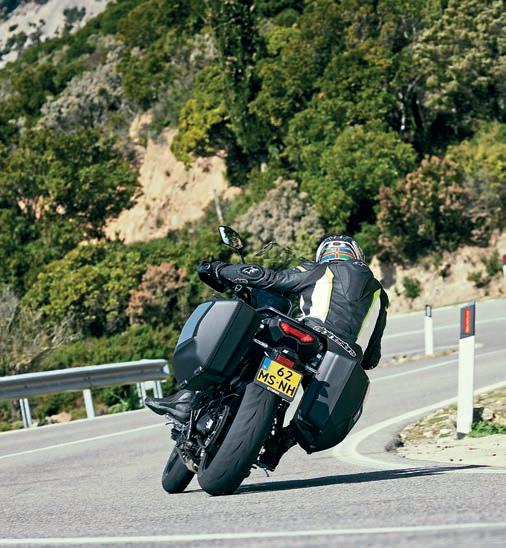
Nestled behind Yamaha’s lead rider, I was in my element, decking the pegs on every corner, doing my utmost to keep up with my guide, who seemed insistent on leaving dark lines on the exit of every corner. I’ve ridden roads the world over, but this coastal mountain pass really was something special, typically demanding third to fourth gear riding, coupled with hard braking and even harder acceleration.
The Yamaha was surprising me on so many levels, and while I’ll stop short of saying you can haul it up as fast as a sportsbike, there was good bite, feel, and stopping power to be found. Gassing out of corners was a blast too, especially with the stability control switched off. To do so, you need to be parked, access the dash’s menu, and switch off the SC – meaning you have no traction or wheelie control… but ABS remains on. This made the bike so much more playful and engaging, fulfilling my childish needs of adhoc wheelies. That being the case, I should note that such antics are best performed from slower speeds. Because of the bike’s mass and long wheelbase, it’s not a fan of pointing skyward once you’re up and over 40-50mph, although if you get the wheel up from a slower pace, the slickoperating quickshifter means it’s easy to save on front tyre wear going up the box. When the bi-directional shifter’s virtues were
explained in the briefing, I was a little perplexed to understand why you’d need such a complex system, but I found myself using and abusing the package, downshifting while still on the throttle and upshifting on the brakes… just because I could. All shifts were seamless, making me a fan of the gearbox on this thing, and the composure the bike would maintain under heavy braking and multiple down changes when storming into hairpins.
The Tracer, as per the MT-09, is a talkative bike, offering good feel and feedback through the frame and Kayaba suspension. I liked the way it dropped on its ear, but also how easily and composed it seemed when rolling through corners. Maybe it was the mass that made things so planted, but there’s no taking away the unexpected agility of this bike – it was impressively lithe.
The morning’s ride was by far the most physical, while the afternoon’s antics were a little more sedate, albeit no less fun. The corners were more sweeping, the pace more
consistent, and it was at this point I was able to take a breather and explore the rest of the bike’s offerings. If comfort’s near the top of your wishlist, you’ll be pleased to know that the GT+ is an accommodating machine. You sit in a very upright stance with no pressure on your wrists, and there’s a generous amount of legroom to be found, even with the pegs set in the higher of the two locations. The screen provides loads of wind protection, keeping my neck and torso void of the elements. The saddle’s big, comfy and narrow, so it gets my vote, as does the screen that never failed to quickly and easily give me all the info I was looking for. Yamaha’s not scored too well in this department up until now, but this addition is hard to fault, and the same can be said for the switchgears, which are also the best yet to come from the Japanese manufacturer. The cruise control was easy to govern and I was impressed that the adaptive element worked with motorcycles in front of you, not just cars. As for the automated braking, that took a little

FEATURE
46 JULY 2023 WWW.FASTBIKESMAG.COM
It’s surprisingly agile.
getting used to; I’d be fibbing if I said that I fully trust it, but there’s no denying that when a vehicle in front of me started to decelerate, my bike would do just that… isn’t technology great. Yep, this bike seemed to tick all the boxes, not necessarily being exceptional in any particular area, but showing itself to be a cracking all-rounder. It could hustle like the best of them or cruise with finesse. Admittedly, it wasn’t quite as playful as the MT-09 or other similar naked offerings, but it won my vote when pitched against big, heavy adventure bikes or tourers. As sizeable as the GT+ is, it’s still small enough and
powerful enough to get your heart racing, which is what I’d be looking for if ever I were to look at a machine of this type. I’d also be looking for a respray, or the Icon Performance colour scheme at least, but that’s my hang-up. The truth is, Yamaha has produced a cracking bike and I don’t doubt it’ll prove a popular model, even with its sizeable price tag that weighs in at just under £15k. Nope, it’s not cheap, but I’d go as far as to say you’re getting value for money here, especially when compared to some of its nearest rivals. But don’t take my word for it… get out there and test one. Just make sure it’s not grey.


my ride… but on the Tracer test, I indulged in a bit of tech. And when I say a bit of tech, I mean a lot. The bike’s 7in dash is a hub for information and features, especially when working in conjunction with Garmin maps and Yamaha’s Myride app. Having downloaded the latter to my phone, it was a simple case of sorting a Bluetooth connection between my phone and the bike; when configured, I could record my route and its data, including top speeds, lean angles and time in the saddle that could be shared retrospectively with friends and other riders.
The other piece of technology that proved utterly brilliant on the test was Cardo’s Packtalk Edge intercom system. Over the years I’ve used a few, with differing degrees of function and likeability, but this one proved a charmer from the start. It was a doddle to fit to my Shoei, being supplied with perfectly-sized speakers that sunk nicely into my X-Spirit’s earpiece wells. The wiring was simple to route, plentiful in length, and I liked the fact the unit’s backplate could be mounted via a clip that slots either side of the shell or with a sticky pad, which is what I opted for.

With the hardware in place and the unit linked to my phone and the bike, I was quickly and easily able to access music from another of my apps, plus my phonebook, and there was obviously the chance to link with other comms users (up to 15) should I have wanted to shout abuse at my fellow journos… which I refrained from doing on this occasion.
Throughout my test of the Tracer, the Edge proved a perfect partner, pumping my favourite music down my lugholes with brilliant clarity. And for the sake of trying it, I put in a call or two to test that feature out, set about via a voice command. The buttons were intuitive to find and operate, though there’s so many features to the package that I really need to sit down and go through exactly what it has to offer. What also really impressed me with the unit was the longevity of the battery charge, and the fact it doesn’t muller your phone’s battery either. Since returning from this test, I used the Edge quite a lot on long rides and still haven’t needed to charge it since it made its debut in Sardinia. I’ve also used it with Google Maps to help navigate my way around via its voice instructions. Quite simply, it gets my vote if you’re after a sleek, stylish and easy-to-use comms system that will enhance your ride no end. For more info, check out www.cardosystems.com

JULY 2023 WWW.FASTBIKESMAG.COM 47 Just think of all the
in
wine you could fit
those panniers.
KAWASAKI BSB
ZX-10RR
RIDERS: LEE JACKSON AND MAX COOK
The first Kawasaki to win a BSB title was the Team Green ZXR750 R of John Reynolds, way back in 1992. But it’s a slightly earlier version of the legendary superbike that Kawasaki’s 2023 BSB race bike pays homage to, with this lush ZXR750 H1/2 retro paint job. There’s bugger all retro about this BSB weapon, though. Based on the limited edition 2021 ZX-10RR, with its 211bhp inline-four motor, Pankl titanium rods, forged two-ring race pistons and 14,700rpm redline, it’s been tweaked up with an extra 20-odd

bhp and a chassis makeover to suit its hardcore racing job.
According to our man at the factory, the current RR design reflects a lot of input from WSBK ace Jonathan Rea – including less obvious stuff like the ergonomics and positioning of footrests and handlebars. For 2023, Kawasaki fitted ECU-controlled variable intake funnels which alter the length of the inlet tracts at different engine revs. That aims to help the Ninja with drive out of slow/mid-speed corners, where four-cylinder machinery is a bit weaker. The variable intake system
is locked for street use; you need the special factory loom and race kit ECU to activate it, and even then it’s not legal for use in some race series. In BSB, the system is allowed and will be used later in the season when the Motec control ECU has been set up to run with it
We spoke to Ian Prestwood, who’s crew chief for Lee Jackson in the Cheshire Mouldings Kawasaki BSB team. He very kindly made some time between rebuilds after the Oulton Park round to answer some of our dumb questions…
CHESHIRE MOULDINGS
WORDS: SIR ALAN OF DOWDS PICS: TIM KEETON
RIDER: MAX COOK

CONTROLS
The minimalist set of buttons are suitably race-y: on the right we have power (red), fuel pump/ignition (yellow) and start (green); the left-hand bar has engine brake setting (orange), pit speed limiter (green), fuel/ignition map selection (white) and rain light on (blue).
REAR CONNECTORS
A neat plate in front of the swingarm pivot holds three connectors for the brake pressure sensor, rear wheel speed and rain light wiring.

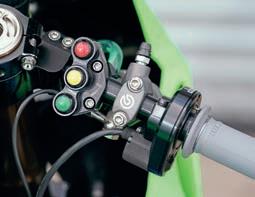
EXHAUST
Proper full-length Akrapovic race can and titanium headers for maximum output. Evotech silencer bracket.

SWINGARM
The massively braced aluminium swinger is a Kawasaki factory part (they get the bridge division in to make it, we reckon). Rear shock is a high-end BSB-spec K-Tech unit fully adjustable for everything.
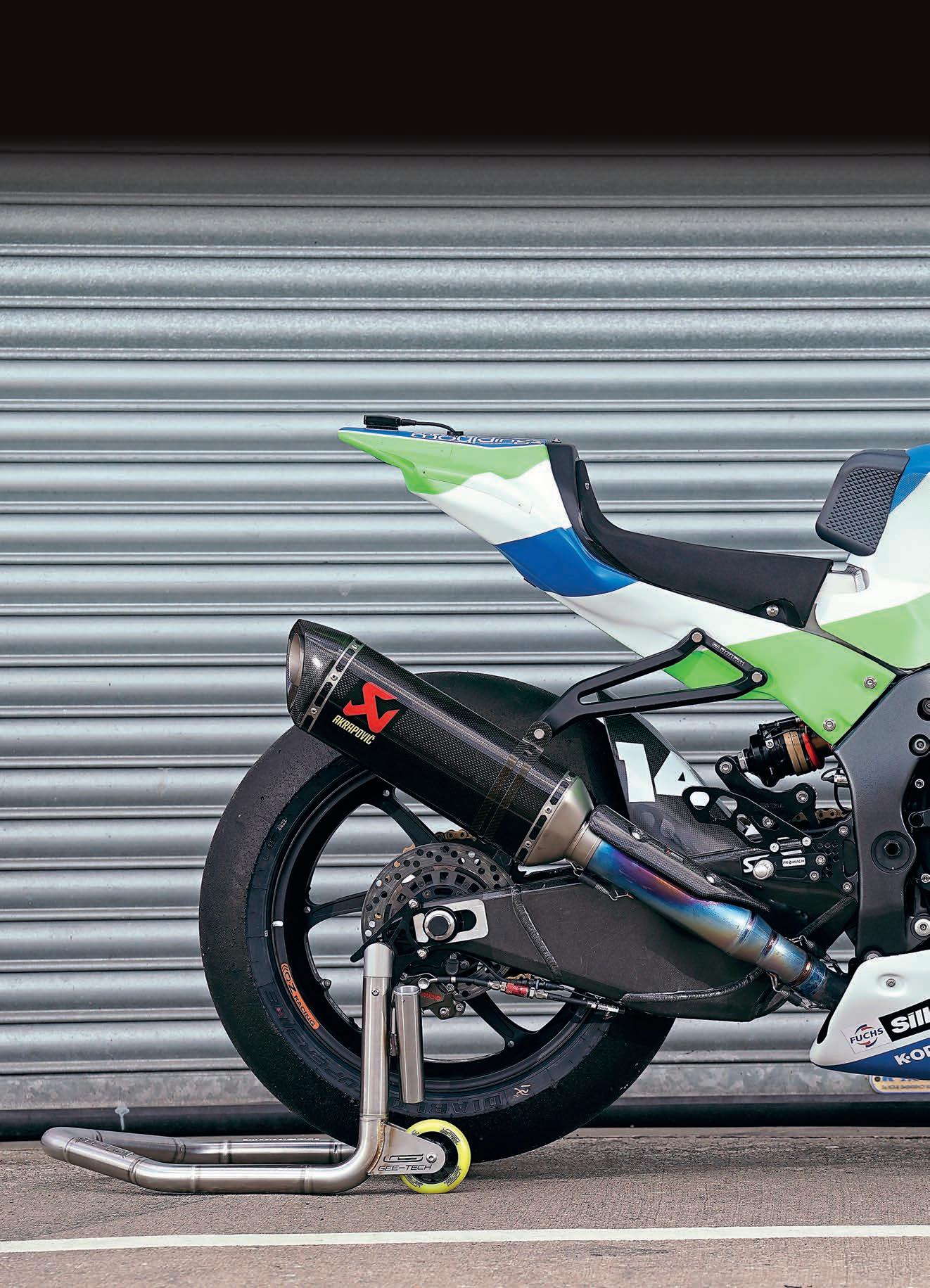
THUMB BRAKE
Lee Jackson prefers to use a thumb rear brake so there’s no pedal, just this tasty Racetorx master cylinder on the left-hand bar.
WHEELS/TYRES
BSB-spec OZ Racing rims with the control tyre choice of Pirelli Diablo Superbike slicks, Diablo Wet intermediates or Diablo Rain wets.
DASH
Homologated Motec C125 colour LCD display, mounted in a sweet carbon dash with GB Racing protective casing. The display is fully customisable – this pit readout shows 16 parameters, with different display settings while riding. The multipin communication port to the side is for downloading data and uploading settings in the pits.
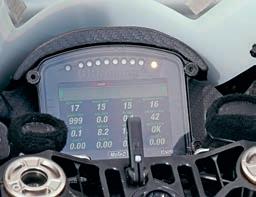

TOP YOKE
Super-light milled top yoke is more air than aluminium. That old-school lever in the middle isn’t the choke, silly, it’s actually an actuator that lets the gearbox go into neutral. The BSB bike needs that because neutral is at the top, before first, rather than between first and second gear, so is locked out with the actuator while riding.
ENGINE
The exact spec of the 999cc inline-four motor is obviously a bit of a secret, though it will comply with the BSB homologation rules, hence the titanium rods and race pistons on the RR model. The rods are 102g lighter than stock and the pistons save 20g each – very useful losses when you’re revving to nearly 15,000rpm. What the team does say is that the motor is built to a Kawasaki factory race spec, in-house, and there’s 1500km between rebuilds. Output is about 230bhp, with 125Nm of torque – nice.
FORKS
The ZX-10RR comes with posh Showa gas forks as standard – but these have been replaced with K-Tech fully adjustable race units. According to the crew chief, that’s down to different stiffness of the inner and outer tubes and also the wheel/caliper mountings.

BRAKES
Big-boy racer-only Brembo WSBK/ BSB calipers: GP4 P4 30/34 calipers on T-Drive discs.
WWW.FASTBIKESMAG.COM

WWW.FASTBIKESMAG.COM





JULY 2023 WWW.FASTBIKESMAG.COM 53
Used Bike Guide
PRICE GUIDE: £2995–£5500
Cheapestprivate: £2995
32,000 miles, 1998 bike with Dream Machine paint job, loads spent on it
Ourchoiceprivate: £4095
27,145 miles, just serviced, blue and white bike with a good service history
Cheapestdealer: £4388
15,663 miles, 1998 bike in yellow and good condition
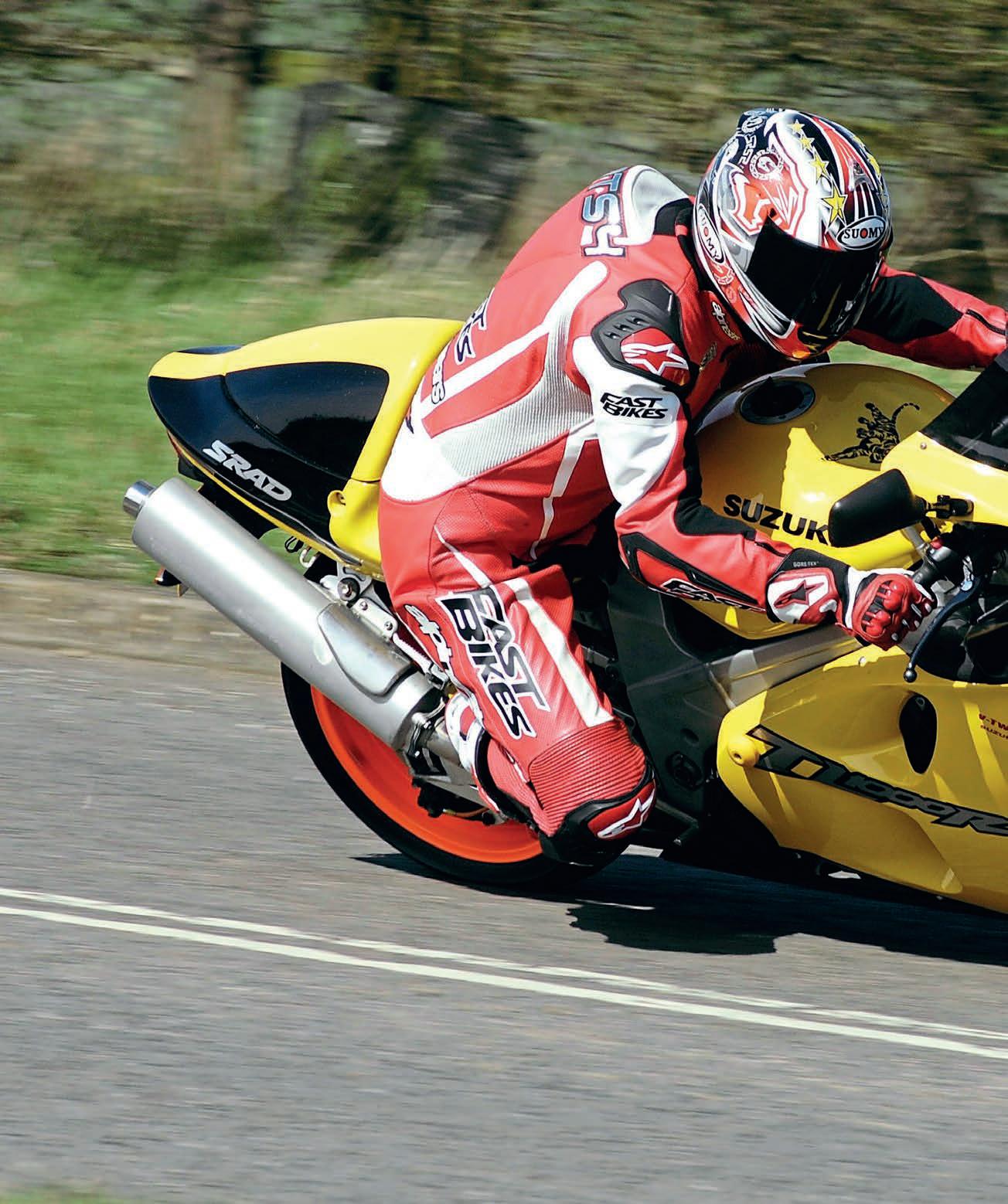
Ourchoicedealer: £4499
16,242 miles, lovely low-mileage red bike with a long MoT
Ex-demo: n/a
WORDS> JON URRY PICS> MORTONS ARCHIVE
54 JULY 2023 WWW.FASTBIKESMAG.COM
JAPAN’S FIRST V-TWIN SUPERBIKE
In the late 1990s, World Superbikes popularity was at its height. Hundreds of thousands of fans flooded into race circuits all over the world to watch the action on track while millions more sat at home, glued to their TV screens. But if you were a fan of Japanese bikes, there was a problem – from 1994 until 2000, the series was dominated by Ducati’s V-twins. Honda grabbed a single victory in 1997, but that took an RC45, the genius of John Kocinski and an open cheque book for HRC’s racing budget. A relatively small company like Suzuki, which was desperate to get in on the action, had no chance, and its GSX-R750 racer was simply outgunned and under-funded. So, thinking outside the box, Suzuki’s race department came up with a plan...

In 1997, the firm released the TL1000S, a brand-new naked bike powered by a litre V-twin, followed a year later by a superbike sibling. The TL1000R had arrived... although, sadly for Suzuki, it landed right in the middle of a shitstorm!
We all know the issues that the TL-S had and how the repercussions blighted the TL1000R, so instead let’s focus on the good points about a bike that, even nowadays, makes for a brilliant and very characterful road bike. So, where should we start? Why not with that V-twin motor?

In 1998, Suzuki attempted to take on Ducati head-to-head. Things didn’t go well...
1998 – 2001 SUZUKI TL1000R
JULY 2023 WWW.FASTBIKESMAG.COM 55
TECH DATA
1998 – 2001 Suzuki TL1000R
ENGINE
Type: 996cc, liquid-cooled, 8v, V-twin
Bore x stroke: 98mm x 66mm
Compression: 11.7:1
Fuelling: Electronic fuel injection
Tested power: 120bhp @ 9000rpm
Tested torque: 100Nm @ 7400rpm
CHASSIS
Frame: Aluminium twin spar
Front suspension: 43mm inverted forks, fully adjustable
Rear suspension: Monoshock, rotary damper, fully adjustable
Front brakes: Six-piston calipers, 320mm discs
Rear brake: Single-piston caliper, 220mm disc
DIMENSIONS
Wheelbase: 1395mm
Seat height: 825mm
Dry weight: 197kg
Fuel capacity: 17 litres
SPEED
0-60: sec
0-100: sec
0-140: sec
Standing ¼mile: 11.15 @ 128.13mph
Standing mile: sec @ mph
Top speed: 165mph
FRAME CRACKS!
Like the TL-S, the TL-R’s frame is prone to cracking around the mounting points for the suspension system. Check this area very well for any damage or bodged repair welds and if it’s dirty, wipe away grease with a cloth and bit of degreaser to be 100% sure of what’s underneath.
STATOR MAGNETS
A common issue on older bikes, but the TL-R’s stator magnets are now starting to come loose due to age and the glue holding them is degrading. Replacement units aren’t that expensive (about £90), or you can just re-glue them in with a very strong epoxy if you are a tight-wad.
More advanced than the TL-S’s engine, the R gained forged pistons, bigger valves, lighter conrods and a higher compression ratio – something that, alongside a new twin injector system, boosted its claimed peak power from the TL-S’s 125bhp to 135bhp. Okay, the rear wheel reality is closer to 115bhp, but that’s still pretty respectable, and the way the TL-R makes its power is far more exciting than a Ducati.
Not wishing to be too cynical, but it is hardly a coincidence that the TL-R has the same capacity, bore and stroke and V-twin angle as the Ducati 996 – as they say, imitation is the sincerest form of flattery. But where the Bologna V-twin is quite lazy-feeling, Suzuki’s offering has a dollop of attitude within, making it appear faster-revving and more thrilling to ride, not to mention more
ENGINE
On a test ride, listen for the engine making a knocking sound that indicates the crank bearing is on its way out; it’s a common fault on high-mileage TL motors. Also look for signs of oil in the airbox, which is caused by too much pressure building up in the crank cases. There are a few fixes if you go on forums and ask the question.
reliable – you can merrily hammer a TL-R and even skip a few services without any fear of it all going very badly wrong. So, the engine ticks all the right boxes – what about the chassis? This is where you need to know what you are buying...
Back in 1998 – and egged on by Suzuki’s marketing department’s claims, it has to be said – riders expected the TL-R to be a proper racing whippet. The fact of the matter was that nothing could have been be further from the truth. Although Suzuki claimed it was just 1kg heavier than the 996, in reality it was about 20kg more – and it felt as much. Big, bulky, and set decidedly for stability over agility (maybe as a result of the TL-S fiasco), when you ride a TL-R, it feels far more akin to a sports tourer than the sportsbike. Heavy steering from the off, the sluggish

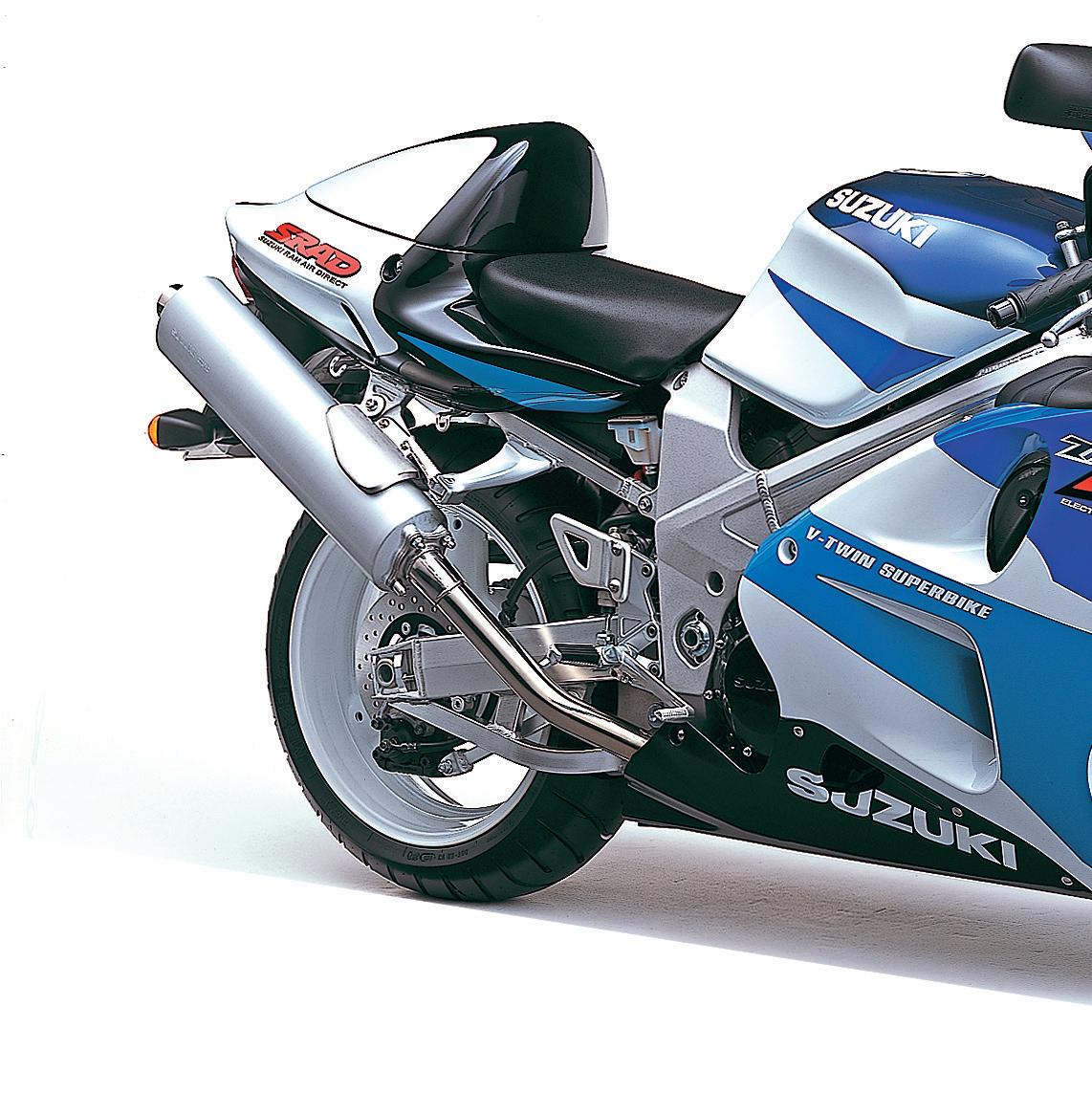
USED BIKE GUIDE 1998 – 2001 Suzuki TL1000R
56 JULY 2023 WWW.FASTBIKESMAG.COM
YOU
CAN MERRILY HAMMER A TL-R AND EVEN SKIP A FEW SERVICES WITHOUT FEAR OF IT GOING WRONG.
ROTARY DAMPER
We all know the issues with the damper unit and that means there are many replacement units out there. Maxton still builds a conventional shock that does away completely with the damper unit and sits where the original spring was, while Öhlins has stopped producing its alternative.
handling isn’t anything to do with the controversial rotary damper, more Suzuki’s choice to overengineer the bike and in doing so add a stack of unnecessary weight. If you expect a nimble, track-focused sportsbike, you will be in for a disappointment. If, however, you treat the TL-R as a road bike first and foremost, it is an absolute delight to ride – and the machine you would pick over a 996 for a ride-out on the UK’s bumpy roads any day of the week. And your wrists, back and bum would be delighted at your smart thinking as the TL-R has a pleasingly spacious riding position and remarkably deeply padded seat. Even pillions are fairly well catered for, although sticking on the flat pillion seat does mean you can’t have the classic ‘duck bill’ rear end, which is a huge part of the TL’s charm and an instant talking point...
Looking at the prices of used TL1000Rs, it is hard not to assume

RACE KIT...
The fabled TL-R race kit was pictured at the bike’s launch but according to Harris Performance, the worldwide distributer of Suzuki race parts at the time, none actually ever materialised! They are a bit of a unicorn in the TL-R world...

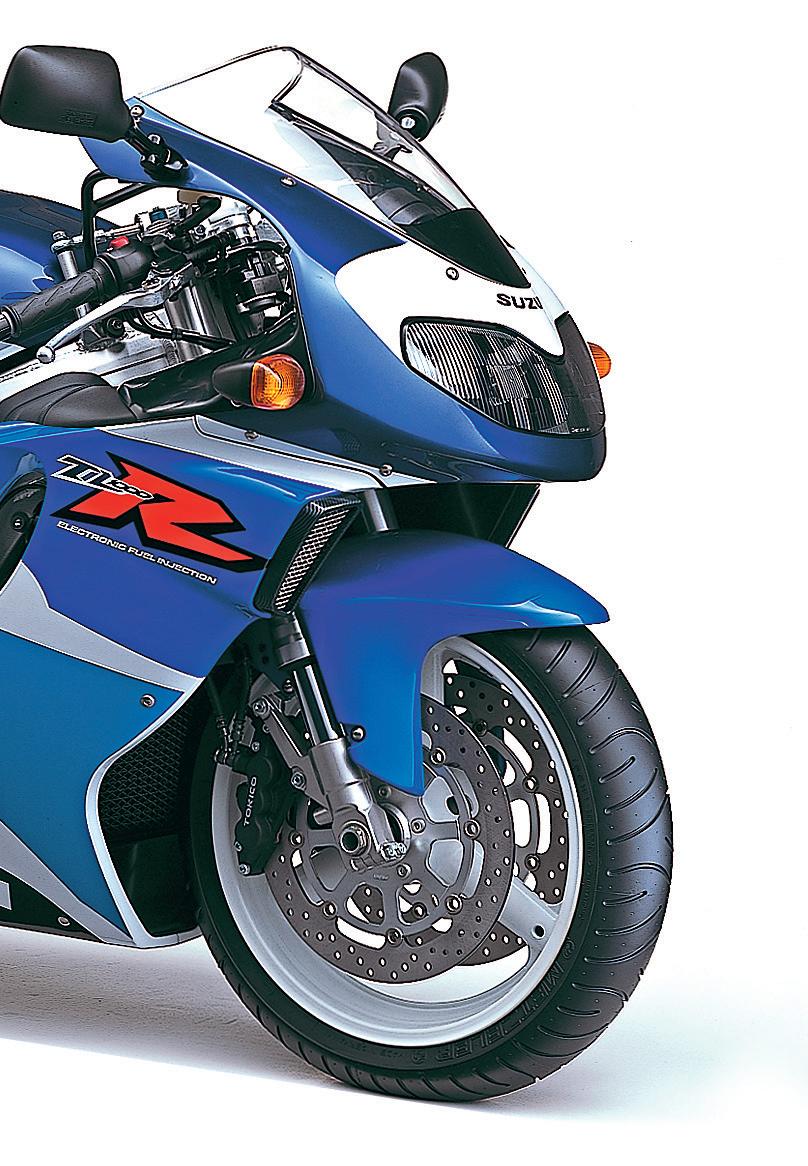
ROCKER
The TL’s suspension spring rocker is weak, with owners reporting cracks developing on older examples. Maxton includes a replacement billet unit with its shock conversion.

FUELLING
The TL-R responds very well to a set of pipes, free-flowing air filter and fuelling remap. From the stock 115bhp, you can reasonably expect to see a 10bhp gain, which is not to be sniffed at!
CLUTCH AND GEARBOX
When the ramps on the TL’s back torque limiter (it’s not a slipper clutch) start to wear, they cause the clutch to slip. Owners cure this by welding the clutch centre, which seems to work but is quite drastic. Always check the gearbox works as third gear often goes wayward...
BRAKES
The Tokico brake calipers are pretty poor performing and have a habit of developing sticking pistons. They’re not too hard to rebuild (a seal kit costs about £40 a side) and fitting stainless steel pistons helps ward off future issues. A full kit (stainless pistons and seals) can be had for about £150.
JULY 2023 WWW.FASTBIKESMAG.COM 57
ALSO CONSIDER THESE:
1999 DUCATI 996

Private: £7200 Dealer: £8000
Slightly overlooked as riders want the 998 or 916, the 996’s prices tend to be a bit lower. It’s still a great machine and well worth searching out a good one.
Engine: 996cc, l/c, 8v, desmo, V-twin
Power: 115bhp @ 9500rpm
Torque: 95Nm @ 7000rpm
2000 VTR1000 HONDA SP-1
Private: £8000 Dealer: £9000
Sadly, the SP-1 has fallen foul of the collectable market and that means prices are sky-high. There are a few bargains out there, but most are over-priced.
Engine: 999cc, l/c, 8v, V-twin
Power: 127bhp @ 9850rpm
Torque: 99Nm @ 7850rpm
1998 APRILIA RSV1000

Private: £3500 Dealer: £4000
The first generation of RSV was launched in 1998 and took the world by storm. Far less fickle than the Ducati, it’s a day-to-day Italian V-twin and sensibly priced.

Engine: 998cc, l/c, 8v, V-twin
Power: 114bhp @ 9500rpm
Torque: 99Nm @ 8600rpm
RUNNING COSTS:
Service interval:
Minor: £4000
Major: £8000
Valve clearances: £16,000
Service costs:
Minor: £180
Major: £250
Valve clearances: £550
Right fairing: £803.42

RH Engine casing: £169.66
Brake lever: £50.82
that they will very soon jump up in value.
For about the £4000 mark (which, it has to be noted, is half the cost of a Honda SP-1), you can get a reliable V-twin that with fairly minimal alterations (exhaust, suspension rebuild, brake caliper refresh) can be made even better and will be more than happy to be used every day of the week, whatever the weather, with no complaints. And, better still, it is actually a very rare motorcycle.
In the UK, Suzuki sold just 2291 TL-Rs between 1998 and 2001. Yes, just 2291.
If you are after an exclusive superbike that turns heads (especially in the classic blue and white paint scheme) but won’t put too much of a dent in your wallet, the TL1000R is a brilliant option. Yes, it bombed on track, but who doesn’t see a TL1000R and want to take a closer look at this truly unique machine?
Verdict 7/10
Although much maligned in its day, the TL1000R has an iconic silhouette, a unique history, and still makes for a beautifully relaxed V-twin road bike to ride.
+ THE V-TWIN IS A BEAUTY, HIGH COMFORT LEVELS, GOOD RELIABILITY
– AGEING BRAKES, SHE’S A LARDY OLD GIRL, HANDLING IS SLUGGISH
USED BIKE GUIDE 1998 – 2001 Suzuki TL1000R
58 JULY 2023 WWW.FASTBIKESMAG.COM































































JULY 2023 WWW.FASTBIKESMAG.COM 59
WORDS> RENNIE SCAYSBROOK PICS> INDIAN
BAGGING A GOOD’UN
There are some things in life that just don’t make much sense, but never let that be said of baggers on a race track, banging bars and scraping panniers.

FEATURE
60 JULY 2023 WWW.FASTBIKESMAG.COM
It might sound like a concept that’s been dreamed up down a pub over a pint or 10, but as our friends across the pond have shown over a few seasons in the MotoAmerica ‘King Of The Baggers’ series, taking luxury cruisers, trimming them down in weight, cranking up the horsepower and hitting speeds of up to 160mph is a sight and sound that race fans the world over very much need in their lives. Yep, it’s every bit as bonkers as it sounds, as has been validated by our Aussie mate and TT racer Rennie Scaysbrook, who took last year’s championship-winning Indian out for a spin...
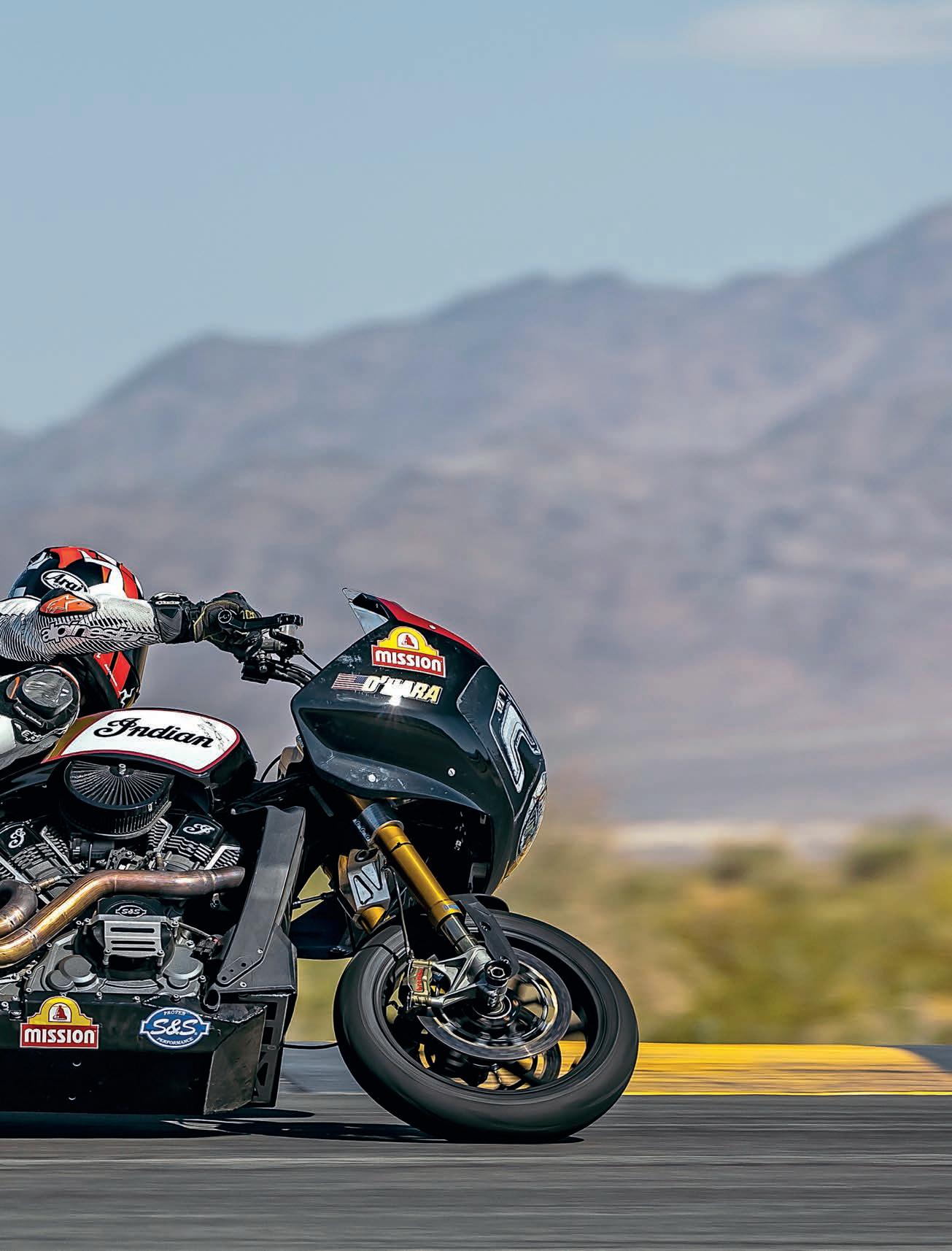
Chuckwalla Raceway is my local track in California. It’s a bit of a goat track, but it’s got some decently quick bends and elevation changes that always keep you on your toes. Conservatively, I’d say I’ve completed 3000 laps here over the last eight years, way more than any other racetrack I’ve ridden. I know this place like the back of my hand, but on the Mission Foods/S&S Cycle/Indian Challenger of Tyler O’Hara that won the 2022 MotoAmerica King of The Baggers championship, I may as well be on Mars.
O’Hara’s beastly bagger sounds like one half of a NASCAR and goes almost as fast, but that’s not the scary bit. It’s the way the chassis moves under me like it’s permanently got a teeny tiny spray of oil on the street-spec Dunlop Sportmax Q4 rear tyre—you know, just enough to keep you on your toes but not enough to throw you down the road—that has me worried.
INDIAN BAGGERS
JULY 2023 WWW.FASTBIKESMAG.COM 61
“It’s like the bike has a split personality,” O’Hara tells me. “You can ride the bike hard and shift hard and accelerate hard, but you must be real careful with it. She likes to go fast, but there’s a method to getting her to go fast.”
The secret to making it all work is to liberally use the thumb-operated rear brake, first to actually help slow the 275kg maroon monster but secondly – and more importantly – to help control the rebound of the rear suspension as the throttle is reapplied so you can keep everything on its intended path.
“You absolutely have to use the rear brake,” O’Hara says. “If you don’t, it makes it very difficult to get the bike to turn tight, and you spend too much time between braking and accelerating. Plus, you can use the rear brake to damp out the chassis flex, which has been an issue with our bike.”
Reefing the ride-by-wire throttle open on a bagger the likes of O’Hara’s American-as-f**k 1835cc V-twin racer requires a mixture of brute aggression and finesse to get all that torque to the ground.



The frame, modified as much as the MotoAmerica King of The Baggers rules will allow (which is basically not at all), flexes with the kind of willingness more akin to a 1983 Honda VF1000R, the front, centre and rear of the motorcycle squirming and snaking its way around Chuckwalla with me more or less just a passenger.
“By rule, we can’t really modify any of the chassis parts,” says S&S’s chief engineer, Jeff Bailey, the man largely responsible for creating, maintaining and improving O’Hara’s and teammate Jeremy McWilliams’ racebikes. “We did get an allowance from MotoAmerica to machine bit off the front frame spars for ground clearance, but that’s really the only modification that we do to the frame. This is still essentially a street bike. It’s not a race bike at its core.”

Compared to the stiffness of a modern sportsbike, the bagger feels like it’s from another time, but once I got my head around its oddities, it all started to make sense— somewhat.
Running Brembo’s billet four-piston monobloc race brake calipers, a Galespeed 19x19 master cylinder, a 17x6in rear and 17x3.5in front wheel, and modified Ducati Multistrada 1260 Pikes Peak 48mm Öhlins forks, the braking capabilities and turn speed of O’Hara’s bagger are immense.
FEATURE
62 JULY 2023 WWW.FASTBIKESMAG.COM
THE BRAKING CAPABILITIES AND TURN SPEED OF O’HARA’S BAGGER ARE IMMENSE.
COCKPIT:
AiM dash and datalogger provides the mission control suite on O’Hara’s and McWilliams’s racers.
It’s so long, with its lengthened and braced swingarm, and so tall and heavy, that you can absolutely bury the front end under brakes. It’s like a superbike style taken to extremes – you brake ultra late and hard, blow past where you think you should turn, wait a bit, then slam it on its side, pick it up onto the fat part of the tyre at your earliest convenience, hold the chassis on the rear brake and pull on

the noise tube to let that S&S-tuned V-twin engine roar its brains out towards its 7700 rpm redline on the AiM DL2 dash and datalogger. It’s like riding on a lion chasing its next meal.
The factory Mission Foods/S&S Cycle/ Indian Challenger team of Tyler O’Hara and our favourite globetrotting Northern Irishman, Jeremy McWilliams, is not a single entity but

a collaboration of Polaris’s (Indian Motorcycle’s parent company) commercial might and legendary tuning house S&S’s expertise. Arch-rivals Harley-Davidson’s programme is run entirely in-house, with former champion Kyle Wyman and brother Travis on board – something you can do when you have a labour force (and budget) roughly four times the size of Indian’s.
FORKS:
O’Hara ran lengthened and revalved Ducati Multistrada 1260 Pikes Peak forks in 2022, but the team has since switched to higher-spec Öhlins race forks for 2023.
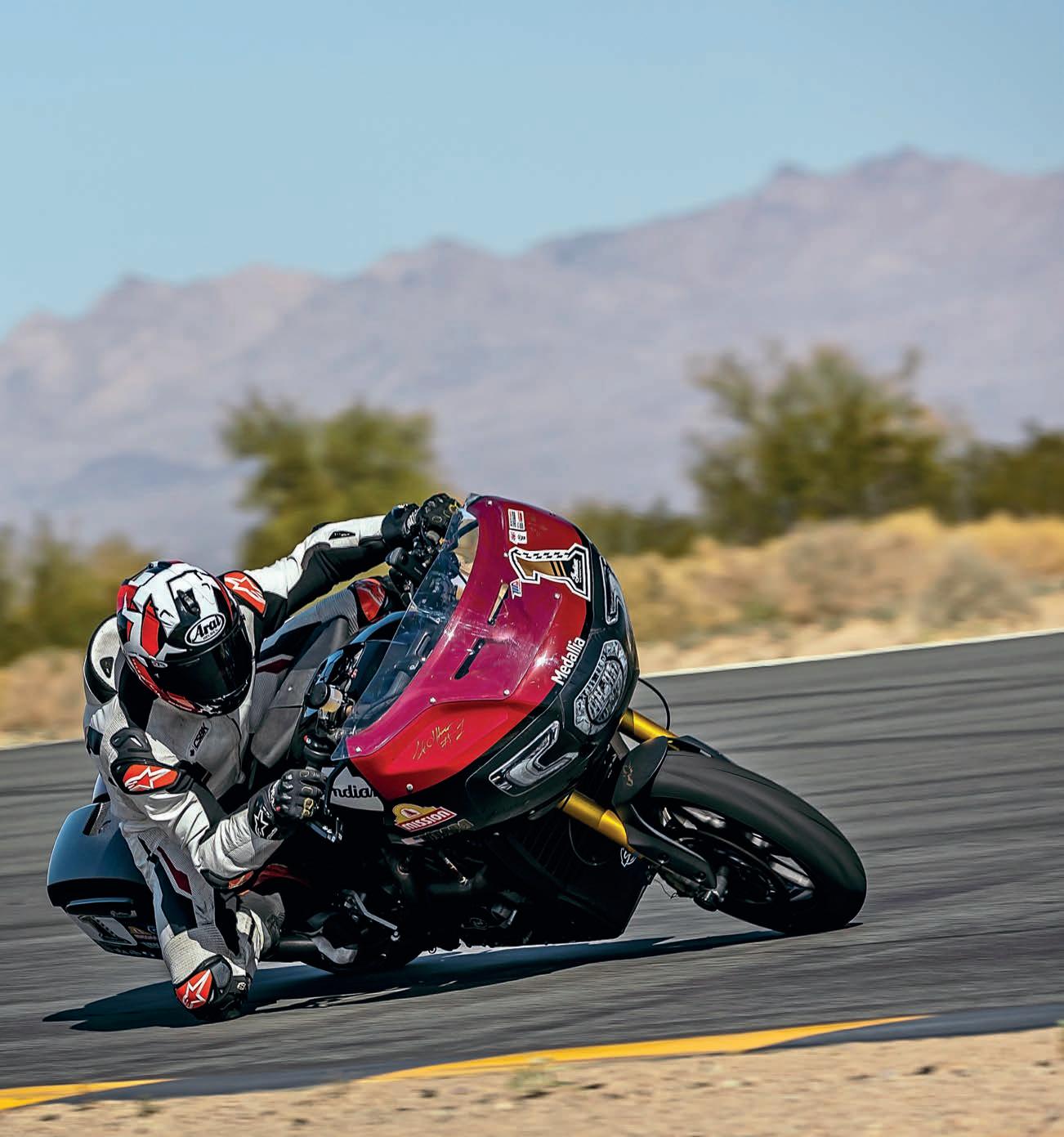
BRAKES:
Superbike-spec Brembos mate to a Galespeed 19x19 master cylinder and offer stupendous stopping power for a motorcycle weighing north of 600lb.
INDIAN BAGGERS
JULY 2023 WWW.FASTBIKESMAG.COM 63
To create O’Hara’s and McWilliams’s racers, S&S start with a bog-stock Challenger and rip into it. Custom parts from S&S include adjustable triple-clamps, a billet front axle, totally revised induction system, billet clutch cover, rearsets, handlebar, rear axle, bellypan and few more bits and bobs like the Saddlemen-made carbon fibre seat unit and sidebags. But the engine, obviously, is where much of the attention is paid.
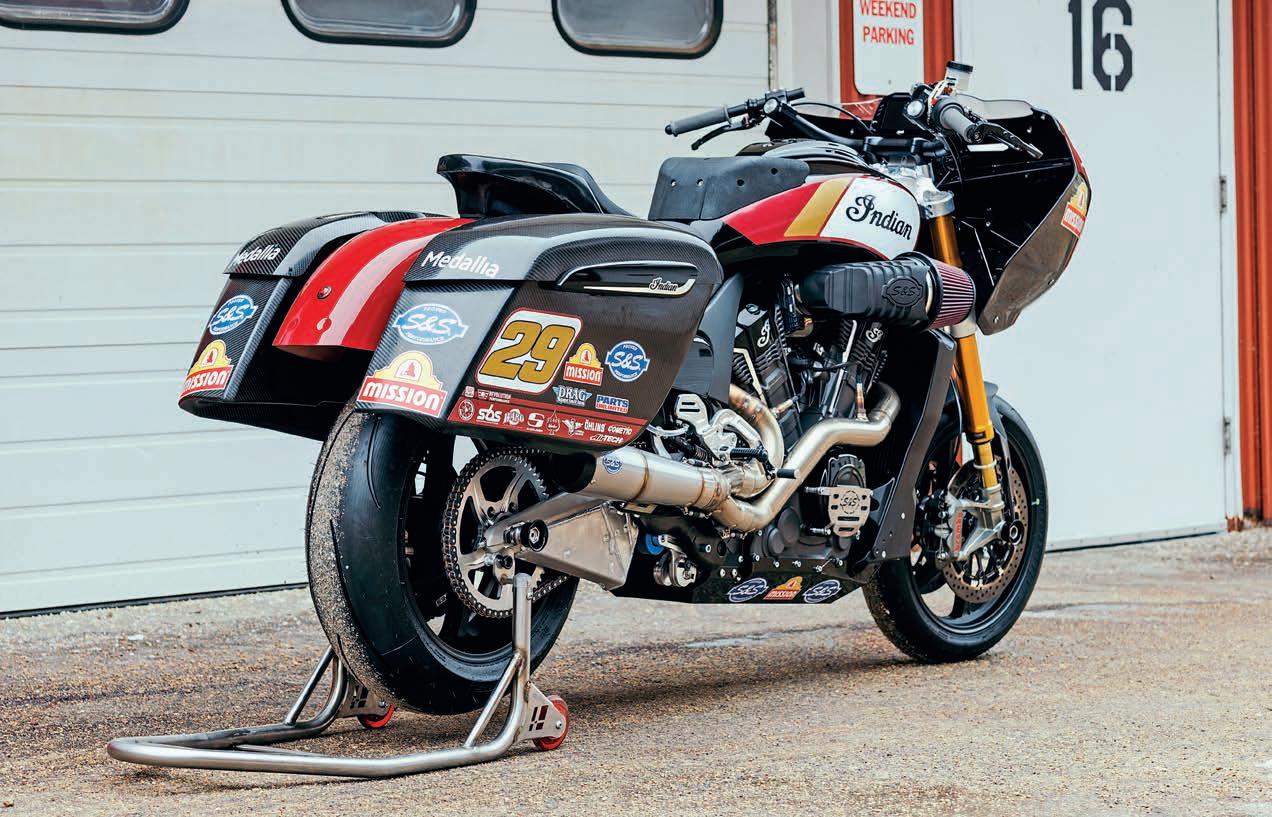
“We are really focused a lot on airflow,” says Bailey. “It’s mainly all top-end work –we create the camshafts, CNC-machined cylinder-heads, and the 110 mm big bore pistons. We machined some rocker arms, too,
SWINGARM:
just for the higher rpm limit. All four rocker arms are different and machined out of a solid chunk of steel. The intake manifold on these bikes is actually 3D-printed aluminium, which is kind of cool, and then the outer runner is plastic, and this joins up to the massive single 78mm throttle body we took from a Chevy V6 car motor that replaces the twin throttle body set-up of the stock motor.”
Despite my pestering and possible bribing, Neil refused to divulge any performance figures from this monster motor. Boo.
A lightened crank of unspecified weight – allowed by the rules in 2022 but which in 2023 has been mandated at 10% weight reduction over stock – helps this V-twin motor spin up with the kind of velocity many V-twin cruiser owners would kill for.
But, like any bike with tons of torque, the game is not so much unleashing it as it is harnessing it. That’s why Jeremy McWilliams was brought on board at the start of 2022 to help the crew work the UK-designed Max ECU’s throttle maps before the first round at Daytona, where Indian went on to sweep all before then as the factory Harley-Davidson’s grenaded themselves on the banking.


“Jumping on the bike was a real wake-up call because it was the very first kind of roll-out they’ve had on it with all of this extra horsepower and torque compared to the 2021 bike,” McWilliams said. “We didn’t even have a throttle map. We were just running one-to-one. So, jumping on this with a one-to-one throttle map was quite an eye-opener, to say the least. We worked closely with the calibration guys. They quickly got a handle on how to transfer all that torque to the rear tire. Then, over the day, we made such big steps that I kind of wanted to come back and do some more.”
Jeremy’s feedback enabled Indian’s technicians to pull the kind of performance
FEATURE
A braced and lengthened swingarm gets all that torque to the tyre.
64 JULY 2023 WWW.FASTBIKESMAG.COM
REAR BRAKE: Despite its size, the Indian is surprisingly agile. But you absolutely must use the rear brake to bring the chassis to the apex.
INTAKE:
3D-printed intake manifold with plastic outer runner mates to a massive 76mm throttle body swiped off a Chevy V6 car motor.
out of the bike it needed after Kyle Wyman and Harley-Davidson pulled a roundhouse kick during the 2021 season. McWilliams was subsequently hired not just for the season opener at Daytona, but also for the rest of 2022 and 2023. His take on riding a bagger had me laughing hard in the media room.

“You know what happens when you ride this? You think you’ve mastered it,” he says. “You come back from putting it on the
podium, go home, come back a week later and you go, ‘I know this bike. I know how I finished on it two weeks ago, I’m just going to fit straight back into it’. And you don’t. You can’t go fast until the bike starts to come to you. You don’t just get on and go, ‘All right, I’m good to go’.
“After a session, then it starts to come to you, but you’re continually tweaking and messing with it, instead of just getting on
SEAT HEIGHT:
Indian wouldn’t divulge so much as the seat height on its racer, but suffice to say, even a 6ft 1in tall rider like Rennie found it a stretch to the ground.

INDIAN BAGGERS
JULY 2023 WWW.FASTBIKESMAG.COM 65
and trying to ride it. You’re like, ‘What have I changed? Or what have they changed? What’s going on?’ It can mess with your head.”
It can mess with your head just watching these things in action. I was at Daytona for the first round last year and watched McWilliams and co head onto the first banking, the one where instead of hitting it at full speed, you’re constantly accelerating and thus putting all those forces through the chassis.
PRIMARY COVER:
The primary cover’s lost about an inch of width to aid in ground clearance and is a work of billet aluminium art.

TRIPLE CLAMPS:
More CNC-machined goodness comes in the form of the top triple clamps that O’Hara employs with a 15mm offset.
You know when you see a supersport bike doing 150mph? It looks like it’s going 150mph. It looks like it’s supposed to go 150mph. When you see a bagger doing 150mph, especially one on a 37-degree banking like Daytona’s, it looks like it’s going 250mph. It snakes and skims its way around the banking, producing a sound that genuinely reminded me of the first time I heard a tuned V8 on full noise as an impressionable teenager. It sent shivers down my spine. I’ve been to countless MotoGP

races and seen the gods ride, but that first glimpse of a bagger doing its thing at Daytona will stay with me forever... as will those five brief but memorable laps at my local track that I may as well have never ridden before.

O’Hara’s bagger requires a more finely tuned riding style than even a Manx Norton to get the most out of, and to see that he, Wyman, McWilliams and the rest can pull lap times within four seconds of Jake Gagne on a WorldSBK-spec Yamaha YZF-R1M at Laguna Seca tells you that although they seem goofy, bulbous and heavy, these are serious racing machines ridden by riders with balls so big they need wheelbarrows to get around.

FEATURE
66 JULY 2023 WWW.FASTBIKESMAG.COM


















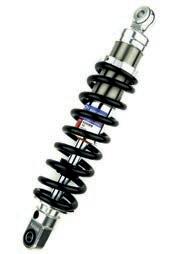














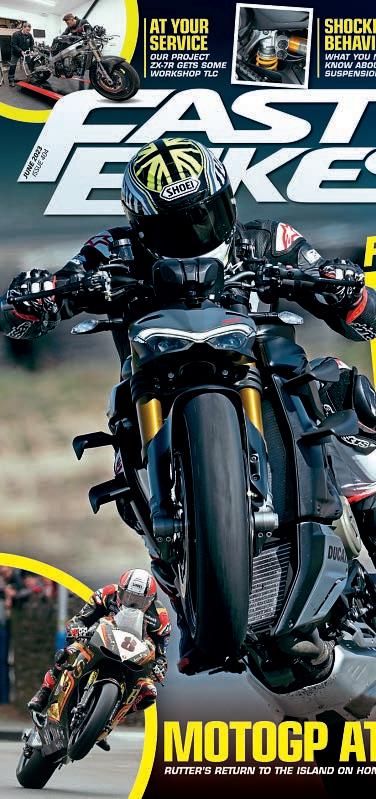


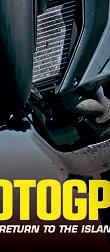

























































JULY 2023 WWW.FASTBIKESMAG.COM 67
LONGTERMER DUCATI PANIGALE V4 SP2 BRUCE
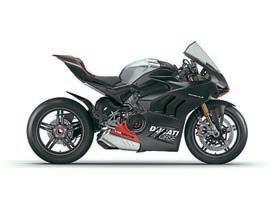



You can learn a lot about a bike over 500 miles, especially one as characterful as the SP2. It’s been an awesome month on the Ducati, simultaneously clocking up the distance needed for its first service while getting my head around the package and understanding its multitude of idiosyncrasies. I should probably start by admitting that this is not the easiest of sportsbike to get on with, but for all the niggles exposed in the past few weeks, nothing’s been enough to put me off this wonder weapon. The smile on my face has been relentless, even when handing over my card to the fuel
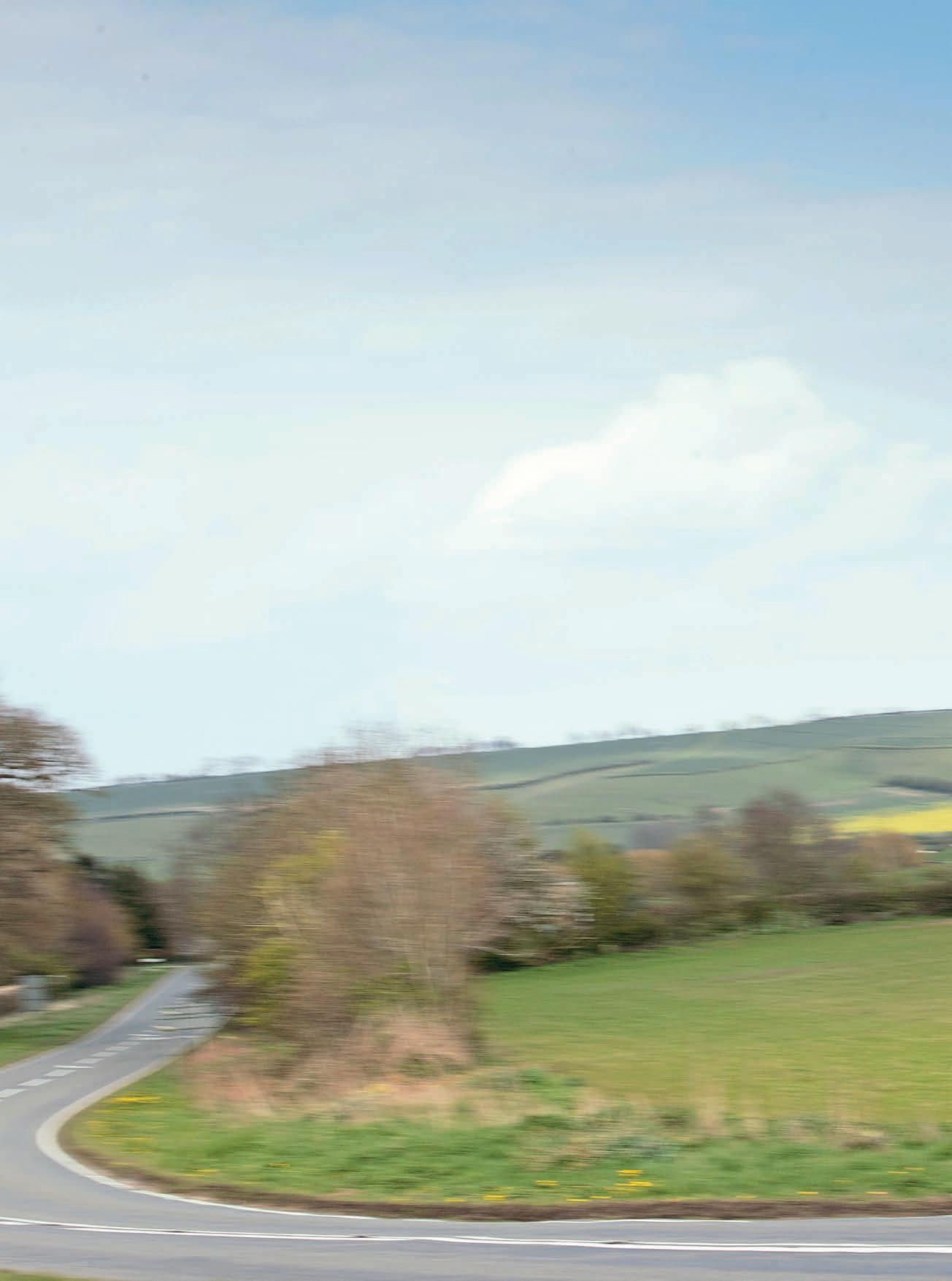
pump attendant for what feels the millionth time to keep the hungry V4 topped up with fuel. Scarily, I’ve been averaging 120 miles between fill-ups, which might have more to do with my style of riding than the moderatelysized brushed aluminium tank, but that’s a question for another day. Besides, if I wasn’t spending that money on petrol, I’d probably be having to hand it over to the better half for a new garden furniture set or some other inordinate purchase.
Price from new: £ £35,495
Modifications:
None £0
RUNNING TOTAL £0

LONGTERMERS
TIME ON TEST: ONE MONTH ODOMETER MILES BHP: 213 GAIN: 0 NEXT AIM: GET IT SERVICED 0 0 0 6 0
IF I WASN’T SPENDING THAT MONEY ON PETROL, I’D PROBABLY BE HAVING TO HAND IT OVER TO THE BETTER HALF.
PICS> CHAPPO/CHIPPY 68 JULY 2023 WWW.FASTBIKESMAG.COM
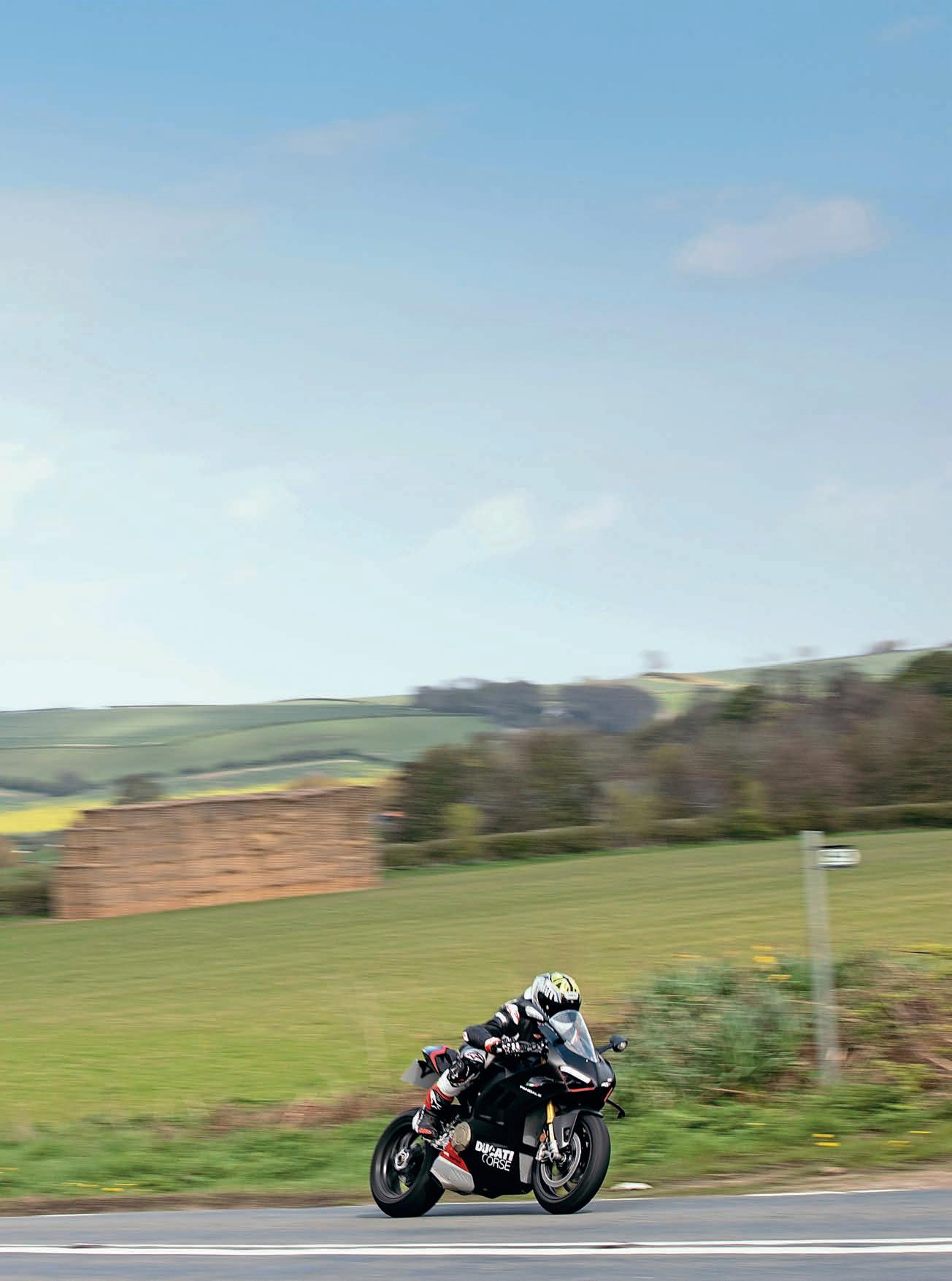

LONGTERMERS JULY 2023 WWW.FASTBIKESMAG.COM 69
The running-in process is going okay...
Most of my rides have been short, sharp blasts, popping out for an hour to get a pint of milk from 20 miles away, but I also undertook a long-haul jaunt down to Ducati UK to try out some other Ducatis. That day saw me in the saddle for just over five hours, clocking 251 miles in total, with a mixture of motorways, carriageways and a whole load of B roads. It was a good slog, and a trip that taught me quite a lot about this bike. No one buys a sportsbike for consummate comfort, but surprisingly, this machine was far more accommodating than I’d maybe first thought. Okay, my knees weren’t thanking me by the end of the day and my backside wasn’t either, but name a sportsbike that wouldn’t leave you that way after a decent stint in the saddle? When you’re hopping all over the bike, hustling in and out of corners, the cramped knee angle never really registers for me, but long, sedate mile-munching exposures eggs on the discomfort. The solution is to only ride on really bendy, fun back roads – surely?
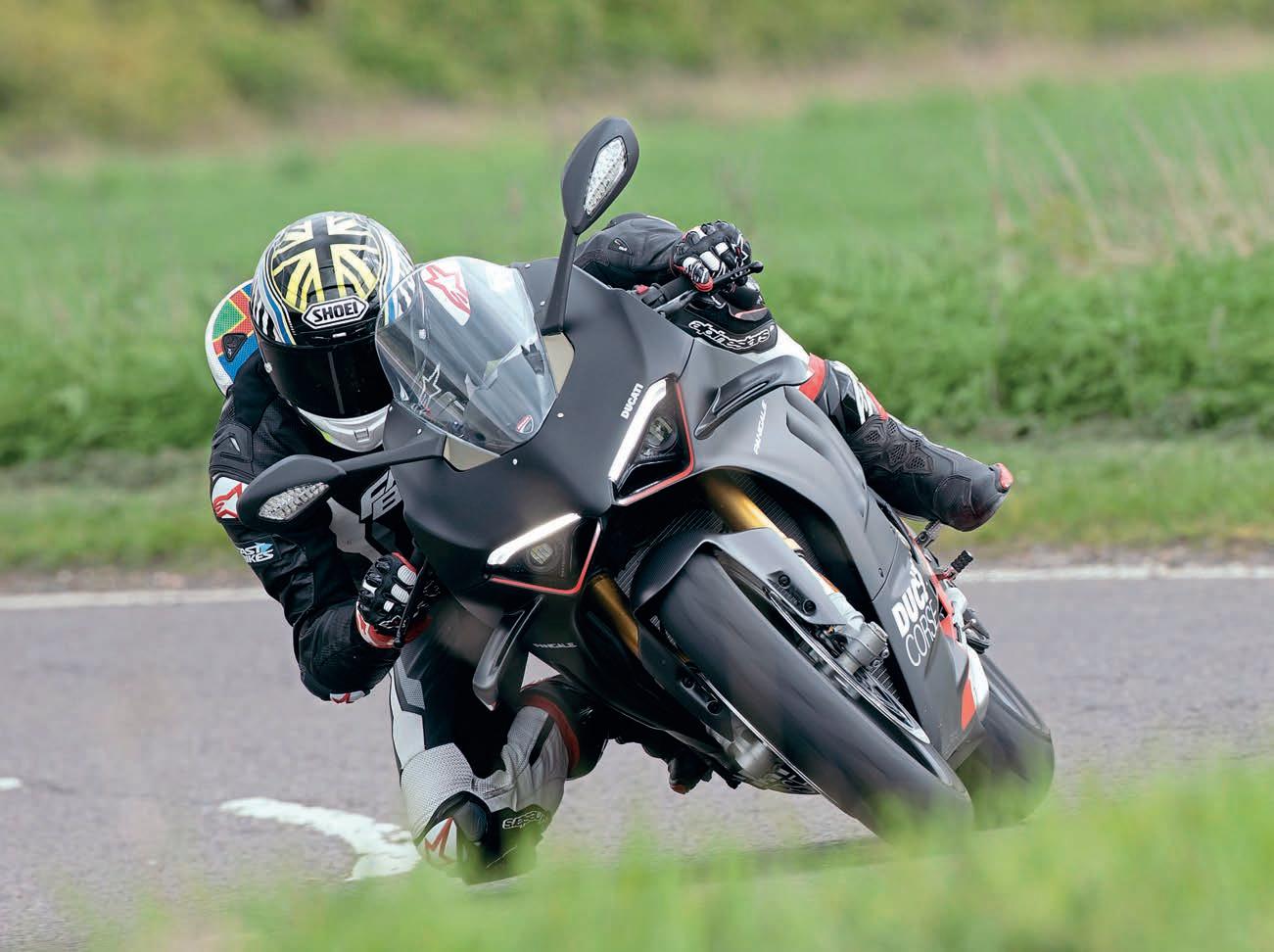
The footpegs on the bike are adjustable, meaning they can be lifted or lowered, or moved back and forth, but the position they’re currently located in is the most spacious of the lot. The seat is something of a torture device, too. On track, a firmer option is much better at translating what’s going on in a corner, but if I’m ever going to take this bike on a proper trek, it would probably pay dividends to find a more comfortable option. A few months back, I rode the Streetfighter V4S on its launch. The seat on that had 30mm more padding but looked every bit as good as the Panigale’s that it’s based on.
If there’s the chance that one of those would bolt straight onto the SP2, that would be problem solved. One area of comfort I can’t criticise are the bars. They’re pretty high up on this thing, and despite the bike having such a shaky nature, they do a cracking job of dispelling excessive vibes.
The last little thing to moan about is the stiff clutch that becomes a bind over time, and also the bike’s inability to find neutral in less than a minute’s worth of fumbling with the gear selector. I mentioned this to Ducati, who questioned if it was something that arose when the bike was hot, but it’s as bad when it’s cold as it is when it’s hot. Hopefully, there’s some solution because it’s made me feel a bit of a nob pulling up at lights and fighting the gearbox like a tap dancer… often to no avail.
Most of what I’ve mentioned are little more than teething problems that I’m sure can be improved over time... the bigger picture is that this bike blows my mind. It’s got so much performance on tap, and I’ve been loving its squirt-ability to crank up speed with absolutely zero effort. Its torquey V4 motor seems to deliver the goods whatever gear you’re in, which is great fun on the roads and a big help when it comes to overtakes and such like. Low down, the engine has a bit of a stutter, but it soon clears… and you clear off. I’m only tickling this thing on the roads, but hopefully I’ll get a chance to take it on track to really stretch its cables. The shifter and blipper are great, but I’ve learned not to be lazy, keeping my foot engaged on an upshift, for example, for any longer than
necessary. To do so can encourage a second cull in ignition, launching you forward as if you’re possessed. God knows how I’ve not gone through the screen already.
The tech on the bike, in general, is pretty exceptional and easy to navigate on the colour TFT dash. I’m a big fan of Ducati’s systems and they’re so easy to dial that I’ve been in a habit of altering the tech levels on pretty much every ride, so it suits whatever antics I’ve got in mind. In truth, most of the package is so advanced I’m not even bothering it on the roads. Things like slide control seem a bit overkill when you’re trundling down the local high street, but I know first-hand how helpful that feature is when you’re pushing on track.
One area I really want to focus on is the electronic suspension. I’ve been in a habit of hopping on and blasting off without so much as checking the suspension set-up – what I would say is the bike feels extremely stable but not exactly lithe. It feels way too physical to hustle around, as if it’s sitting low in the stroke both front and rear. I’ve ridden an SP around Portimao that had an awesome set-up, so I know just how good this bike can be made to feel. The plan is to spend a bit of time with a local suspension specialist to dial in a more sporting algorithm, which I dare say will transform the experience. But before all that, I’ve got to get this bike over for its first service. Ducati UK is set to perform the necessary process and I’ll aim to be there throughout to see what’s involved. With that inaugural procedure in the bag, the world’s my oyster.
LONGTERMERS
The set-up is the next big goal.
70 JULY 2023 WWW.FASTBIKESMAG.COM


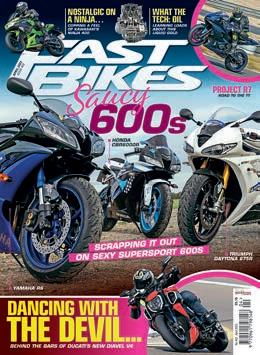





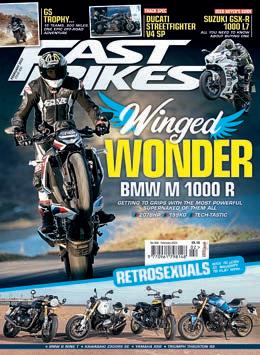





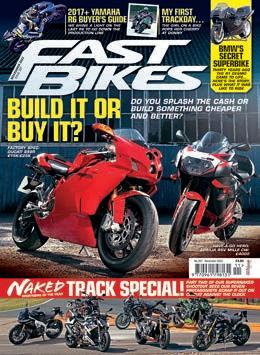


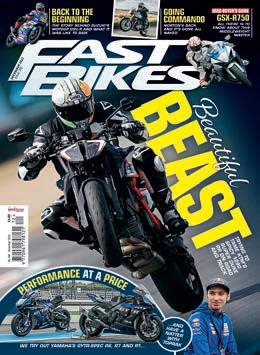







YAMAHA R7 PROJECT

PART FOUR
With the clock ticking down to the Batham’s R7 being loaded onto the race truck, it was time for some tough but sensible decisions. With the delays on the Yoshimura camshafts and Nova gearboxes knocking onto the overall build being delayed, it was becoming increasingly obvious that the bike wouldn’t be ready in time to leave for the North West 200 with the team.
The plan and original build schedule was to have two bikes built and tested in time for the North West 200, where they could be dialled in to the particular nuances
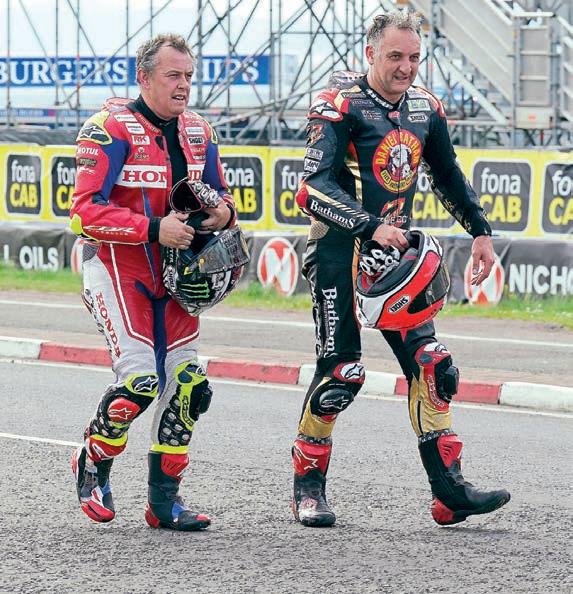


of road racing in the hands of Michael Rutter and Richard Cooper. However, when the moment came, the truck left for Ireland without any R7s in it – and just one part-built bike at MSS’s headquarters yet to even see the dyno, with the promise that it would be delivered to the paddock in time for the second qualifying session a week later, on the Thursday afternoon.

With too much unknown about the bike, and it clear that the North West 200 was now going to be the very public initial shakedown of the R7 – and therefore the odds of it actually being competitive virtually zero, Rutter decided he should pilot the bike and let Cooper know that if he had any other offers to ride in the Supertwin class, he should take them up.
During the first part of race week, while the team focused on the RCV superbike and BMW superstock bike, word was coming through from MSS that the R7 was showing signs of promise, getting closer to the absolute minimum target of 100bhp but not yet breaching it, the bottleneck being the miniscule airbox tucked away underneath the rider’s seat. It’s small and has a very poor air supply, which, with the best will in the world, can only deliver a finite amount of air to the engine for it to mix with fuel and burn. MSS felt that without the ram air boxes –
YAMAHA R7
Time and tide waits for no man, and the same goes for race meetings. Up against it, the Batham’s R7 made it to the North West 200… but only just.
WORDS: BIG MAC PICS: TIM KEETON / BIG MAC
JULY 2023 WWW.FASTBIKESMAG.COM 73
Top: Golden oldies. Left: Rutter’s idea of running the R7 in.
which were somewhere between America and the UK at the time – the R7 had reached the limit of what it could do with the engine tuning without more air getting in, so the bike was loaded into a small van and so began a 24-hour mercy dash to Portrush.


At 3.30pm on the Wednesday before the second qualifying sessions, the van pulled up outside the Batham’s Racing truck. The following five hours were a frenzy of activity by everyone to get it ready for scrutineering the next morning. The GYTR bodywork needed to be fitted, but there were all sorts of brackets missing, a steering damper and a 520-chain conversion had to be fitted, and some R6 rear sprockets sourced as well as R1 front sprockets so we could take a punt on final gearing. It had to be lockwired, have some Metzeler Racetecs fitted to the road wheels (the OZ wheels hadn’t arrived… or Brembo disc rotors for them) and a home for the PW50 choke lever needed to be found. The choke lever is the device used to unlock the neutral in the Nova gearbox. Neutral is at the top, so you push the lever down for first, then keep going down for higher gears and up for lower gears as per a normal race shift pattern. Meanwhile, as soon as you’ve engaged first gear, the neutral position is locked out, so it’s impossible to select neutral unless the aforementioned choke lever is moved into another position that reopens neutral in the gearbox. Very trick and very clever, but it was another job on the list to get the bike ready to ride that took the team into the night.
In the end, once the long list of various jobs had been ticked off, and the bodywork fitted, and Rutter had got his handlebars and levers where he wanted them, the remaining sponsor stickers were sacrificed in favour of food, then sleep. Main sponsors Batham’s and Zeeco had been painted and lacquered
Right: It wasn’t fast enough, but it handled a treat.
74 JULY 2023 WWW.FASTBIKESMAG.COM
Below: How it turned up at the track.
onto the bodywork, and Rutter’s 2023 Alpinestars suit had also arrived, which meant that in the unlikely event there would be any footage of the R7, at least the rest of the team’s sponsors would be on his leathers and helmet. We took a guess on sprockets and wheelbase, then took the bike through scrutineering and put some tyre warmers on it for the big moment.
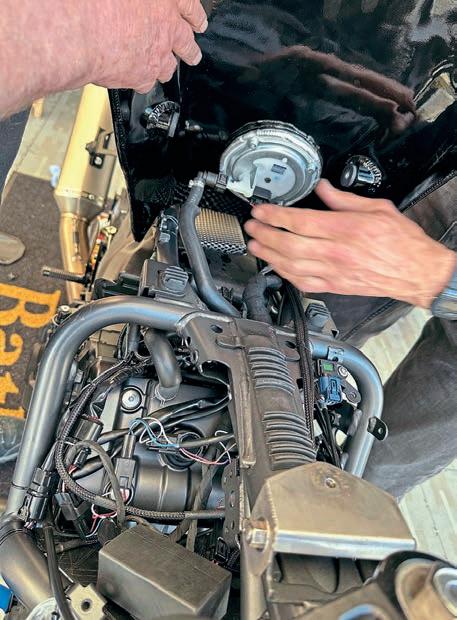
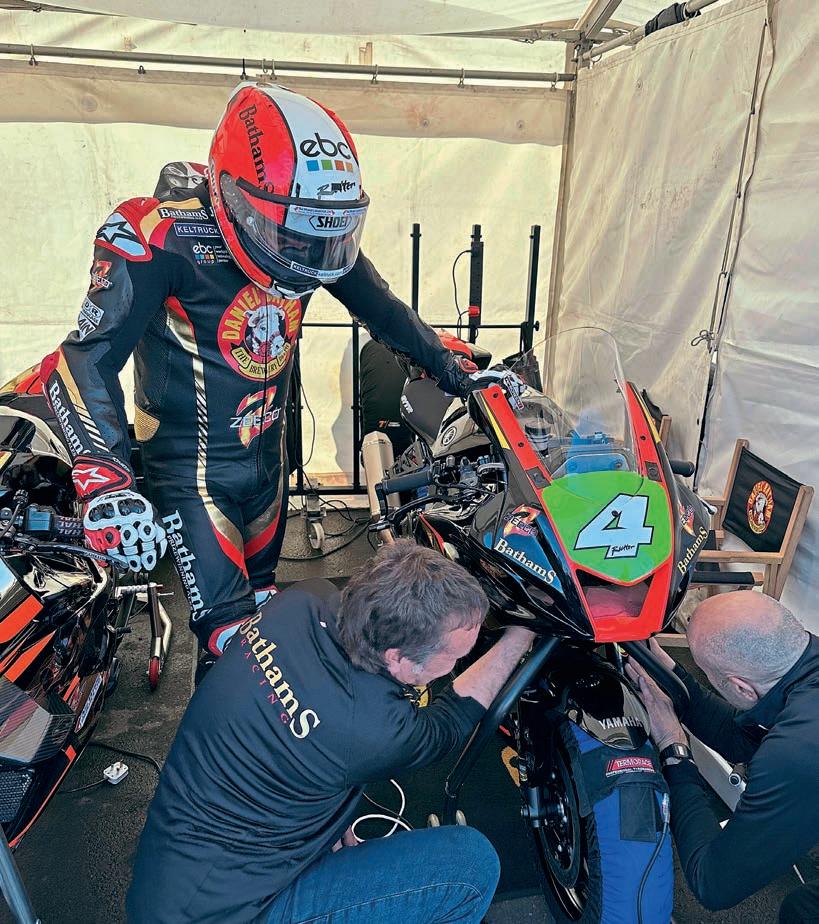

The Supertwins were called to the grid and Rutter duly took his place, soon after disappearing into the distance on the R7 for the first time it had ever turned a wheel on the road. As you would expect, he returned at the end of the lap so we could check the bike over, before returning to the circuit until the end of the session.
Rutter logged the fifth fastest time of the session, with only one item of feedback – the bike just does not have enough power, something we already knew. For perspective, despite being fifth fastest overall, he was 22nd fastest through the speed trap… out of 28 riders. His best speed was 147.7mph, which Rutter says was assisted by a massive tow from a large group of riders in front of him. On his other laps, he was typically between 140 and 145mph, which made him the slowest. As well as not having nearly enough power, our guess on gearing was off, with the R7 unable to pull sixth gear. So,
YAMAHA R7
BEST SPEED WAS 147.7MPH, WHICH RUTTER SAYS WAS ASSISTED BY A MASSIVE TOW.
Above: The stock airbox was too restrictive.
JULY 2023 WWW.FASTBIKESMAG.COM 75
You know it’s serious when there’s a knife and drill involved.
ON THE SURFACE, THE NORTH WEST 200 WAS A DISASTER.
there would be an easy win there for the race on Saturday morning by lowering the final gearing so he could at least use all six gears.
Frustratingly for the team, even though the track was wet in places during his qualifying session, and despite the lap times of all the other riders who took part in the first qualifying being about 10 seconds a lap slower as a result, the organisers still declared it a dry session. This meant that Rutter’s wet lap time would be compared to everyone else’s dry lap times from the Tuesday to determine his grid position. He would start the race from 17th, right at the very back of the first wave of riders.
At the start, he got boxed in by a group of riders into the gutter and for a moment thought about heading up a dropped curb at the end of someone’s driveway and onto the path as a way of not having to shut the throttle. Instead, he stayed in the gutter and got his elbows out. His first complete lap was six seconds quicker than his qualifying time, but without the benefit of slipstream, he only managed 139mph through the speed trap – Rutter actually managed 148.3mph on the opening lap, once again with the benefit of a slipstream from of a large group of riders in front. Impressive as a top speed of 140mph is from a humble Yamaha R7, the reality is that it’s not nearly fast enough to be competitive in the class. It’s at least 10mph too slow to be even thinking of a podium and about 20mph too slow to be thinking of the top step.
The race was red flagged, and during the break, in a desperate bid to get some more
air into the airbox, we decided to cut the sides out of it and shorten the bellmouths, knowing full well that the chance of those modifications finding us 10mph was between slim and zero. However, Rutter is a racer through and through and viewed the situation as being impossible to get any worse, so drills and Stanley knives were deployed in the short amount of time available. Unsurprisingly, at the end of the first lap of the restarted race, Rutter pulled in and retired the bike. In his words, there was no point in continuing to put mileage on the engine and burning fuel when the bike was so slow, especially when we know what the cure was – and was waiting back home. The ram air boxes had arrived.
On the surface, the North West 200 was a disaster for the project – and in some ways it was. The bikes weren’t even close to being ready in time; in fact, even one bike wasn’t ready – we had to let the Supertwin lap record holder go from the team to ride

another bike, and the bike was woefully slow. However, we actually feel upbeat about the R7 project. We learned a lot about the bike, and Rutter is very happy with how it handles and how it fuels. We took it to the North West 200 knowing it was going to be slow and it was. There are no other issues with it at all, and the solution to the lack of power will have been fitted to the bike and hopefully tested at a trackday soon after, well in time for the TT.
Of course, the plan was to go and compete at the North West 200 with the R7, but you can only play the hand you’ve been dealt, so we had to use it as an initial shakedown for the bike, which we concluded in one piece, and with some data and an understanding of what needs to be done to achieve the main goal – the TT.
FEATURE
Right: At least it looked the part.

YAMAHA R7 JULY 2023 WWW.FASTBIKESMAG.COM 77
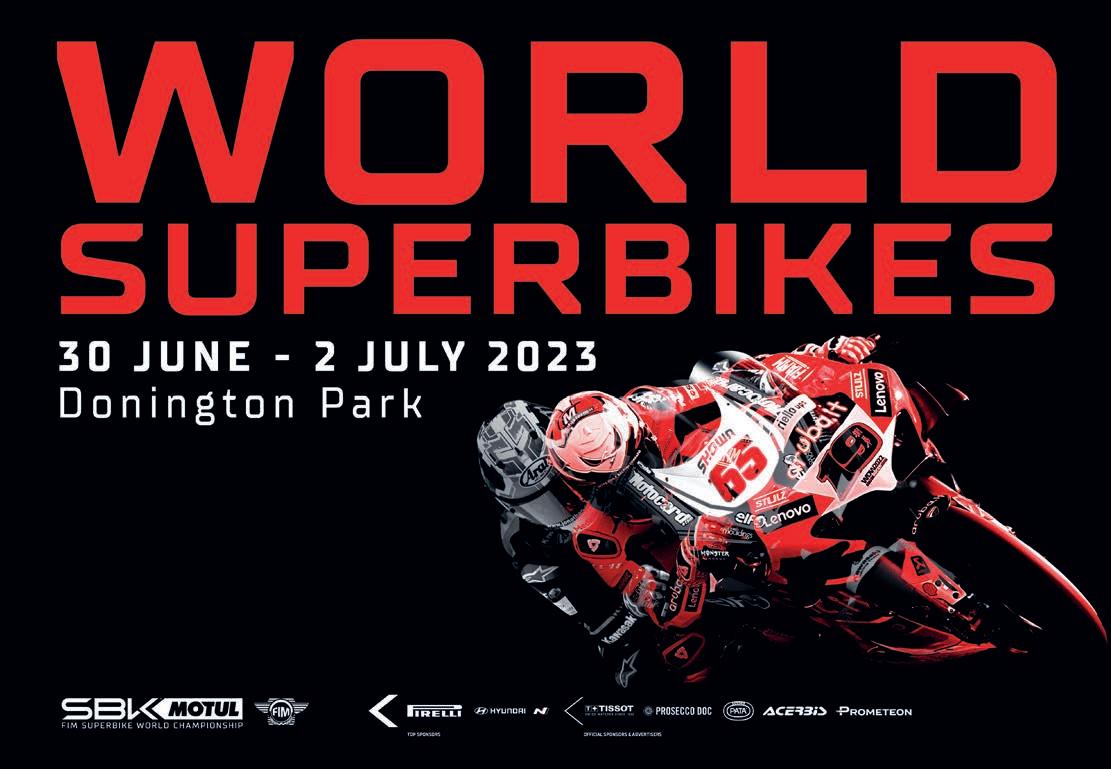


























































78 JULY 2023 WWW.FASTBIKESMAG.COM
NICE TO MEET YOU
Hello Bruce, We met briefly the other night in the Admiral Rodney bar and talked about bikes – GSX-R K1s, Aprilia RS125s, Cagiva Mitos etc. I was doing a trackday at Cadwell the next day on my GSX-R 1000 K4.
Just wanted to say what a nice and down-to-earth guy you are –not big-headed or self-obsessed (unlike some idiots!), and it was a real pleasure meeting you and just talking about bikes. I am reading my latest Fast Bikes edition and love the pieces on the
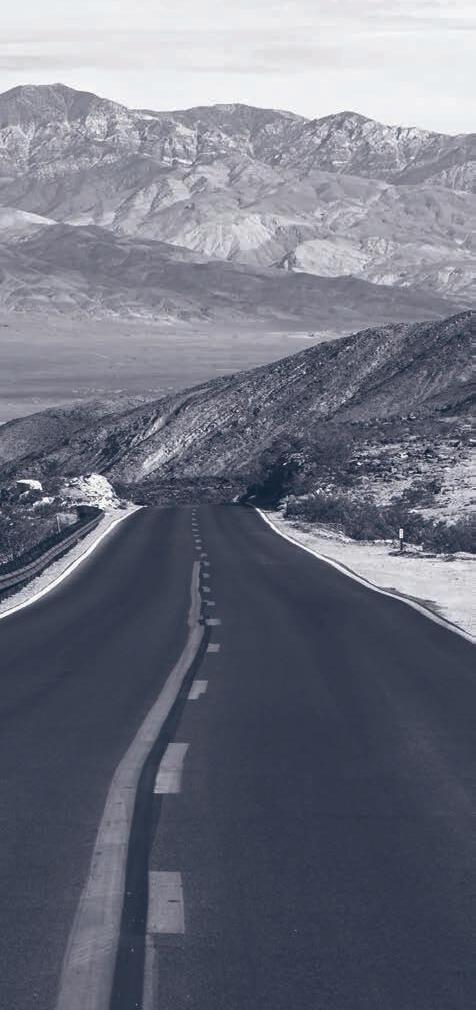
GSX-R1000 K1 and Rutter’s RCV. Great articles and great magazine. Keep up the good work.

Loved riding Cadwell on the GSX-R the following day, although, to be honest, the bike felt massive on that track. I’ve attached a pic.
Adam Bober
Hi Adam, Anyone reading this will think we’ve written it ourselves… but thanks a lot for your kind words. The truth is that the
You can win a Weise Redwood Shirt by simply writing the Fast Bikes


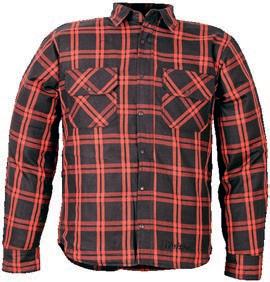
HANG ON A MINUTE...
Following the recent demise of a certain rival sportsbike magazine, I thought I would take out a subscription to Fast Bikes as I am a sportsbike nut. So far so great, but I am puzzled by the article on the new Suzuki GSX-8S in the June 2023 issue. You list several rivals but I can find no reference to its greatest competitor, the new Honda Hornet. By all accounts, this is a better bike with plenty of the ‘tech’ apparently desired by
whole team on FB are just like you, massive fans of bikes who like to natter about them and ride them as much as we can. Thanks for sharing your time and tales with me, and thanks also for your update on your Cadwell trackday. What a cracking example of a K4 you’ve got. Catch you in the bar.
 Bruce
Bruce
WORTH
£139.99!
today’s riders – and it undercuts the Suzuki by £1000! There must be a reason you left the Hornet off the list and I would love to hear it.
My own current bike, a 2000 Ninja ZX-6R, has no tech. It’s just me and the bike, which, to me, is how it should be... but then I am an old fart of 80!
All the best.
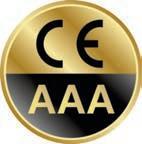 John Cotterell, Portland, Dorset
John Cotterell, Portland, Dorset
Want your greatest riding cock-up, triumph, or just the missus’ naked form immortalised in these hallowed pages? Email letters@fastbikes.co.uk
FastBikesMag.com/ FastBikes-Forum @FastBikesMag Facebook.com FastBikesMagazine
A classic check shirt, but with an abrasion-resistant aramid lining and CE-armour at elbow, shoulder and back. Rated A for protection, it's fastened with a zipper to keep it securely closed while you ride. Find out more at www.weiseclothing.com
star letter.
Hi John, Thanks for dropping us a line and pointing out the glaring error we’ve made. The truth is, we’ve not so much as sat on a Hornet yet, so while we should have mentioned it in name, we didn’t… and can only apologise. We’ll be getting out on one in the near future and look forward to experiencing all it has to offer. As you say, it sounds a great machine and a fair price. Cheers, Bruce JULY 2023 WWW.FASTBIKESMAG.COM 79
STAR LETTER
If

Email: letters@fastbikes.co.uk
EDITORIAL
Editor: Bruce Wilson, bwilson@mortons.co.uk

Designer: Michael Baumber
Production Editor: Lucy Wood
CONTRIBUTORS
Words: Steve Parrish, Tim Neave, Tom Neave, Jon Urry, Andrew Dalton, Jack Thompson, Gary Johnson, Christian Iddon, Jack Fairman, Rob Bean, Jamie Morris, Peter Hickman


Photography: Gary Chapman, Dave Parsons, Double Red, Les Liddle, Matt Sayle, Danny Inwood, Jamie Morris, Rob Gray, Polarity Photo
ADVERTISING
Group Advertising Manager: Sue Keily
Media Business Manager: Charlie Oakman, coakman@mortons.co.uk
MARKETING
Marketing Manager: Charlotte Park
CIRCULATION
Sales and Distribution Manager: Carl Smith
MORTONS MEDIA GROUP LTD

Publishing Director: Dan Savage
Commercial Director: Nigel Hole
GENERAL
Tel
&
24-hour answerphone

Email help@classicmagazines.co.uk www.classicmagazines.co.uk
On sale July 4, 2023
Buy it from WHSmith, Sainsbury’s, Tesco, Asda, Morrisons and all good newsagents. Failing that, try a bad one. Check out the eye-poppingly good digital edition at www.classicmagazines.co.uk
ENQUIRIES
BACK ISSUES
01507 529529,
SUBSCRIPTIONS Phone our UK hotline on: 01507 529529 Overseas orderline: + 44 (0) 1507 529529 (From outside UK only) Subscribe online at: www.classicmagazines.co.uk Customer services number: 01507 529529 Telephone lines are open: Monday-Friday 8.30am-5pm NEXT ISSUE ON SALE: 04.07.2023 Fast Bikes is the trademark of Mortons Media Group LTD. All rights reserved. Printed in the UK by Acorn Web Offset Ltd, Normanton, West Yorkshire Distributed in the UK by Seymour Distribution Ltd, 2 East Poultry Avenue, London, EC1A 9PT. FAST BIKES (USPS:710-470) is published monthly by Mortons Media Group Ltd., PO Box 99, Horncastle, Lincolnshire LN9 6LZ UK. The publisher accepts no responsibility for unsolicited manuscripts or photographs. If you are sending material to us for publication, you are strongly advised to make copies and to include a stamped addressed envelope. Original material must be submitted and will be accepted solely on the basis that the author accepts the assessment of the publisher as to its commercial value. © Mortons Media Group Ltd. All rights reserved. No part of this publication may be reproduced or transmitted in any form or by any means, electronic or mechanical, including photocopying, recording, or any information storage retrieval system without prior permission in writing from the publisher. Independent publisher since 1885 Media Centre, Mortons Way, Horncastle, Lincolnshire LN9 6JR To pre-order your next issue of Fast Bikes, head to classicmagazines.co.uk/ pre-order-fb Alternatively,scan the QR code on this page and order your next copy today.We will send it directly to you! Having trouble finding a copy of this magazine? Why not just ask your local newsagent to reserve you a copy each month? DUCATI DRE We check out the most exuberant, starstudded track experience to hit the UK. WHAT THE TECH: CARBON WHEELS After the recent controversy at this year’s NW200, we figure there’s no better time to take a look at woven wheels.
SPLASH THE CASH
WWW.FASTBIKESMAG.COM
you want to buy a bike, enjoy all it has to offer and make cash off the back of it, you need to read what we’re sharing.
GAVIN GREWAL
PENAL SERVITUDE PREVENTER
The Fast Bikes Legal Clinic is compiled by Gavin Grewal and his bike-riding barristers and solicitors at White Dalton Motorcycle Solicitors.
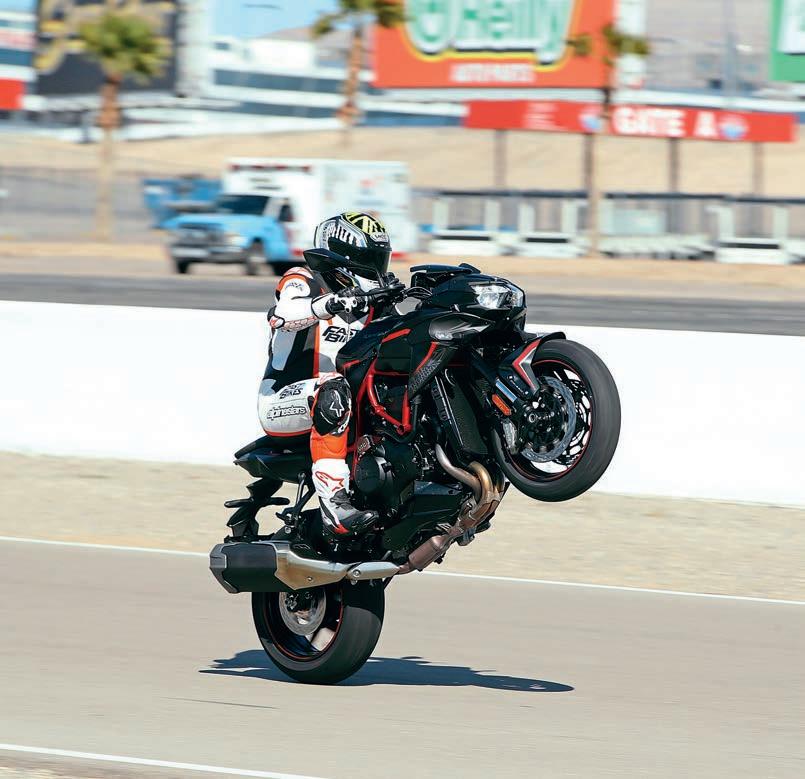
They deal with personal injury claims and their sister company, Motor Defence Team, deals with all the motoring offences. They know everything about bike law. Gavin can usually be found in a court room or racing his Kawasaki around a racetrack. All the White Dalton lawyers are qualified barristers, or solicitors, or both – and they all have full bike licences, too. They don’t act for insurance companies or the prosecution. They are Britain’s most specialist law practice and if they don’t know the answer to your question, there probably isn’t one. Don’t rely on the advice from your insurance appointed solicitor – get proper, independent advice.
For road traffic offences call Motor Defence Team 0800 280 0912
For non-offence cases call White Dalton Motorcycle Solicitors 0800 783 6191


HEADCAMS AND THE LAW
Visit their websites whitedalton.co.uk www.motordefencesoliticors.co.uk
Q A
I have been reading conflicting stories about how headcams might be used in court. Are they legal? Can they be used? Is there anything a biker should be aware of when using one?
First of all, there is no rule banning headcam footage from being used in court. Subject to some rules about continuity of evidence (in criminal cases), it will be admissible in any courtroom. This means footage could be used against you in a criminal case, even if it is your own footage. I have used headcam footage in support of a claim, and also had it used against a biker client in a criminal court. The problem is that everyone has a dashcam these days. This creates the potential for a ‘traffic cop’ to be sitting on the windscreen of every car you overtake. Operation SNAP, if
you haven’t already heard about it, is the police response to poor driving being captured on dashcam. You can now upload it to the force area in which the offence took place, and it is likely a Notice of Prosecution (NIP) will drop through the letterbox of the offending motorist. Strict timeframes exist: for example, if you are alleged to be travelling at excess speed, the police must get a NIP to you within 14 days. If the dashcam hero doesn’t send the footage to the police until 10 days after the incident, it is likely the police won’t be able to comply with the deadline. You may then have a complete defence to the prosecution case, but get legal advice as this area of law can be complicated.
I recall speaking to a biker who was on a ride out with some mates. Sadly, one of the bikers made a mistake and was hit by a motorcar. It resulted in a fatality. At the time of
the accident, no one was doing anything silly. However, the police turned up and asked for his GoPro. He was honest and told the copper it contained some exuberant riding a while before the accident, but at the time, everyone was riding sensibly. The copper told him, ‘I am only interested in the two minutes before the crash, nothing else’. True to his word, the copper only looked at the two minutes before the crash and disregarded everything else. Could he have been prosecuted for dangerous riding before the crash? The answer is yes. You could argue that the footage cannot be used under S.79 of PACE, entitled ‘exclusion of unfair evidence’, and base it on the assurance given to you by the copper. It isn’t a comfortable place to be in, which is why my best advice is to not ride like a spoon unless you’re happy for it to be played out in a courtroom.

MASTERCLASS
If you’ve been a naughty biker, you need some decent legal advice, get it from mail@whitedalton.co.uk
If you film your riding with a headcam, know that it can be used against you if you’re doing something naughty.
JULY 2023 WWW.FASTBIKESMAG.COM 81
WHAT THE TECH: SLIPPER CLUTCHES
Few people know more about slipper clutches than MotoGP tech guru Neil Spalding. We quizzed him on the wonder weapons.

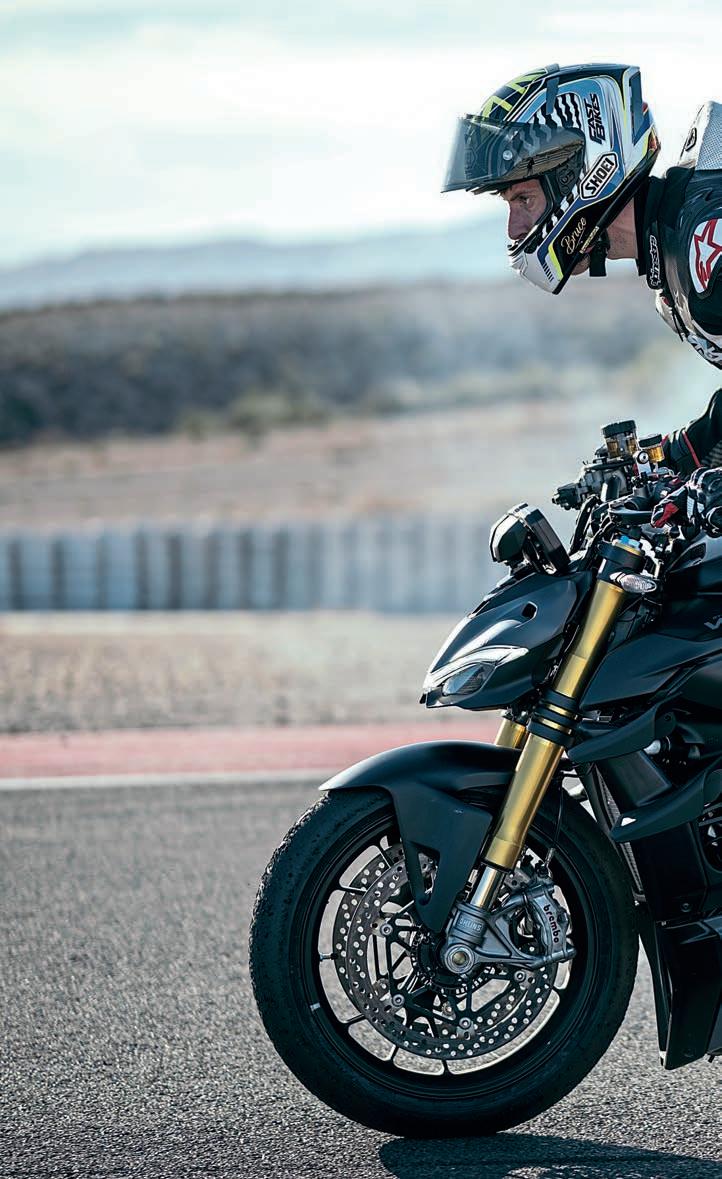
Once upon a time, when all this was fields as far as the eye could see, the action and operation of how a clutch felt on a motorbike was part of the list of things I would notice... and therefore note as part of its character and operation. These days, once you let the clutch out and pull away on a bike, that’s usually the last time you have any interaction with it until you want to stop. Being of a certain age, I well remember how it was back in the late 1990s and early 2000s in particular, when bikes didn’t have fancy engine braking electronic management, or even slipper clutches. Backshifting, especially at higher revs to set up for a corner on track, or even on a brisk road ride, was a delicate process compared to that of today’s bikes, on which you can just pull the brake lever and go down as many gears as you want without any regard for rear end stability.
As with all the best technical advances, slipper clutches and, later on, electronic-
TECH SLIPPER CLUTCHES
Aprilia’s RSV Mille had a vacuum-actuated slipper clutch.
82 JULY 2023 WWW.FASTBIKESMAG.COM
WORDS: BIG MAC PICS: SIGMA PERFORMANCE/ NEIL SPALDING/MORTONS ARCHIVE
derived engine braking assistance – which we’ll look at another time – are constantly working in the background, taking care of the details so you don’t have to. To understand the basic principle of how they operate, you must also understand the difference between how the engine interacts with the rear wheel when the throttle is open and when it is shut. Obviously, when it’s open, the engine is delivering energy in the form of power and torque to the rear wheel and accelerating the bike; when it’s shut, obviously the engine isn’t producing any power, but due to the momentum of the bike, and hence rear wheel, energy is transferred in the opposite direction, back from the rear wheel to the engine, and that can, at high speeds and high revs, cause the engine to try and start locking up, which actually manifests itself as the rear tyre locking. Heavy braking on older bikes could be a bit fraught at times if you were too greedy on the backshifts and a bit clumsy with the release of the clutch.
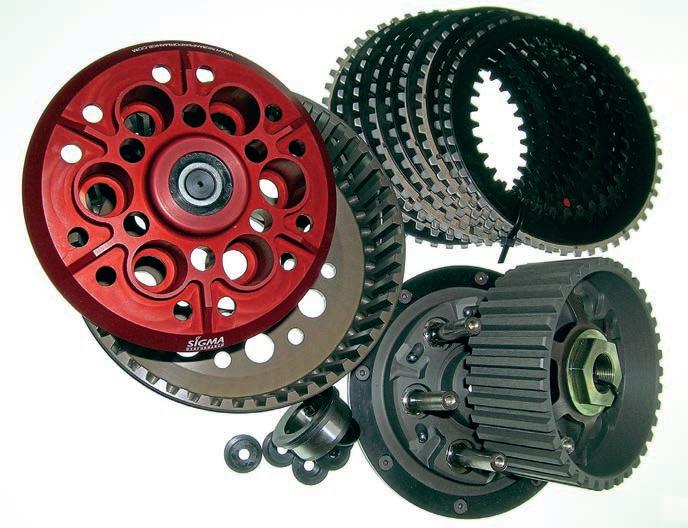
There’s more to them than you might think.

WHAT THE TECH: SLIPPER CLUTCHES
Just checking out the clutch slip...
JULY 2023 WWW.FASTBIKESMAG.COM 83
GP bikes feature super-special slipper clutches.
A slipper clutch uses that ‘back torque’ energy to open its plates slightly and thus reduce the amount of energy to actually reach the engine’s crankshaft so it has a chance of not stalling or locking up. To delve deeper into the world of slipper clutches, I got in touch with this month’s expert in the field, Neil Spalding, from Sigma clutches. Neil has been a MotoGP technical pundit and author for as long as I can remember and was one of three people who founded Sigma clutches in the 1990s, so who better to get in touch with and talk clutches with?
“Sigma got involved in slipper clutches back in 1998. We were going to race a Ducati
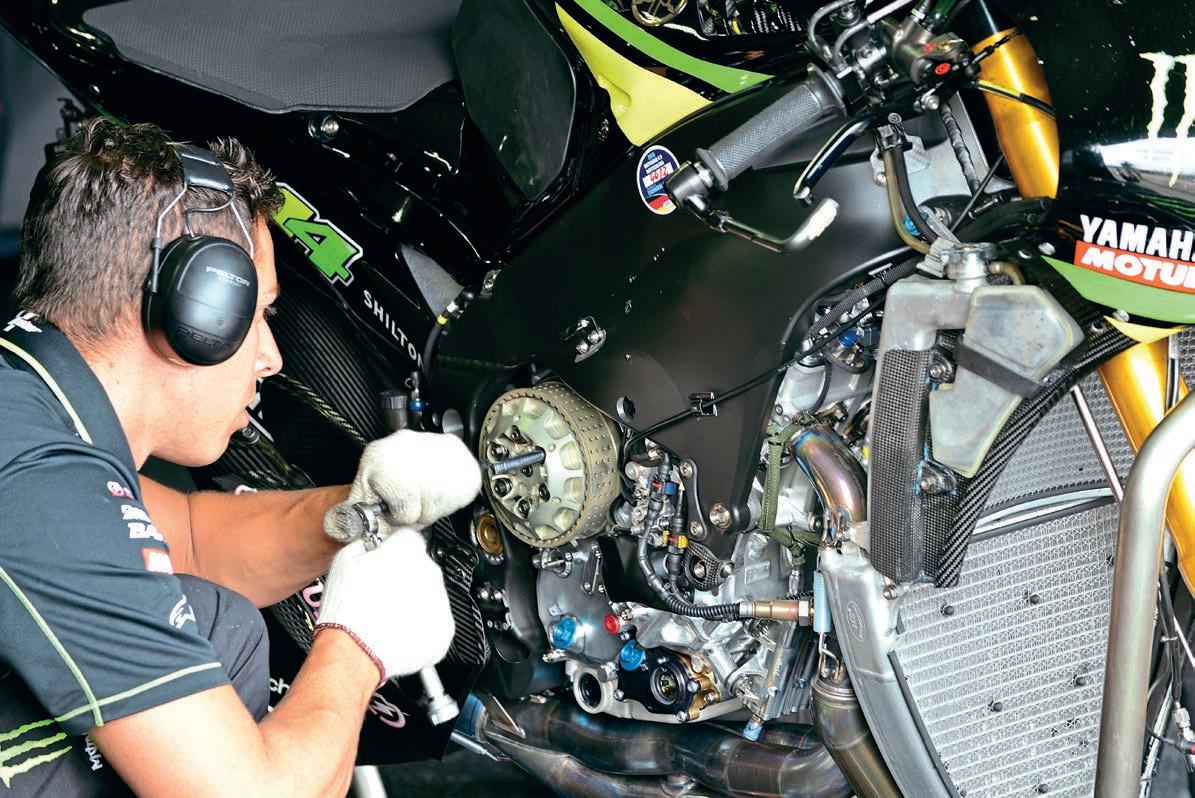
Supermono and I didn’t fancy the idea of some 250cc hot shot slamming it down through the gears and revving what was a very expensive motorcycle to oblivion. Our first attempt at Daytona didn’t really work; we took the clutch out before the race as it was rubbing its back plate against the inside of the basket once everything got hot.
On the second try, however, it worked really well. We put Callum Ramsay on the bike at Donington for a World Superbike support race and he lapped everyone up to third. We started recommending slipper clutches for our Ducati race and trackday customers after that.
“The big change came in late 2003 when the FIM opened up racing to aftermarket slipper clutches; then it turned into a proper business. We currently list clutches for nearly 90 different models of motorcycle. In the last few months, we have added Aprilia 660 and KTM890 clutches to the range at the new bike end of the scale and have added kits for the old Honda RVF400, Kawasaki ZXR400 and Gpz1100 Unitrak at the older end.
“Slowing a motorcycle down into a corner as always seemed quite simple: just hit the brakes and turn. But as the speeds and engine sizes have gone up, it’s become more and more difficult to control the bike’s reactions.
“As a bike comes into a corner, the rider is braking and changing down through the gears, and the reaction of the bike chassis is to pitch forwards, so loading up the front tyre, spreading out the front tyre contact patch and increasing grip, but also pulling the rear wheel off the ground. It doesn’t help that at the same time the rear wheel is trying to turn over the engine, and if that engine is a largercapacity four-stroke, the resulting efforts cause the rear wheel to hop and jump, destabilising the whole chassis and making the rider feel very insecure. As the rear wheel tries to speed up the crankshaft on a slipper clutch-equipped bike, the clutch is deliberately and automatically slipped. The clutch centre rises on ramps built in between the centre and the back of the clutch, ultimately poking off the pressure plate and allowing the clutch to slip. This reduces the engine braking sensation and minimises any over-revving, which, in turn, stabilises the rear of the chassis and allows the tyre to use all its available grip, preventing the bike from sliding out as the bike enters the corner.
“The slipper clutch came from racing. Kawasaki fitted a few to its mid-1990s

TECH SLIPPER CLUTCHES
84 JULY 2023 WWW.FASTBIKESMAG.COM

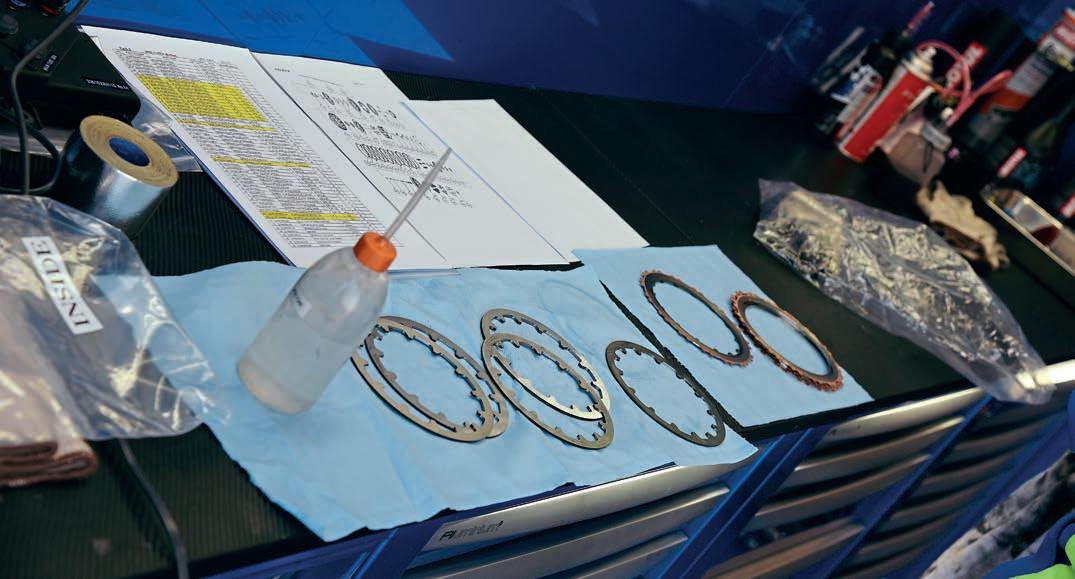


you don’t see from the outside...
anything, slipper clutches demand maintenance.
What
Like
WHAT THE TECH: SLIPPER CLUTCHES
“Look after
your clutch.”
JULY 2023 WWW.FASTBIKESMAG.COM 85
THE CLUTCH CENTRE RISES ON RAMPS BUILT IN BETWEEN THE CENTRE AND THE BACK OF THE CLUTCH.
bikes, but aftermarket ones were available from the late 1990s, initially just on Ducatis. As superbike racing rules changed and allowed bigger engines, slipper clutches were fitted to all the bikes. In 2003, the FIM allowed all Supersport race bikes to be equipped with aftermarket slipper clutches, too. It took a few years for production bikes to be equipped from standard, but by 2005/6, OEM slipper clutches had become a thing. Just like rear shocks though, the OEM slippers were built down to a price. If you wanted race-ready parts, however, the aftermarket items were capable of smoother operation and also of providing a more ‘track ready’ reaction. This was done with ball bearing-equipped ramps and different ramp angles.
“In more recent years, electronic throttles have allowed engine braking to be reduced by counterintuitively opening the throttle as the bike enters a corner. Theoretically, a well set-up throttle system can take into account engine rpm, bike speed, what gear the bike is in and, if it has enough data, which corner of the circuit the bike is on. If all that data is



TECH SLIPPER CLUTCHES
86 JULY 2023 WWW.FASTBIKESMAG.COM
Dry clutches require more maintenance but are quicker and easier to work on.
Praying to the god of slip...
available, it means the throttle control system can be somewhat more flexible than a simple mechanical slipper clutch; in the perfect world, a race bike will have both.

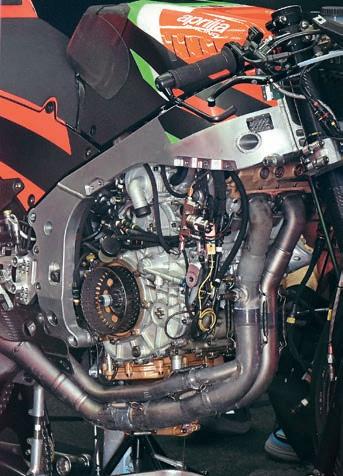
“In current racing, you must have some help getting into the corner, especially with a bigger or high compression four-stroke. If your bike doesn’t have a slipper clutch of any sort, then a good but still basic slipper clutch will make a massive difference. That includes pretty much any bike made before 2005/06. On later bikes that have early versions of ride by wire, aftermarket clutches will improve matters greatly; Yamaha’s R6 is a good example. If you are racing more modern but less expensive bikes like Triumph’s 765, the 660 Aprilia and others in that class, then a

higher quality aftermarket ‘slipper only’ clutch will still give a noticeable improvement in chassis stability on corner entry.
“If, however, your bike is a modern 1000cc (or bigger!) ‘race replica’ and has finely tuned electronic throttles that work in conjunction with the bike’s ‘standard fit’ slipper clutch, it isn’t easy to improve on that set-up. The ECU’s mapping will be based on the way the standard clutch works, faults and all – timing is everything, from the way the clutch slips to the way it re-engages. You can still use an aftermarket slipper, but it will only work well if it is working in exactly the same way as the standard one, which slightly misses the point of having one. If, however, you can reprogram your ECU, you have
JULY 2023 WWW.FASTBIKESMAG.COM 87
Plates… but not the ones you’d eat off.
Ready for reassembly.
Dry clutches are much more common on pukka race bikes.
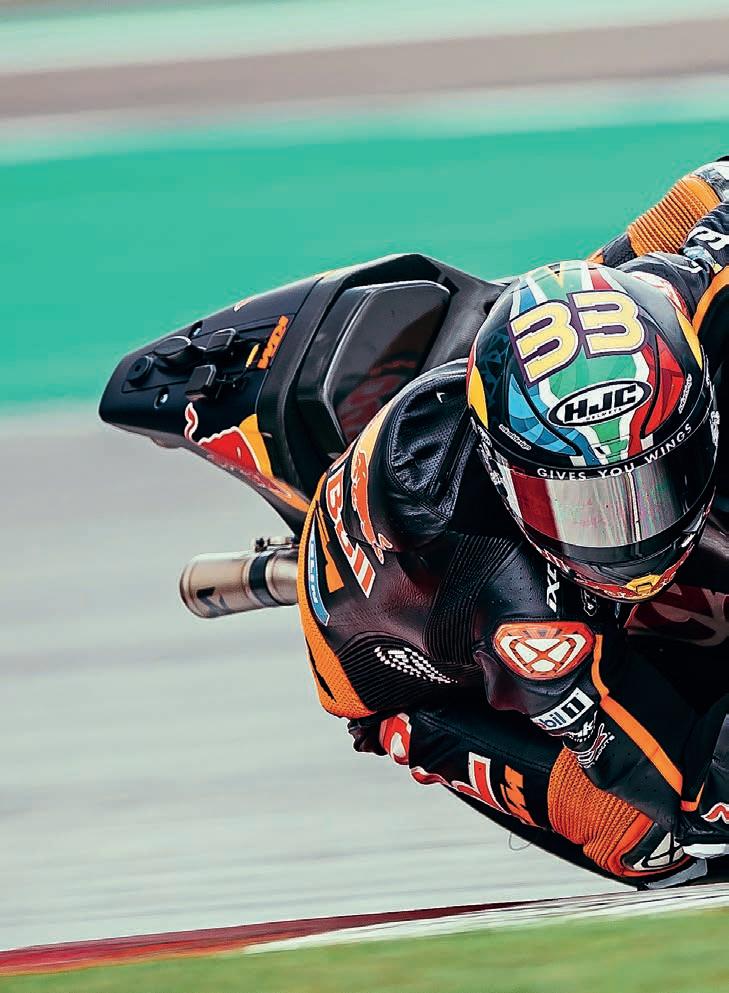
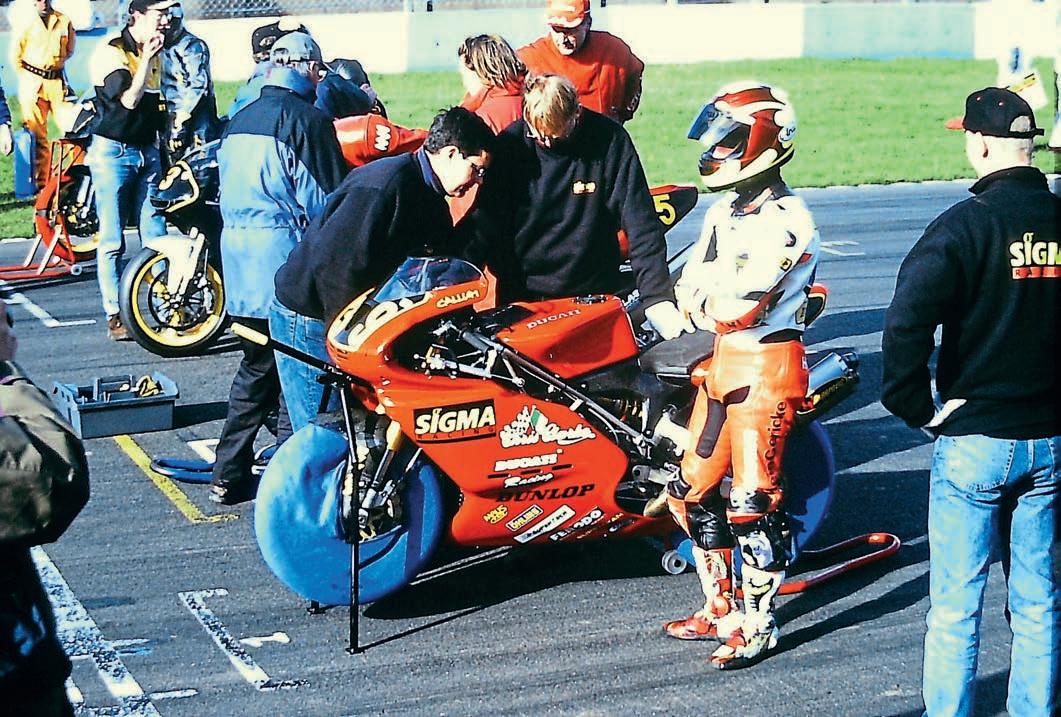
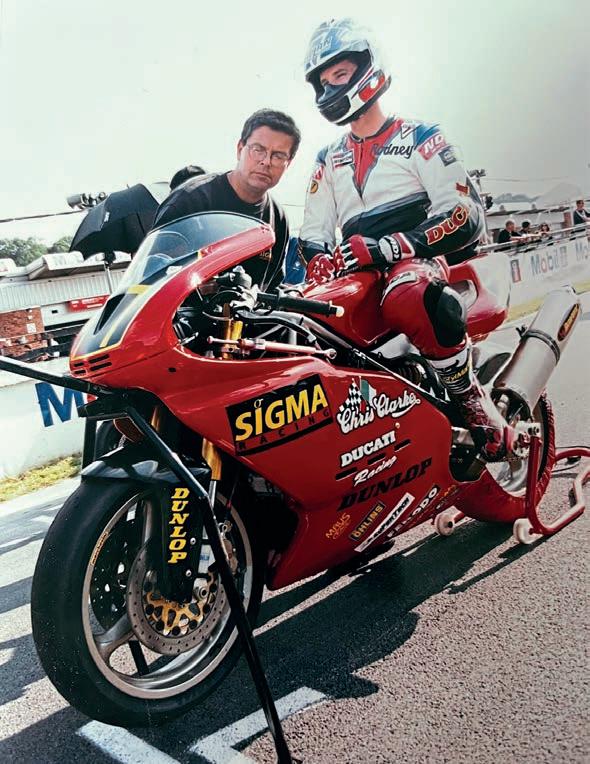
TECH SLIPPER CLUTCHES
Back in the day, when Sigma was starting out in the field.
more choices. Slipper clutches continue to play an important part of the corner entry process. They provide a ‘fuzzy logic’ for situations that aren’t perfectly programmed in to the ECU. Properly set up, they will allow a smoother entry to the apex than would otherwise be the case. They also continue to help prevent over-revving. But, if you are introducing a non-standard slipper clutch into a complex electronics package, then you must be able to reprogram the ECU to suit. For that reason, MotoGP teams and Moto2 teams have an engineer whose sole job all weekend is to make the slipper clutch and the ‘corner entry control’ part of the throttle system work seamlessly together in each corner. This is particularly true if you want to leave the clutch lever untouched once you’ve started the race; correct set-up matters.”
While I’ve got Neil on the subject of clutches, I decide to pick his brain on dry clutches versus wet clutches, and if my own understanding of the benefits is based on fact or folklore.
“If you look at the MotoGP grid, you will notice most of the bikes use dry clutches –to be specific, 48-tooth slipper clutches. These are great if you want to save a couple of horsepower because they are not inside the crankcases and so are not caught by the rules regarding ‘sealed engines’. From a technical standpoint, they also cannot suffer from windage, the power loss caused by

swirling oil around.
“Equally, they don’t benefit from the cooling and lubrication that benefits an oil-cooled clutch. It is much easier to make an oil-cooled clutch operate smoothly, and they need far less regular maintenance.
“A good example is the wear rates seen on friction surfaces. We have noted that soaking new friction plates in fresh engine oil for 24 hours prior to use reduces wear. Most top race teams that are using wet clutches will store at least one spare set of friction plates in an oil-filled container, ready for use.
“Dry clutches aren’t easy to live with without constant maintenance, but being outside the engine, it is easier to work on them, but you have to.
“In the road bike world, Ducati’s had dry clutches for many years. They were not very easy to live with and they were capable of making a lot of noise. Using a 48-tooth set-up and the right pack design can make these clutches far easier to work with.
“Most slipper clutch manufacturers now offer one version or another to combine the benefits of a slipper clutch with a quieter and easier to live with 48-tooth conversion.”
The humble clutch has a hard life. It’s got to cope with getaways, positive torque, negative torque, be reliable, and last for thousands of miles. It’s also got to be one of the things on the bike that you pretty much never notice, making it one of the many unsung heroes that can make the difference
between an enjoyable ride or fast lap time by being invisible. Setting aside the recent advances in electronic engine braking management, there’s no question that if you’ve got a bike especially without a slipper clutch fitted, or even if it does have one, it’s a bike that’s been built to a price and the performance gains a good slipper clutch can make are massive.
So much of setting a bike up for a corner smoothly and precisely is down to how the reverse torque that comes from a shut throttle gets managed.
If you are crisis-managing an unstable bike, while at the same time trying to get it to turn in to an optimum line and apex, it doesn’t matter who you are, or how much grip or power you’ve got, you’re playing catch-up and are compromised.
In the old days, during the braking phase and corner entry, if you got it right, you could actually use the slow release of the clutch lever after a series of backshifts as a third brake lever. Get it right and you could introduce some more braking power to the overall process... but it was a very fine line between that and chaos.
Next time you put your modern bike in gear and release the clutch leaver or enjoy a flurry of backshifts under heavy braking, spare a thought for what’s happening at the other end of that cable. The slipper clutch in your bike is working overtime to keep you on the straight and narrow.
JULY 2023 WWW.FASTBIKESMAG.COM 89
stars
Interviews with Kawasaki factory BSB racers in Fast Bikes are a bit like buses. None for ages – then you get two at once… Last month we spoke to Max Cook, the new rider for the Cheshire Mouldings team about his career so far and his relationship with SHARK. And this month we’re doing the same with Lee Jackson, the senior rider in the Kawasaki UK-backed team (Team Green completists can also read about Jackson’s ZX-10R race bike on the Addiction pages this month).
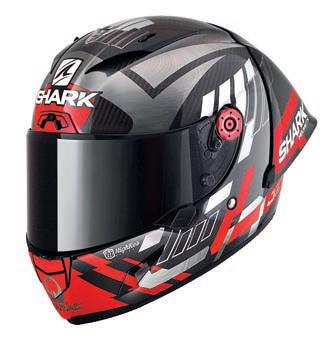
We say ‘senior’, but Jackson is actually just 27 years old. His seniority comes from an almostprecocious rise to the BSB paddock: he was racing in the British 125 championship/ACU Academy Cup back in 2010 aged just 14, moving to Superstock 600 two years later and taking the title in 2012. He then moved up to Superstock 1000, before bagging a Superbike ride with Buildbase BMW alongside Ryuichi Kiyonari in 2015, moving on to the Smiths BMW team in 2017 as Peter Hickman’s teammate, before dropping back down to Superstock 1000 again in 2018. A third place finish in the 2019 title chase then saw him back on a Superbike for 2020 with the FS-3 Kawasaki team, where he’s been ever since. In the 2022 BSB season, Lee achieved eight podiums in total - two of which he was stood on the top step.
An impressive career so far then – but how did Jackson get into racing? As is often the case,


family was key: both his dad, Gary Jackson, and uncle, Lee Jackson, had raced at a high level in the UK. And that meant he started out on Tarmac rather than dirt. “I never really got into motocross racing. One of my best friends at school, his dad imported pit bikes and from that I grew up riding pit bikes and supermoto. So that was my main start in racing; pit bikes with my dad and uncle. I got into a championship called Phoenix Racing in 2006, and that was it.”
There is an impression, though, that Jackson’s meteoric rise might have been a bit of a double-edged sword. “Yeah, my first years of Superbike, I would say they were probably not the best because the progression was so quick and I went up so soon. I would say that compared to other riders, I’m maybe not as naturally talented on a bike, so I have to work at it! And the time I got on a Superbike it maybe happened a bit quick so the progression took a bit longer than some people.”
That move back to Superstock seems to have paid off then, giving him more of a chance to work on big bike racing again at a slightly less intense level, before returning with a bang on the Kawasaki superbike. Did he find a big difference between the ZX-10R and the BMWs he’d ridden before? “Yes I would say back in 2016, the Buildbase BMW
Lee rides in the Race R Pro GP FIM, which has been developed using computerised simulations and wind tunnel-tested to meet the demands of all racers. Prices start from £999.99 for Race R Pro GP FIM and Race R Pro GP 06.
Lee Jackson 90 JULY 2023 WWW.FASTBIKESMAG.COM
was more based around a Superstock bike, with the chassis and swinging arm. I thought it was a great bike, but it just didn’t have the full Superbike spec. Then in 2017 I went on to Smiths BMW which was a lot more Superbike spec and at the time it wasn’t really my favourite it was really stiff and rigid. Coming back to Superbike on the Kawasaki though, it works within more of a bigger window, it seems to be a slightly easier bike to get on with.”
One other constant – apart from his family backing – has been SHARK. Jackson has worn the French lid brand for his entire career, apart from the one season in British Superteens/125s where Nitro was the contracted headgear supplier. Even then though, he wore SHARK’s helmets when testing…
Again, that relationship came through his family Roots. “My knowledge of SHARK came through my uncle as he knew - and worked with - [SHARK Racing and Technical Manager] Mark Eilledge. I wear the SHARK Race R Pro GP FIM and love it. I wouldn’t fancy wearing anything else, I’ve never been offered another deal and I wouldn’t go looking for one either. It’s not just the product either, I’ve learned a lot over the years from Mark.”
This year’s BSB season has started off a little slowly for Jackson, with 14th, 10th and
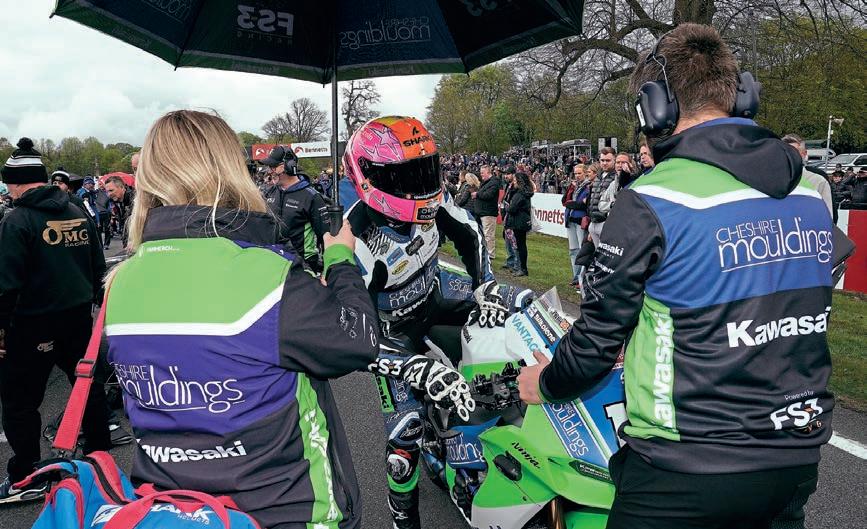



round. Round two at Oulton showed solid improvement though, with a 10th and two 8th placed spots – but Jackson is ready to put that behind him. “It’s been a bit of a tough start with a few components on the bike. I don’t think my season is fully written off yet, we still have a lot to work on and a lot to get going. I’m looking forward to round three and chipping away at the title fight.”
WORDS: SIR ALAN OF DOWDS
PICS: IMPACT IMAGES/TIM KEETON
GUEST WHO?
We’ve teamed up with SHARK helmets to bring you tales from some of the world’s top motorcyclists. Grab a brew, sit back, and enjoy what they’ve got to offer.
JULY 2023 WWW.FASTBIKESMAG.COM 91
ALPINESTARS SUPERTECH R
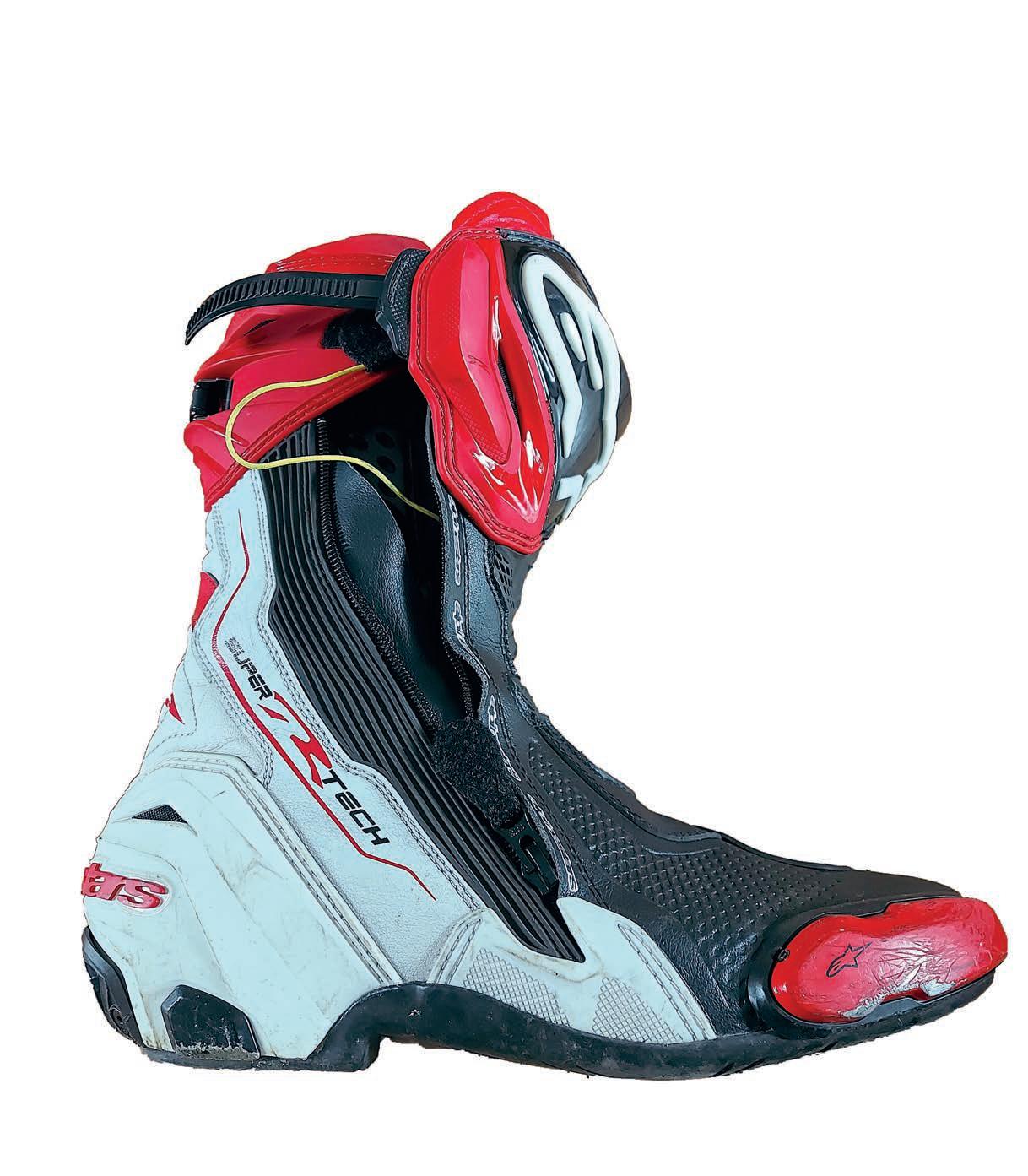
My very first pair of boots were Alpinestars SMX plus, back in 2003. They were second-hand, but they were awesome and I’ve still got them. As great as they were, they appear farcical when compared to the same brand’s latest top-spec option, the Supertech R. A lot can happen in 20 years, especially so when it comes to design, quality and features on a sports boot. I’ve been wearing this particular pair of Supertech Rs for just over a year, which is around about the time when this latest iteration arrived on the market. I can’t say they are a million miles different from the version that came before them, but that’s not such a bad thing – think evolution over revolution. What you need to know is they are now a little bit more comfortable and offer improved protection and venting. There are also subtle changes to the inner booty, including an easier to access pull-tab at the back and

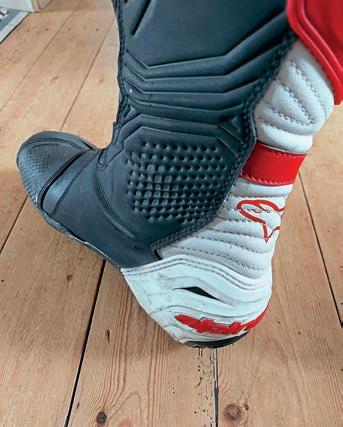
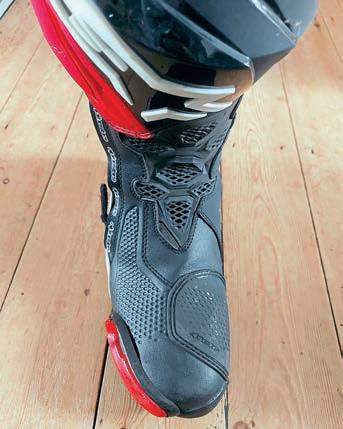
FEATURE THE VERY BEST KIT – USED, ABUSED AND REVIEWED
92 JULY 2023 WWW.FASTBIKESMAG.COM
improved mesh venting. While not every sports boot has an inner booty, I really like the feature, especially because it means you can whip the inner out and chuck it in the wash if your feet have had a bit of a sweat on. The inner shoe is actually where you’ll find much of the protection on the Supertech Rs, including sturdy polycarbonate molded supports that reduce lateral movement in the event of an accident. In my opinion, the boots allows for just enough range, leaving you feeling safe at the same time. As safe as they are, there’s also a major focus on comfort; these are super comfy, really easy to slide on, and the drawstring adjuster means you can custom-fit the booty to your foot and shin area.
The external boot looks fantastic and offers loads of considered protection zones. It is largely constructed from microfibre, supported by key areas of plastic reinforcement, with detachable toe and heel sliders. There’s an asymmetric zipper on the outside of the boots, plus a ratchet adjuster at the top to reassure you that there’s no chance the boot could split open in a crash. It also means you can get a really close fit of the closure around your shin.

In terms of airflow, my boots are the non-vented option, but there’s still plenty of air allowed in via the rubbered mesh area on the front of the foot. Whatever the weather, and even when it’s raining, these boots have kept me dry, cool and comfy. They don’t squeak, either, which is another bonus, and though they’re pitched as a pukka race boot, they are extremely versatile and pair nicely with pretty much any motorcycle you hop on. They are the most comfy boots on the market by far, but also offer a premium level of protection for the user.
I trust them, which I can’t say about all sports boots, and I admire them for being so hardwearing. I must have clocked 10,000 miles and they are still looking and feeling great. Maybe a clean wouldn’t do them any harm, but they are otherwise good for another 10,000 miles. No, they’re not cheap, but to me, they represent true value for money, ticking all the boxes and then some. Whether you’re a weekend scratcher, prolific tourer, or just want a decent pair of boots that’ll keep you comfy all day long, these would be my recommendation.


TRIED OUT
Tim Neave
Iam two rounds deep into the British Superbike championship and I wouldn’t be lying if I said it’s been an eye-opener. In my last column, just before the UK testing started, I talked about how I had hoped for four days of dry practice on my new superbike, to get comfortable and get the job underway.


Well, I don’t know who ordered the bad weather, but that’s all we got! In two days at Donington Park, I did a grand total of five laps, all on wets and below half throttle. We checked the bike actually ran, checked the
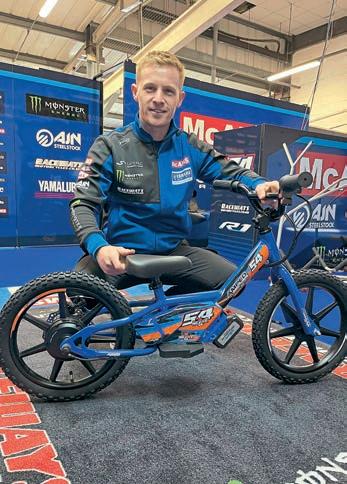

electronics out and bedded in some new Brembo discs… nice. A couple of days later, we headed to Silverstone for the second testing event. This time we were treated to two days of heavier rain with added strong winds, but with only one week to the first round (at Silverstone), we figured we’d best just get on with it. I must say, I really enjoyed riding my new R1 superbike in the wet, and the team gave me a great set-up that allowed me to chip away nicely and I ended up about ninth overall in the wet, so I was pretty chuffed with that.
At round one, we finally had some dry weather, and free practice was of course my first dry laps on the bike. Naturally, things did take some adjusting to, but as the weekend developed, I improved and we ended on a real high with a massively reduced gap to the front, a strong PB lap time and two point-scoring finishes.
Next up was the two-day Oulton Park test and guess what, the first day was a write-off thanks to torrential rain. It was dry the following day, but conditions were far from ideal, with very strong winds. In fact, on my out lap, the wind took hold of my front wheel over one of the crests, and as the wheel touched back down, it completely tucked and I nearly went down. I came straight into the pits thinking I had a binding front brake, but that wasn’t the case. I had these moments all day, which didn’t do my confidence any favours. In a final push to improve my lap time (which was not coming easily at all), I went into turn one a little hot, a little off line, and bam, I was stuck under the air fence before I could say ‘shit’. Anyone who knows Oulton Park will know that turn one is the last place you want to crash – and it hurt, let me tell you. After a couple of hours in Stoke hospital, I was released with nothing more than bruising to my left lung and I thought, ‘I’ll take that any day for a T1 crash at Oulton!’
With a couple of weeks off before the second race weekend, I thought I’d take up the kind offer of a day’s simulated clay shooting with the Edwards 1902 crew. It’s safe to say I’ve lost my touch since my days of shooting around the farm as a young lad, but it was an absolute blast... right up until I took a clay to the face! It’s a wonder it didn’t have my bloody eye out, but it seemed I’d got lucky... or unlucky, depending on how
COLUMNIST
That’s one way of staying warm. He’ll grow into it.
94 JULY 2023 WWW.FASTBIKESMAG.COM
you look at it, once again. Thankfully, the black eye settled before I headed to Oulton Park round two, and with a fresh mindset, I was ready to get stuck in.
Once again, mixed weather put a stop to my dry time progression in the first part of the weekend, but with my good feeling in the wet, I made it through to Q2 for the first time and then qualified 10th, which I was buzzing about. All three races were dry, and as good as that was, the pace wasn’t there and it wasn’t coming easy. It took until the last race on the Sunday to get a new PB lap time, but at least it came and I walked away with some
positives to hold onto ahead of our next visit there later in the year. Oulton has always been a tricky one for me, but God loves a trier, so that’s what I’m gonna keep doing.
We’ve had a three-week break since Oulton and I thought I’d best fill my time wisely – one of those things being the Lincoln GP Sportive, my first 100-mile bike ride (103 in total). That was a real challenge, but so rewarding. I did it with Brucey Boy, and he proved to be a bit of a dark horse on the old push rod, but we both still got smoked

by my old mate Steady... he’s not so steady on a push bike, much to my dismay!

I also managed to get out on a No Limits trackday at Donington and I’m so pleased to report that the new surface is absolutely mega – exactly what the place needed.
Donington Park is a favourite of mine and I won the Superstock race there last year, so as I write, I’m looking forward to seeing what I can do on the superbike this weekend. The race will have been and gone by the time you’re reading this, so here’s to a good one. Hopefully, Tom can tell you about me beating him in his column this time next month. Ciao for now!


THE TIM AND TOM SHOW NEAVE
RACING
TWIN
Tim and Tom, scrapping it out.
Timmy’s been getting to grips with the superbike.
Miles of agony... and that was just having to listen to Bruce.
JULY 2023 WWW.FASTBIKESMAG.COM 95
Christian Iddon

It’s not often I’m left alone to fend for myself looking after our little Toby, but the other Saturday I was, so I thought what could an eight-month-old baby want any more than an absolute marathon session of bikes on the box? MXGP, NW200, MotoGP and the Speedway grand prix were all set for our viewing pleasure. Turns out he did quite enjoy it, as long as between races he got his dose of Hey Duggee and Bluey, but the one event Daddy (me) was most glued to was the North West 200. Road racing has always been of keen interest to me, and when the sun is shining over the coast road between the scenic and quite frankly stunning backdrop of Portrush and Portstewart and I’m watching some of the guys I race with week in, week out flying past the scores of adoring fans, then I can’t help but get FOMO (should be AMO – Actual Missing Out).
Doing the roads has always interested me. Sure, I might not actually like it when (if) I did it, as it’s not for everyone and that’s absolutely fine, but it’s always been there, niggling in my mind, and attending plenty of road races as a spectator has only heightened that ‘want’ to compete. For me, it’s just that the opportunity and timing has never happened. My grandparents were always so against me doing it, so as harsh as this may sound, I figured I would just wait until they were no longer with us and then get my entries in. What I hadn’t banked on was
having my little Saturday afternoon racing viewing partner come along when he did, and having Toby makes the question of doing – or not doing – the roads all the more difficult.
Having children hasn’t dented the speed of some of the top racers at the North West this year. In actual fact, you are statistically better off having children than not. Irwin, Seeley, Cooper, Harrison, Johnston, Hillier and so on are all family men and the likes of Hicky and Davy might have a few nippers they don’t know about (jokes), but I guess the difference here is that they were all doing the roads before having rugrats, so as much as I have an itch, I think I’m going to have to leave it. Trouble is, the more you try to ignore the itch, the more you want to scratch it!

BSB life still hasn’t been plain sailing for me, but we are making massive strides with the bike. As it stands, I’m the only Ducatimounted jockey not to have won a race or even taken a podium, and at the current pace, we are still a fair way from it and a long way from where we expect to be, but the gap to first is reducing rapidly, so hopefully sooner rather than later I’ll be back where I need to be.
Outside of racing, things have been pretty steady. Once the season gets going, any extra-curricular activities are a bit harder to squeeze in, but I have just paid for a new road bicycle, which is a big passion of mine,
so I’m super excited for hours and hours of chatting to myself (I always ride alone) and getting numb bollocks taking in the Northumberland scenery.
As I have been taking in that scenery, I’ve been having a look at some of the pretty amazing houses up this way. It’s a new thing I’ve been doing and it all started about a month ago when a friend of my wife sent a link to a house for sale with a bit of land. Having land has always been a dream of mine because – naturally – I want a motocross track for myself and now a little Revvi track for Toby.
The only problem was that the house she sent us was £675,000. “We definitely can’t afford that,” I said, and so that was that. And then, not even a week later, there I was at work when a link gets sent through for an even bigger house with even more land for just shy of a million. Isn’t it amazing how a woman’s mind works!
Anyway, it’s made me start to dream, and as I pedal along, I check all the houses and how big their fields are while trying to work out how many races I need to win to get a bonus cheque big enough to own one. As it turns out, my maths skills don’t go that high, so I just figure that it’s an awful lot... so I guess I’d better make a start. A man can dream. I’ll have a motocross track one day, but until then I have an itch to scratch... sadly, this time it’s just my numb nuts.
COLUMNIST
Iddon found better form at Oulton.
96 JULY 2023 WWW.FASTBIKESMAG.COM
OXFORD PRODUCTS MOTO-RAPIDO BRITISH SUPERBIKES


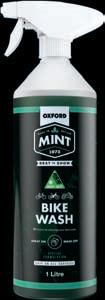






PICS: TIM KEETON/IMPACT IMAGES
JULY 2023 WWW.FASTBIKESMAG.COM 97
DOING THE ROADS HAS ALWAYS INTERESTED ME.
Steve Parrish

I’m fresh back from Northern Ireland after spending the week commentating at the North West 200, and I think we are all ready for a break. It was a strange old week, and despite dodging the bad weather for the most part (which is always a miracle at this event), things didn’t go half as smoothly as we’d all liked – for vastly different reasons.
First of all, riders were dropping like flies, even the front-runners, and we saw more crashes than in recent years, but I can say now with elated breath that there were no fatalities, thank goodness. We had red flags for Michael Sweeney, Nathan Harrison, Mike Brown and James Hillier, to name a few, but I think it’s fair to say that Lee Johnston came off worst – he was airlifted to hospital for urgent care. I hope he doesn’t mind me saying this, but he got pretty knocked up and broke his femur, shoulder and numerous ribs, and suffered a collapsed lung and breaks in his foot and face. Lee is a gritty little fella, so I hope you join me in wishing him a full and speedy recovery.
Secondly, the controversy surrounding the FHO BMW disqualification certainly won’t be brushed under the carpet anytime soon and has left a horrible taste in the mouths of many.

If you don’t know what I’m talking about, Faye Ho’s BMW team took part in the Superstock practice and qualifying sessions before being disqualified and removed from the grid just 30 minutes before the race started due to carbon wheels, which don’t meet NW200 superstock regulations.
The thing is, the BMW M1000 RR comes out of the showroom with carbon wheels fitted, the team have used them at this event previously, and these wheels are fully eligible for the upcoming Isle of Man TT. Why wasn’t this picked up in scrutineering, and why were riders Josh Brookes and Pete Hickman allowed to qualify? It makes you wonder if somebody has been stirring the pot? I don’t know the answers; maybe the rules need updating. But with two of the fastest front-runners, I can’t help feeling that this ‘infringement’ could have been handled much better.
In protest at the decision, Faye decided to pull all of her bikes from the event, meaning Pete nor Josh got to ride in the Superstock or Superbike races, and she has pledged to never attend the event again… I’d say that was a huge loss to the NW200.
Anyway, that’s enough of the negative stuff. I must mention the Supersport racing, which was absolutely incredible in both races. I’ve not been so excited about a road race in a long time – it was edge-of-the-seat stuff. Hats off to Davey Todd and the Padgett’s boys for doing a flawless job; it’s only a matter to time before Davey wins the Superbike races, I feel, and with the TT looming, it could be sooner than we think!
On the MotoGP front, it was another crash fest at Le Mans. I think we could see another year like when Joan Mir took the title; he who stays on might just get the job done this season. It was great to see Sam Lowes take another pole position after the clean sweep at Jerez, but it was short-lived after a crash in the race – and what a crash it was... it didn’t look like he did much wrong at all.
Marquez was back and doing a mega job until he crashed out of the long race; everyone is just so on the limit and it seems they’re just half a percent away from crashing all the time. I think if he got his hands on a KTM or Ducati, you wouldn’t see which way he went.
In other news, I’ve been bitting and bobbing and still doing the odd chat show. I was at Brayley Honda the other night, at a Honda dealer event, and I was joined by the Honda UK team riders, which was good fun. Next up I’ve got the Wray bike night, which is up near the Lake District. I’ve never been before but apparently it’s is a big event and gets huge turnouts every time, so hopefully I’ll see a few of you guys up there.

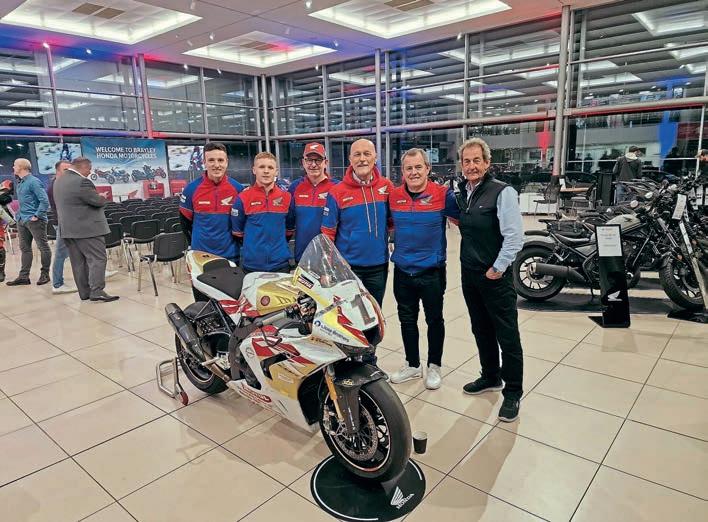
I suppose the next big one for me is the TT, which soon comes around. I’m over for the full two weeks and will spend most of my time at the Ginger Hall with Glenn Irwin. We are hosting a chat show for guests and doing bus tours around the circuit, so I expect that’ll be lively.


Anyhow, that’s enough from me and I look forward to catching up next month with a load more road racing chat. Cheers.

EX-RACER & TEAM MANAGER RACE
COLUMNIST
INSIDER
98 JULY 2023 WWW.FASTBIKESMAG.COM
He’s not lost his bottle.
He returned it safely.
Above: Out and about with the Honda boys...
Right: His master’s voice.
Left: Pop along for the craic.






















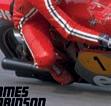
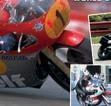











































































































































































































































































































































































































































































































 Bruce
Bruce
 John Cotterell, Portland, Dorset
John Cotterell, Portland, Dorset












































































































